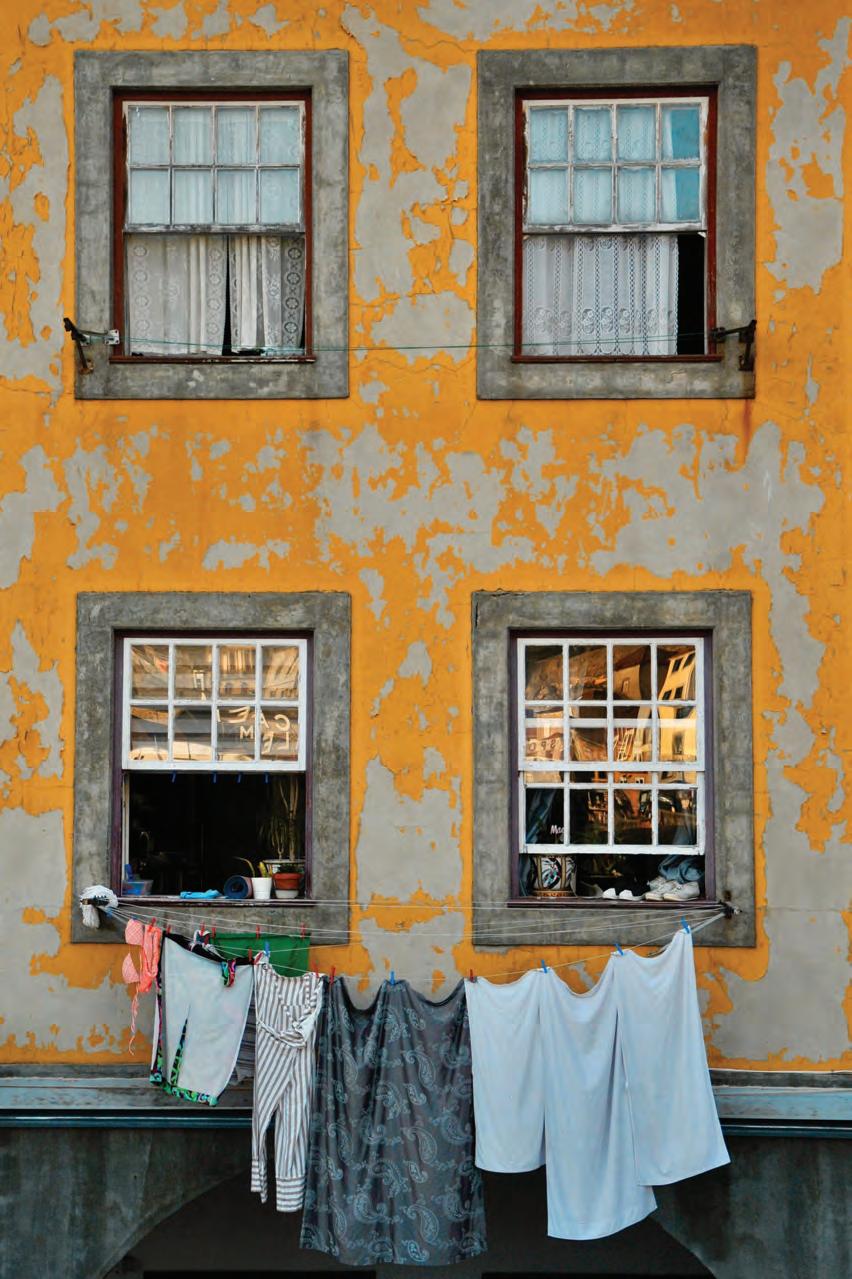
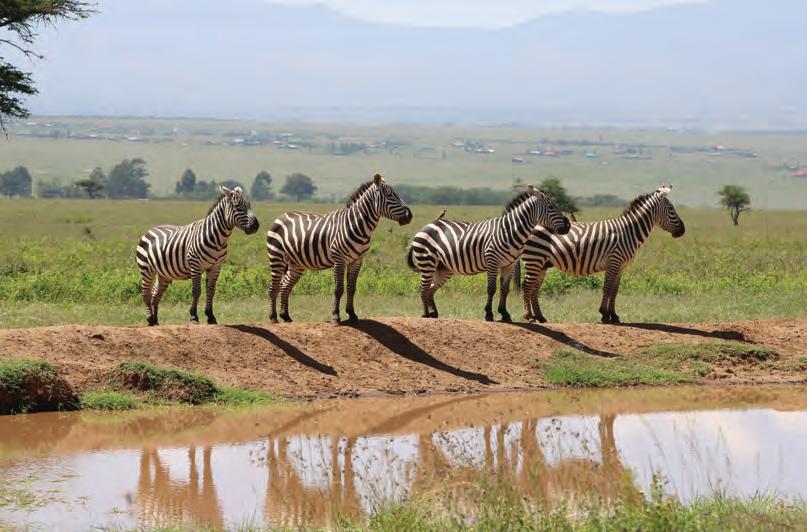

17
Aleph: a journal
perspectives
The
of global
a journal of global perspectives
global edUCaTion
Aleph The 17 The hobarT and William SmiTh CollegeS and Union College ParTnerShiP for
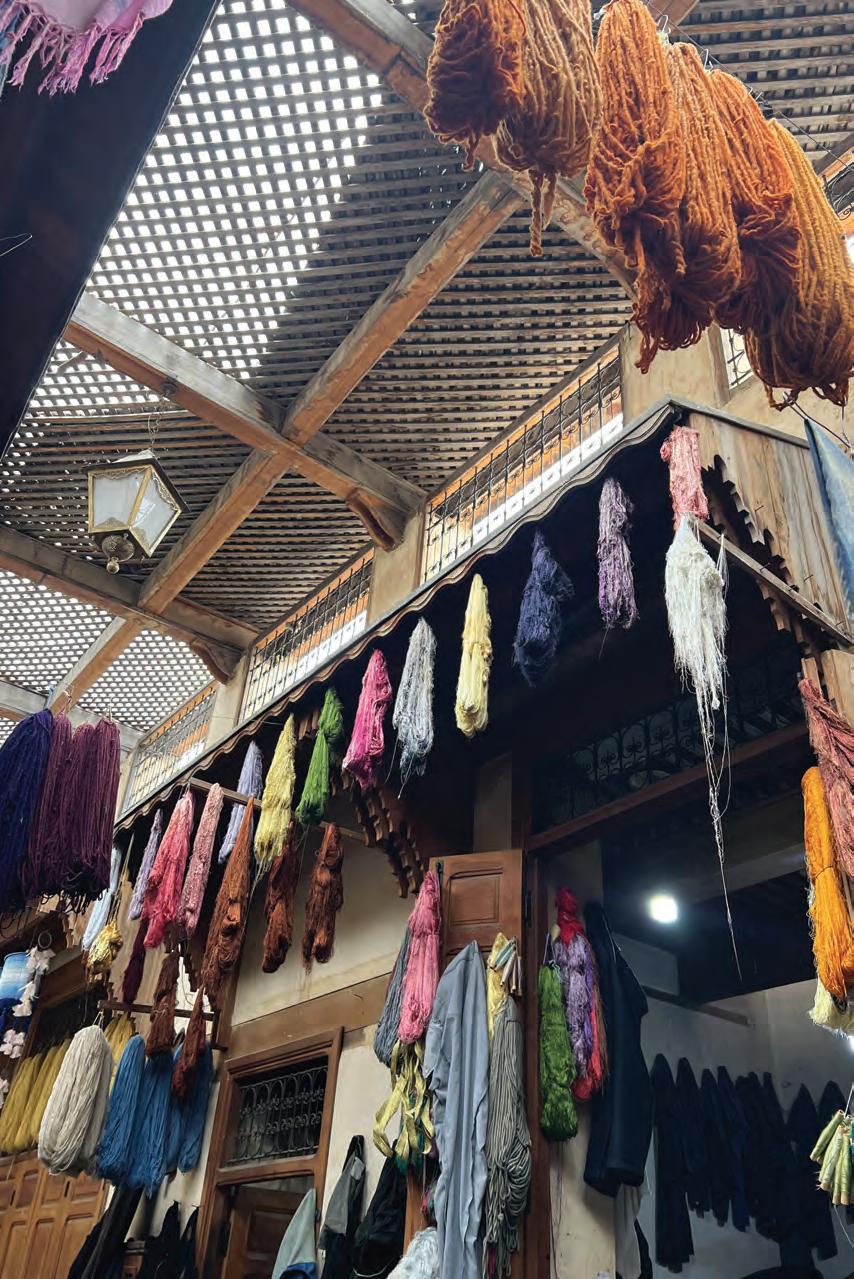
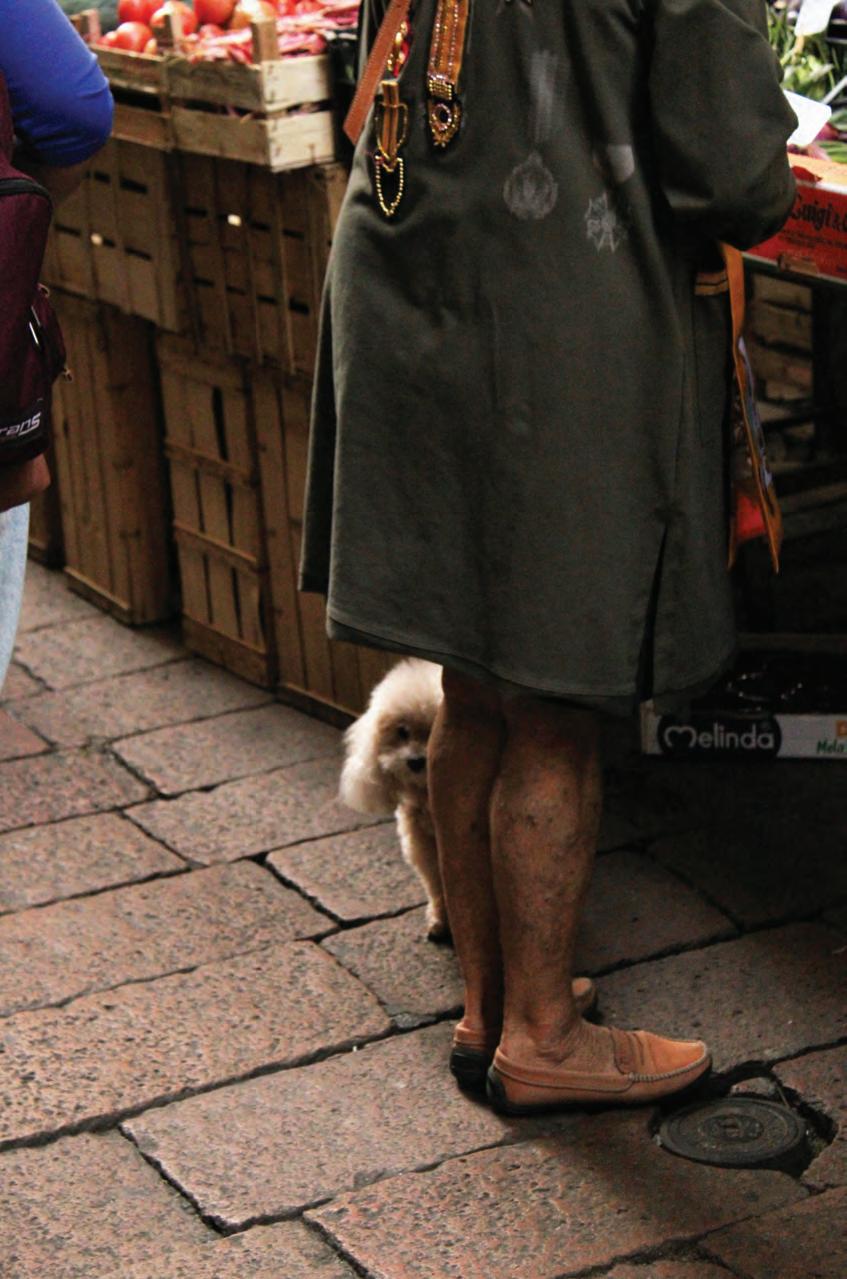
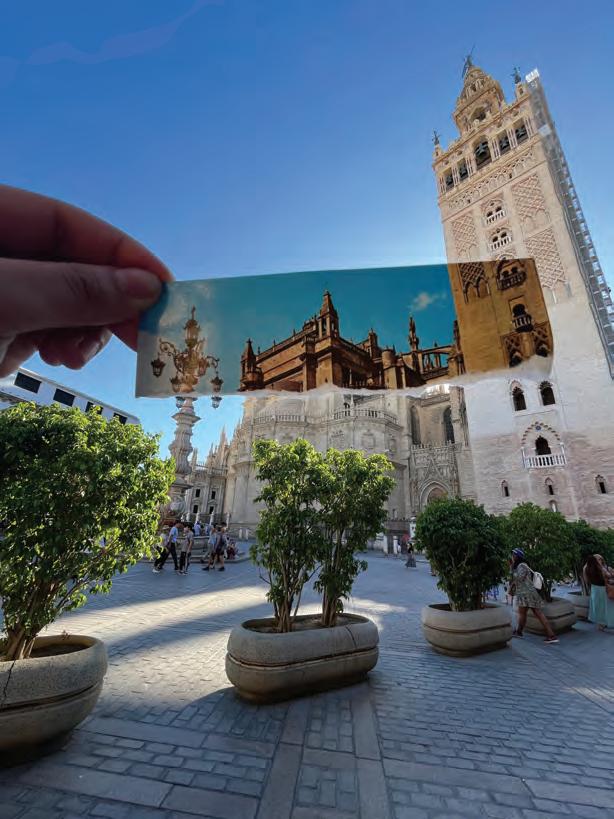
The
Aleph a journal of global perspectives
Volume XVII, 2024
Sevilla in Print and in Person, Seville, Spain [Thao Bui]
The Aleph: a journal of global perspectives
Volume XVII, 2024
Thomas D’Agostino, Editor
Hannah Mathews, Artistic Director
Annette Stephens, Assistant Editor
ISSN 1937-0474
Stories in The Aleph are set in Gentium, designed by Victor Gaultney and adopted by SIL International, an organization working to document thousands of dying ethnic languages, many of which are written in modified Latin scripts. Most digital fonts do not include these extended alphabets and therefore millions of people are shut out of the publishing community. Gentium is an attempt to meet this challenge. The name is Latin for belonging to the nations.
© 2024 Hobart and William Smith Colleges and Union College Partnership for Global Education
Thomas D’Agostino, Executive Director
Trinity Hall, 3rd Floor
Hobart and William Smith Colleges
Geneva, New York 14456 (315) 781-3307
Cover Photo Credits:
Front Cover: Morning at the Pond, Lake Nakuru National Park, Nakuru, Kenya [Mary Baillos], Students Enjoying the View, Ronda, Spain [Paulina Tejada]
Inside Front Cover: Dyed Wool Hanging in a Market in Fes [Isabella Renzi]
Inside Back Cover: Dog Peaks Out, Bologna, Italy [Ryan Brady]
Back Cover: Front Façade, Oporto, Portugal [Alberto García de la Puente Stanley]
About the Aleph
The first edition of The Aleph: a journal of global perspectives was published in 2002 as part of the Partnership for Global Education initiative between Hobart and William Smith Colleges and Union College. Since its inception, the journal has served to reflect the wealth of international experience among students at our respective institutions, and we are pleased to have extended this opportunity to students across the New York Six Liberal Arts Consortium.
The journal takes its name from the 1945 short story “The Aleph” by Argentine writer Jorge Luis Borges. In the story, the narrator (a writer) comes upon “a small iridescent sphere of almost unbearable brilliance” in which “without admixture or confusion, all the places of the world, seen from every angle, coexist.” Through this encounter with the mystical Aleph, he is able to see all things from all perspectives – yet he despairs of the daunting task of trying to convey the enormity of this experience to his readers.
Our students face much the same challenge when they return from abroad: after crossing borders and cultures, navigating societies different from their own in which they are exposed to new values and perspectives, how can they make sense of it all? How can they adequately convey the significance of the experience to those who did not share it?
The Aleph: a journal of global perspectives was created to address this dilemma. It provides a space for reflection, analysis, and dialogue that benefits contributors and readers alike. The pieces, both written and visual, offer insight into what captivates, challenges, and inspires our students – and through these words and images we learn about the people and places they encounter, we see how they change along the way, and we are exposed to “all the places of the world, seen from every angle.”
Table of Contents
ENGAGEMENT (p. 6)
I. Partys, Messen, und Stadtfest (Will Russell) II. Celebrating Women and Soccer in Berlin (Emma Kirts) III. Flamenco and Open-Mindedness (Isabella Renzi) IV. SC Freiburg Football Club (Tarang Malhotra)
CONNECTIONS (p. 22)
I. Temporary Regular (Brenda Plascencia) II. Lisbon Love: Reflection on Friendships While Abroad (Elisa Ribordy)
III. Eine Kleine Reise Nach München mit IES (Ian Moon)
CROSSINGS (p. 36)
I. Fruitless Attempts at Understanding Home (Annette Stephens)
II. Into New Worlds: Recounting the Tongariro Crossing with a Maōri Leader (Maddi Meyer) III. My Emily Brontë (Katelyn Weeks)
FROM MY SKETCHBOOK I (p. 61) (Alberto García de la Puente Stanley)
LESSONS (p. 64)
I. The Blasket Islands: Lessons in Isolation (Ella Weiss) II. Messing in the Mensa (Will Russell) III. Can We Travel the World Through Just a Bottle of Wine? (Heather Kerns)
REFLECTIONS (p. 80)
I. My Love Letter to Seville (Isabella Renzi) II. The Humboldt Forum (Ian Moon) III. To Be the Lucky One (Abel Guzman) IV. Goodbye Berlin (Emma Kirts)
VERSE & VISION (p. 108)
I. La Giralda (Abel Guzman) II. Our Method of Deliverance (Katelyn Weeks) III. Chamber of Darkness (Cameron Guan) IV. My Experience in the Netherlands (Velocity Lopolito) V. El Americano (Abel Guzman)
FROM MY SKETCHBOOK II (p. 121) (Cooper Robards)
MOMENTS (p. 124)
I. The Way of Thinking in Galway (Ella Weiss) II. Arriving in Spain (Camila Garcia) II. III. Shoah Reflection (Cameron Guan)
FROM MY JOURNAL (p. 138) (Cecelia Ripley)
SURROUNDINGS (p. 150)
I. Schlossberg and Nature in Freiburg (Tarang Malhotra)
II. Middle Street (Griffin Reiner) III. The Scents and Sounds of Nairobi (Mary Baillos)

17
The Árpád Guards of Fisherman’s Bastion, Budapest, Hungary [Lucas Gillespie]
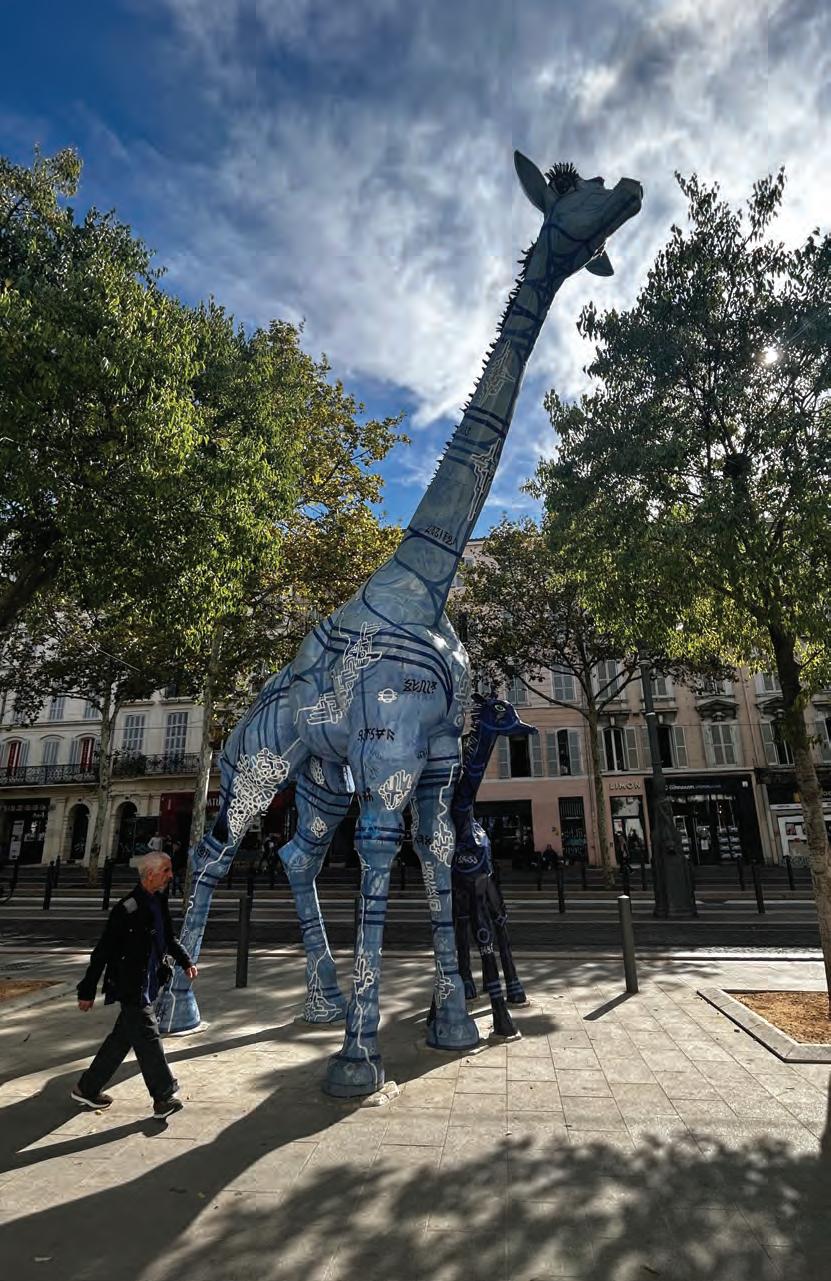
ENGAGEMENT
n. 1. an agreed arrangement to go somewhere or do something at a specific time
2. the act of being involved in an activity
La Longue Histoire de Zarafa, Marseille, France [Djeneba Diop]
ENGAGEMENT I
Partys, Messen, und Stadtfest
Over the course of my semester in Leipzig, the city has been home to several local and national fairs. These events have provided me with both entertainment on the weekends and a glimpse into Germans’ lives and customs. Three weeks ago, there was a gothic festival with venues around the city for music, drinking, and other activities. Two weeks ago, there was a Bierfest and an antiques flea market along the Galopprennbahn Scheibenholz, an old horse racing track. This past weekend was the Leipziger Stadtfest, which was by far the largest and most extravagant fair thus far.
This event celebrated the start of summer with a huge gathering of tens of thousands of guests from around the country. This year, the city celebrated its 30th Leipziger Stadtfest with events held in every Platz in the city. Several Plätze offered live music, including the Firebirds, a rock ’n’ roll band from Leipzig; the Sax’n Anhalt Orchester; Maja Catrin Fritsche, a German pop singer; and more. Alongside the many performances, hundreds of vendors milled the streets and Plätze selling beer, Eis (ice cream), Curywurst (a classic sausage dish), bratwurst, crêpes, a surprising amount of Waffeln (waffles), Kartoffelpuffer (potato pancakes), and Kaffee (coffee). Around the city, pop-up Bäckereien (bakeries) sold different types of Brot (bread) and Kuchen (cake).
I spent much of my time exploring the excitement of the city with my camera and attending the concerts. My favor-
a journal of global perspectives 7
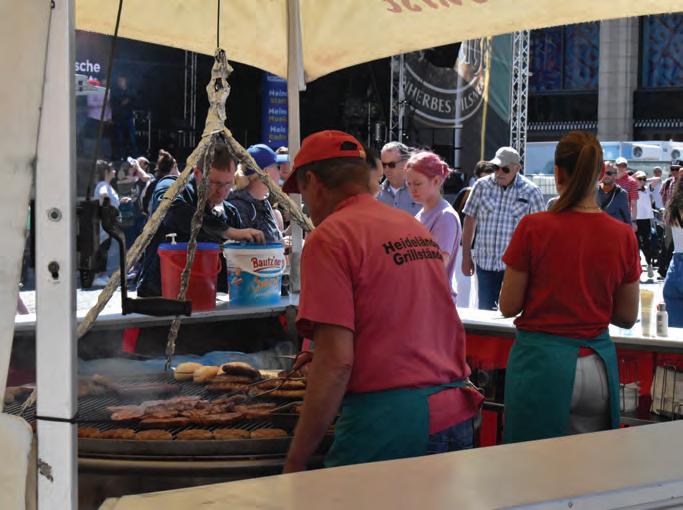
Leipziger Stadtfest,
ite dish of the day was the Waffel. When I ordered my Vanillecreme, what I got was unexpected. This was not a typical breakfast waffle, but rather a waffle sandwich: two waffles and a vanilla ice cream-like paste between. It may have been messy and more of a dessert but it was delicious! The Stadtfest also had carnival attractions with numerous activities for children and adults. At the center of the university campus on Augustusplatz, there was a massive Ferris wheel, little games, and an NFL attraction plastered with Patriots logos (clearly the Germans know who to support). In another Platz, there were more carnival rides, arcade games, bumper cars, a mirror maze, and other generic carnival booths and candy shacks. At night, the city lit up in a rainbow of colors and it looked spectacular.
Believe it or not, there was even more going on at the Stadtfest. On Saturday night, RasenBallsport Leipzig, also known as Red Bull Leipzig or RBL (Leipzig’s Fußball Bundesliga team), played in the DFB-Pokal championship game against Eintracht Frankfurt and were victorious with a 2-0 win.
8 The Aleph
Bratwurst,
Leipzig, Germany [Will Russell]
They won the title last year, too, so their triumph extended their reign for another season. The final match took place in Berlin, so Leipzig came together to cheer on their team on an LED screen in Marktplatz in the very center of the city. The crowd was absolutely massive and very rowdy. The Fußball spirit here in Germany is huge, and once Dominik Szoboszlai, midfielder for RBL, scored the second goal in the 85th minute, thus securing the win for RBL, the city went berserk. It was an amazing spectacle and so intriguing to watch the city’s dedication to and support for their team. I am grateful to have been able to take part in such a unique experience!
Over the weekend, the city was thriving, and the people were wild. It was great to see the city so lively and experience how special summer is to the German people. Almost every weekend seems like a party and it’s a truly ecstatic and splendid atmosphere. People often view Germans as very rigid, strict, and curt, but I saw that Germans are not all like that. They are very affable, resolute, and exhilarating people. In the US, I rarely see events like this, much less
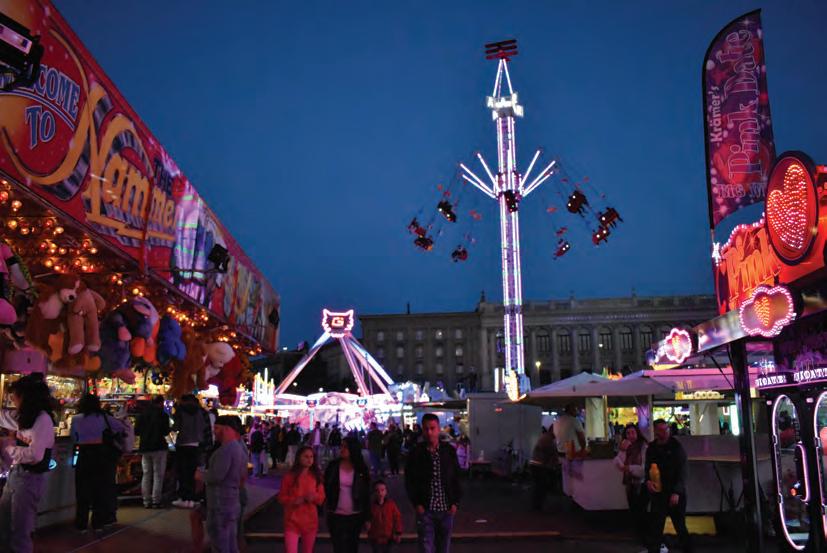
Leipziger Stadtfest, Leipzig, Germany [Will Russell]
occurring every weekend, and I grew up 20 minutes outside of Boston. I am grateful to be living in a city and able to experience so much in such a short amount of time. It feels like I got here only yesterday but it has been over three months and I’ll be done with school in just over a month! I can’t believe it.
I have not checked to see what the city has scheduled for the month that I have left here, but I am excited to see what they have planned next.
Tschüss!
- Will Russell
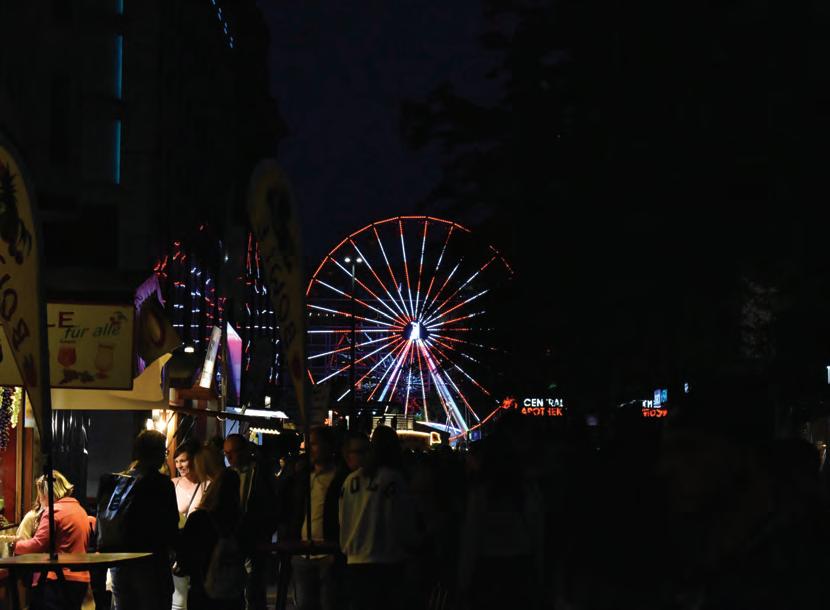 Leipziger Stadtfest, Leipzig, Germany [Will Russell]
Leipziger Stadtfest, Leipzig, Germany [Will Russell]
Celebrating Women and Soccer in Berlin
In Europe, soccer is regarded not just as a part of life but, for many, as a way of life because of how important it is to community and friendship. Soccer brings entire cities and countries together because it is a game that drives passion, strong emotions, and relationships for both players and fans. In a city like Berlin, which was once divided physically and culturally, soccer is an avenue for unity and shared interest.
There are two main teams in Berlin, Hertha FC and FC Union Berlin, and both compete in the Bundesliga. Although the favored and higher-level team is Union, Hertha FC has loyal supporters. When the Berlin Wall first came down, these two teams had a friendly match that attracted around 50,000 fans! Today, Hertha plays in Olympiastadion Berlin (also used for other events like concerts and the 1936 Olympics), which holds around 75,000 people. Union’s stadium, Stadion An der Alten Försterei, holds 22,000 and is usually sold out on game days. Both teams garner many enthusiastic fans throughout the year and serve as an ode to how important and valuable soccer is in the lives of Berliners.
Here in Berlin, I play on a soccer team called Berolina Mitte, which practices about fifteen minutes from my apartment. I found the team through an old William Smith teammate who lives in Berlin. Most girls are my age, but the players on my team range from seventeen to thirty years old, which demonstrates the love and willingness Germans have for playing soccer no matter where they are in life. The practices are coached entirely in German and my teammates are very open to speaking German with me and helping me understand what we are doing. I have learned a few words that they use a lot during practice:
a journal of global perspectives 11
Engagement II
1. Unbedingt: regardless of any obstacles, under any circumstances - used when someone scores a goal by giving it their all
2. Weiter: more, continue, further - used by defenders to get their team to keep pressing or to not give up
3. Druck: pressure - used when you pass the ball to your teammate who has a defender near them so they know to pass the ball back
4. Durch: through - used when you want the ball to be passed to you through two defenders
I was able to experience the excitement and community brought about by soccer on International Women’s Day when my team went to an event at the Adidas Sports Base in Berlin. This was a 5v5 tournament with around 12 teams, each representing a different club team in Berlin. My team split up into two groups of seven, and I was excited that a lot of us were going to be there because it was a chance to get to know my teammates better.
The day started in the morning and Adidas supplied every player with a uniform and other gear to keep! We all got to run out on the field where we were introduced and cheered for by the spectators. Each team played a few games and then there were playoffs and a final. Unfortunately, my team did not make it to the finals, but we had a lot of fun playing in the games because the crowd was energetic and involved. There was an announcer for the event who was very into it, DJs playing music, and a lot of media personnel taking pictures and videos throughout the day. Each player also got free food and drinks, and we could hang out in the main room that had couches and tables. The coolest thing was the panel held in the middle of the day where some famous soccer players, influencers, and other public figures were interviewed. It was entirely in German so I did not understand much of it but it was a good opportunity to prac-
12 The Aleph
tice my listening skills. The event was all about the players and celebrating women’s accomplishments in sports. Everyone was so excited to be there playing soccer.
Although I have been to countless soccer tournaments in the US, I have not experienced something of this magnitude that celebrates both sports and women at the same time. Sure, the US celebrates women in sports a lot but the media personnel and services to the players were something I had not experienced before. The events like this in the US are usually for players of higher caliber or for famous athletes and influencers. This event celebrated just the “average” soccer players of Berlin (showing that not just famous people are celebrated here in Germany) and it was fun to feel special for who I am. At tournaments or soccer events in the US, there are usually so many people there and it is easy to get lost in the crowd and feel small. The Adidas Sports Base was a more intimate setting, and it was clear that a lot of time had been put into planning and organizing the day so we could all enjoy it. Being in a big city makes it easier to attend events like this because there is a “sports base” and more funds and resources are available. There are too many
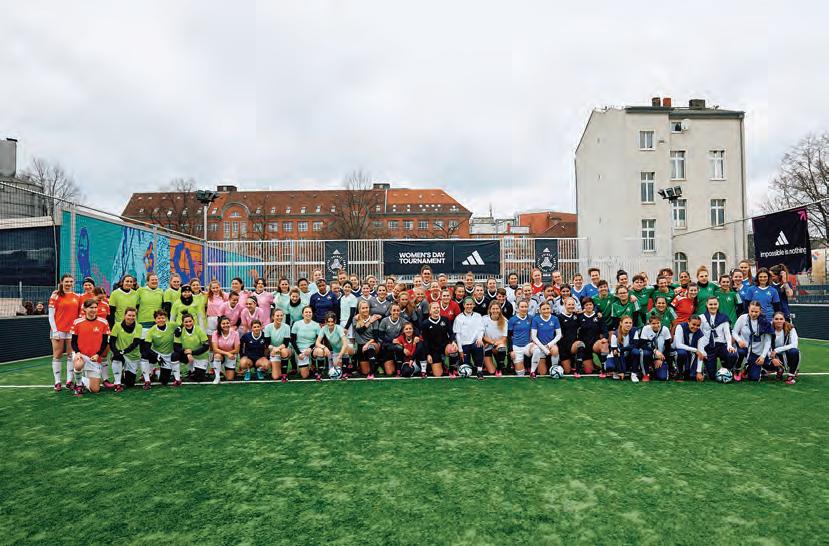
International Women’s Day at Adidas Sports Base, Berlin, Germany [Emma Kirts]
other popular sports for there to be as much excitement around soccer in the US as there is in Germany. Overall, I really enjoyed this experience and seeing how soccer has the ability to bring people together and give them a memorable day.
- Emma Kirts
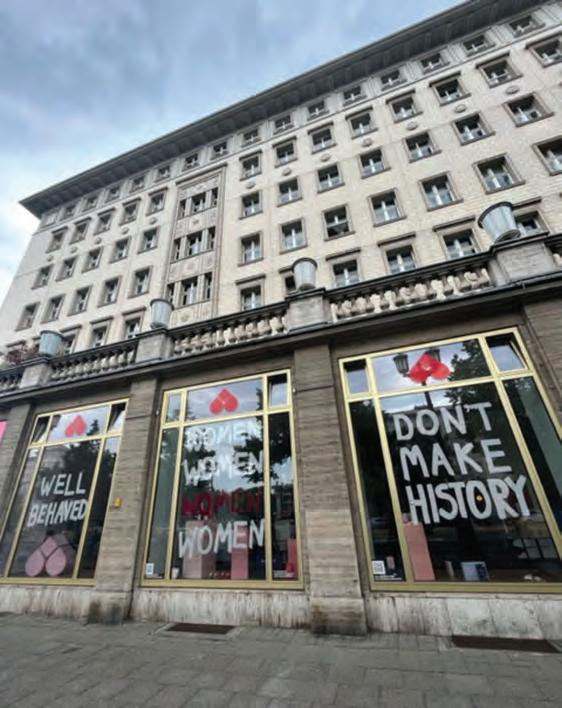
14
The Aleph
Artwork on Karl-Marx-Allee, Berlin, Germany [Anjalee Wanduragala]
 Artist in Discussion with a Friend, Naples, Italy [Ryan Brady]
Artist in Discussion with a Friend, Naples, Italy [Ryan Brady]
Flamenco and OpenMindedness
Flamenco is an integral part of Spanish culture. A mixture of dance, song, and emotion, it captures the audience and pulls them into a world of rhythm. Walking around Seville, it isn’t uncommon to come across flamenco dancers performing in the streets, or others singing slow and steady flamenco songs.
My program in Seville, API, planned an excursion to a flamenco dance workshop. At first, I was slightly nervous to attend - I am notoriously a horrible dancer. I took dance classes as a kid but was always put in the back row as I could never properly recall the rhythm or steps to the choreography. Despite my fears, I have always wanted to learn flamenco. Since arriving in Seville, I’ve kept a really open mind and decided that I needed to make the most of my limited time here. So, I signed up for the flamenco lesson in an attempt to push my comfort zone and truly experience Spanish culture.
Flamenco consists of three parts: singing, dancing, and music (usually played on a guitar). Flamenco songs tend to be deeply emotional and can be about topics like love and heartbreak. That emotion carries into the dance, and, as our workshop instructor told us, a great flamenco dancer knows how to reflect emotion in each step. If they want to reflect some sort of anger, they may do the llamada, or “call” (usually stomping or clapping), loudly and violently. Or, if they want to come across as flirtatious and romantic, they use their hips and face to communicate adoration. There are many types of flamenco, but in the workshop we specifically learned the tango (not to be confused with the Argentinian tango).
16 The Aleph Engagement III
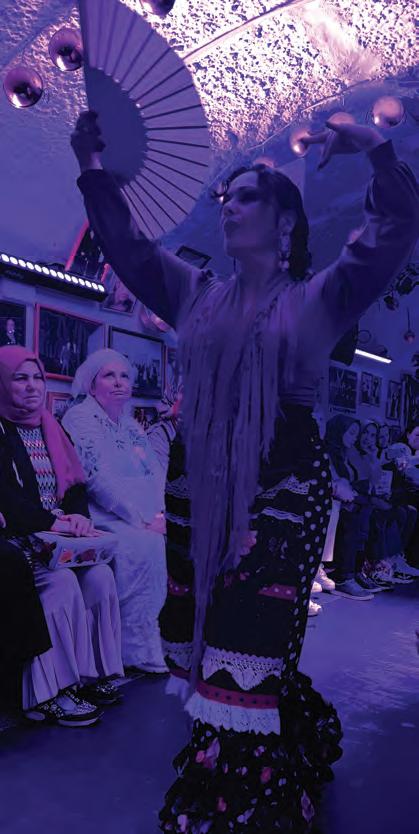
We started the workshop with a few basic steps that corresponded to a count of four. Progressively, we learned more and more moves, and by the end of the workshop, we knew six different sequences that we pieced together in choreography. Each move was a combination of steps and arm movements. Many of the steps were meant to be stomplike, while the arms moved more delicately. In fact, I felt like the arm movements were probably the hardest part, as you had to step, move your arms up and down, and also
a journal of global perspectives 17
Flamenco Dancer, Granada, Spain [Isabella Renzi]
move your wrists, hands, and fingers ever so delicately to complete the move. Altogether, flamenco feels very freeing, as it’s more intuitive than dances like ballet or modern. You have to allow your body to move with the music and get swept into the rhythm as you complete your steps.
Although I was far from a flamenco expert at the end of the workshop, I was so glad I had gone outside of my comfort zone and tried something new. When going into a study abroad experience, I believe it’s very important to keep an open mind and try different things. It can be terrifying to be in a new country, far from your friends and family. As I said, I was nervous to try out flamenco and make a fool of myself. However, I did it and loved it, even if I messed up a ton. So, my advice to anyone going into a study abroad program is to embrace that fear and turn it into an opportunity to learn and try new things. If you do, I promise you will have some amazing experiences, most of which would not have been possible had you not overcome your initial fears.
- Isabella Renzi
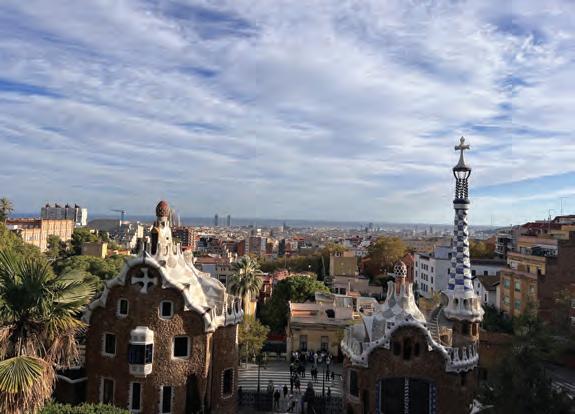
18
Aleph
The
View of Barcelona from Park Güell, Spain [Isabella Renzi]
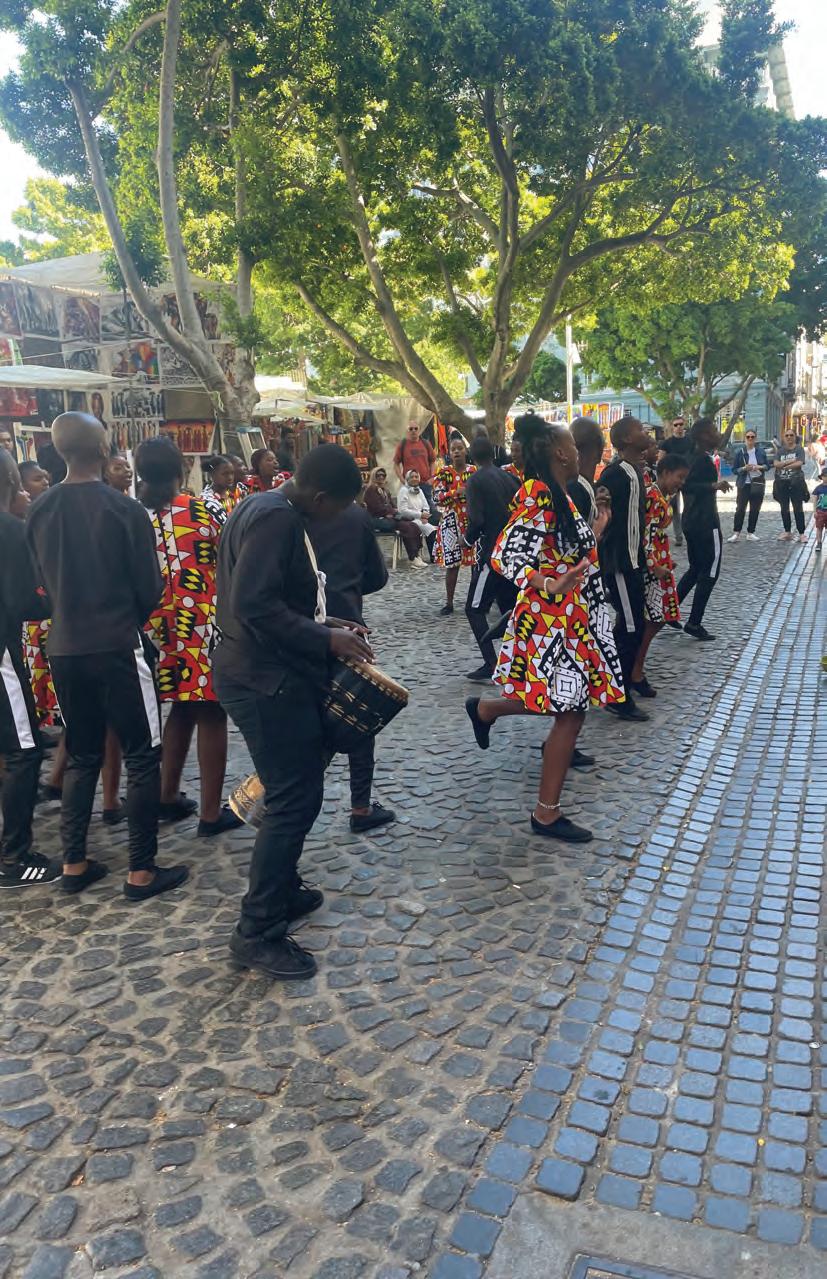
Performers in Cape Town City Center, South Africa [Ahmed Wise]
SC Freiburg Football Club
One of the most memorable experiences of my semester in Freiburg came in the last few weeks. I decided to go watch Freiburg’s soccer club, SC Freiburg, play a Europa League game. It was my first time watching live soccer, so it was a surreal experience. As a tennis player, I have watched many tennis matches before, but the atmosphere is the complete opposite of soccer. In tennis, spectators are expected to remain silent and seated during points and to be respectful and responsible. In soccer, on the other hand, all hell breaks loose! Freiburg fans were shouting and chanting all around the stadium and everyone was loud, rowdy, and crazy. I loved it. It seemed more like a party than a soccer game. Everyone was there to have a good time, and, at many points, I found myself paying more attention to the chanting fans than to the game itself. My favorite part of the experience was the SC Freiburg song, which was played at the beginning and at the end of the game and has become our favorite song over here. Although we don’t understand most of it, my friends and I remember the chorus really well:
“SC Freiburg vor - immer wieder vor. SC Freiburg vor - wir stürmen jedes Tor.” It means: “Forward SC Freiburg – forward again and again. Forward SC Freiburg - we storm every goal.”
To top it off, SC Freiburg won 5-0, so everyone was happy and excited.
While Americans are also passionate about their sports teams, sports like football, basketball, and baseball are more popular than soccer and generally have different fans. In Europe, basically everyone watches soccer, so it unites everyone. In fact, when Freiburg played the English team West Ham, a lot of British people came to the small city of Freiburg to watch the game. It seems more uncommon for
20 The Aleph Engagement IV
American sports to draw international tourists like that.
Watching SC Freiburg’s game showed me what a big part of German culture soccer really is. It was the experience of a lifetime to be a part of the electric atmosphere of a soccer game. Most importantly, it made me feel so much more connected to the city of Freiburg. I felt like a true Freiburger and realized how much I have come to love the city in such a short time. That is the beauty of the sport.
- Tarang Malhotra
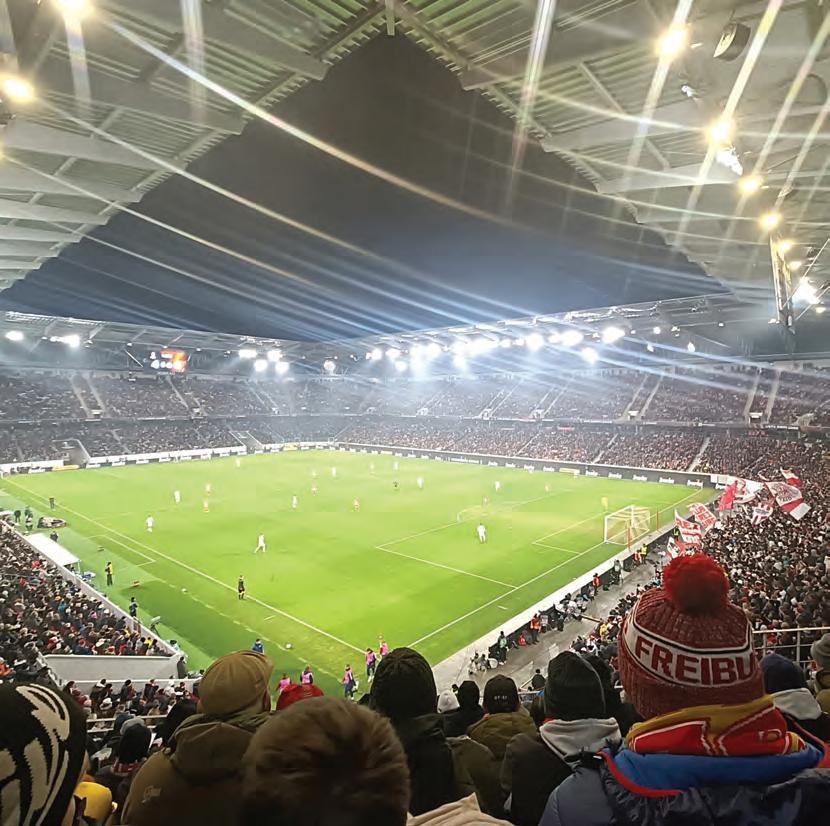
SC Freiburg Defeating Olympiacos, Freiburg, Germany [Tarang Malhotra]
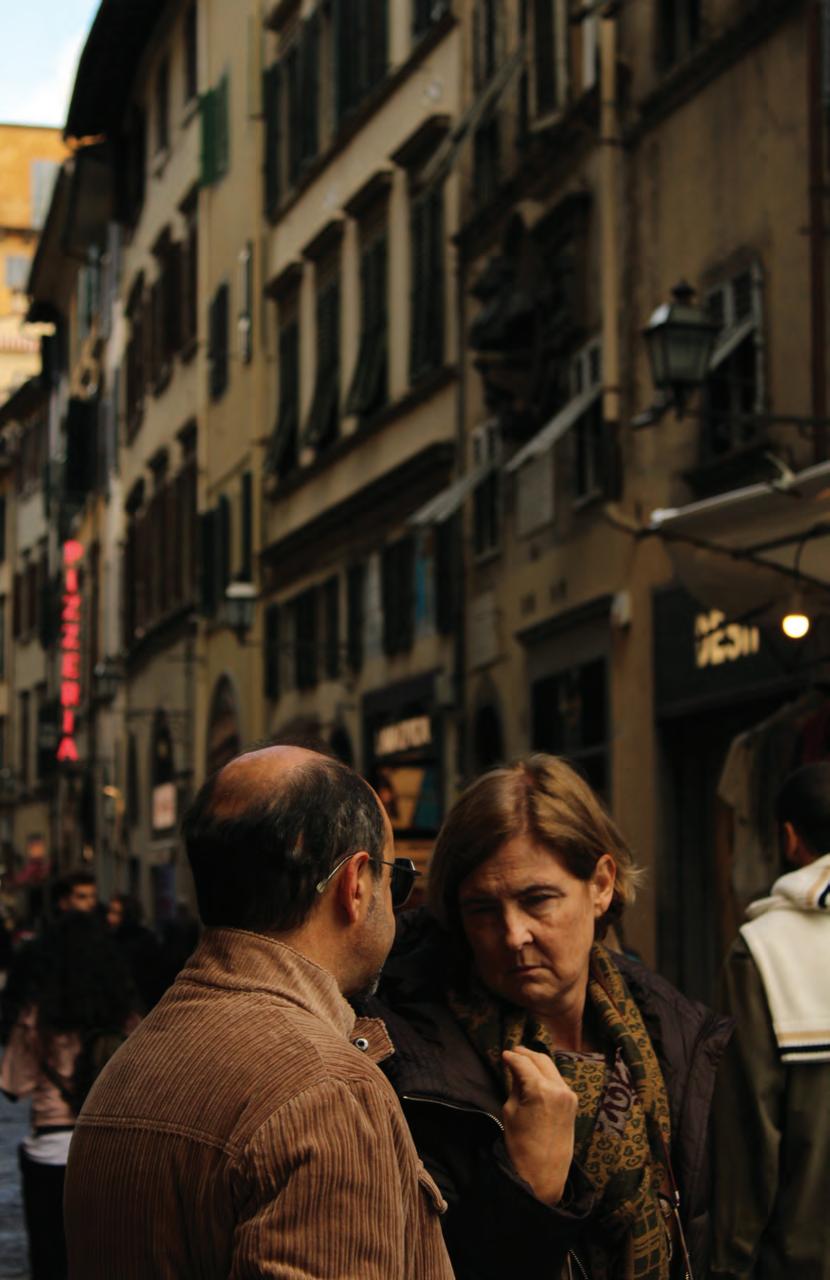
CONNECTIONS
n. 1. a relationship in which a person, thing, or idea is linked or associated with something else
2. the action of linking one thing with another
“Second Language” of Italy, Florence, Italy
The
[Ryan Brady]
CONNECTIONS I
Temporary Regular
A pale green building with yellow lettering reading “Ward’s Corner Store” sits at the corner of University Road in Galway, Ireland. The dreary weather of the city often drowns the brightness, but, even on the rainiest days, Ward’s beams vibrantly. Advertised with their salad bar, sandwiches, and other fresh foods is their establishment year, centered proudly: 1931. As I pass by every day on the way to my lectures, I reflect on how it’s had almost a century to perfect its craft in the great food it offers, but I am also not sure how it can be made any better in the years to come.
Inside, you can be sure to be met with the same faces. The woman behind the counter wearing glasses and a navy apron is always the first to say hello.
“What can I getcha?” she asks. My answer always changes, like the hair scarves she wears, wrapping her brown hair away from the food she prepares.
This time, though, I ordered my favorite: a traditional bacon, lettuce, and tomato on a white baguette. I have had many of these sandwiches in my lifetime, but the simplicity of it is a true test of the quality and freshness of the ingredients and the integrity of the deli.
I meet the same cashier that always rings up my order. He wears a black turtleneck every day and never fails to awk-
a journal of global perspectives 23
wardly ask me what I chose this time. I hand him my Ward’s reward card that the woman insisted I get because of my frequent visits. It was a little embarrassing to be recognized for my consistent attendance - sometimes I am even a little more punctual here than I am for my classes - but it is also comforting to know that I am a regular somewhere in a city that is foreign to me.
Four euros and some change is my total; the price never fails to surprise me because it feels worth so much more than that. Finally, wrapped in brown paper, the warm sandwich is handed to me. I make my way through the narrow

24 The Aleph
Fish at the Market, Florence, Italy [Ryan Brady]
pathway to the row of barstool seats that face a window to the street outside. Passersby walk across, unaware that I am watching them ignore the best place in all of Galway - I haven’t tried every food spot yet, but I am still sure.
I love the sense of home the deli gives me. It doesn’t remind me of where I am from, but it has quickly become a source of relief in my daily life. On this day, I am missing home and the people closest to me. Most of the time when I make a call back to California, I am left with a robotic voice encouraging me to leave a voicemail instead of the warm, talkative nature of my mom. An eight-hour time difference only enhances the feeling of the 5,067 miles of physical distance between my family and me, something I have yet to adjust to. This disconnect is what happened before arriving at Ward’s, leaving me feeling defeated as I entered the small shop. However, the familiar working faces I have gotten to know through casual exchanges ease my anxiety; it is a place that has become neighborly to me even if I am only a temporary regular. I tuck away my phone, deciding to try again later in the day; for now, I have chosen to focus on where I am.
My one complaint about this place is the uncomfortable wooden seats that provide little distance between myself and the people in line. The only other option is to sit outdoors, but the weak umbrellas that tower over the steel chairs and tables do not protect customers from the forceful winds and wet air that Ireland is guaranteed to provide. So, I remain on the wooden barstool indoors, continuing to watch the people of Galway pass by.
Back to my sandwich: I unravel the paper and am met with the crispy bread containing lettuce that is so fresh I can imagine the sound of the crunch just by looking at it. The bacon looks flavorful and not overly crispy, but cooked just enough to get a satisfying bite with nice texture. The bright
a journal of global perspectives 25
red tomato is tucked in, pouring out its juices onto the other components while the creamy white mayo glazes over the toasted bread.
My first bite is delicious. All the flavors complement each other well. I don’t think there is a better combination. Ward’s is reliable in the sense that it always provides satisfaction. The bread is soft enough that there is no irritation to the roof of my mouth while the flavor of the lettuce and tomato bursts on my tongue. Culinary legend Anthony Bourdain said it best, “Like a lot of really good, simple

26
The Aleph
Gull over Pulteney Bridge Flowers, Bath, England [Aaron Eddy]
things, more often than not, people find a way to overcomplicate them and screw them up.” Ward’s knows that it is not the complexity and originality of the sandwich that make it so great, but the quality of ingredients that allow the food to shine. More importantly, the execution and consistency of excellence of such a simple dish is one of the elements that makes Ward’s the remarkable place it is.
At every chance I get, I encourage my friends and new people I meet to try this place. Sometimes people join me, and we catch up on our weeks over a shared sandwich. On Wednesdays, my friends Ella and Annette and I promise to stop by the deli after our course together. It is a tradition we can’t always keep due to our inconsistent schedules, but we allow ourselves to feel excited just by the prospect of going. Everyone I have brought here has asked for a recommendation of what to order. I have made it my mission to try as many of the menu items as I can, and I am always able to give a knowledgeable response. Sometimes I’ll tell them to try the charcuterie wrap that’s filled with salami, gouda cheese, nuts, tomato spread, and arugula. Other times I’ll suggest the Mediterranean or veggie sandwich, but I’ll never recommend customizing your own; the staff at Ward’s know what they are doing.
Delighted with the taste and familiarity of the deli, I am distracted from my initial disappointment of not being able to talk to my family. My stomach is filled and happy as I appreciate what a great stop this is. I finish up my sandwich and take my waste to the small trashcans by the entrance, looking back before I leave to say a quick goodbye. The woman, Sophia, replies, “Bye! See you soon.”
- Brenda Plascencia
a journal of global perspectives 27
Lisbon Love: Reflection on Friendships While Abroad
The sound of Sofia’s guitar strumming bounced off the castle walls that had stood there for centuries. My final night in Lisbon, which had started with a picnic in a star-shaped park, progressed into an adventure through the city that led us to Alfama, one of the oldest neighborhoods in Lisbon, and up a castle wall. I’m not sure any of us knew or had a need to know where we were, with phones that had long run out of battery (a quick Google search a few months later clarified that we were at the Arco do Castelo, the entrance to the famous Lisbon castle, Castelo de São Jorge). We sat there for a few hours, telling stories and laughing, listening to Sofia play, marveling at the view, and, for me, mostly just soaking up the immense love that I found among those friends and within that city in those five fleeting months.
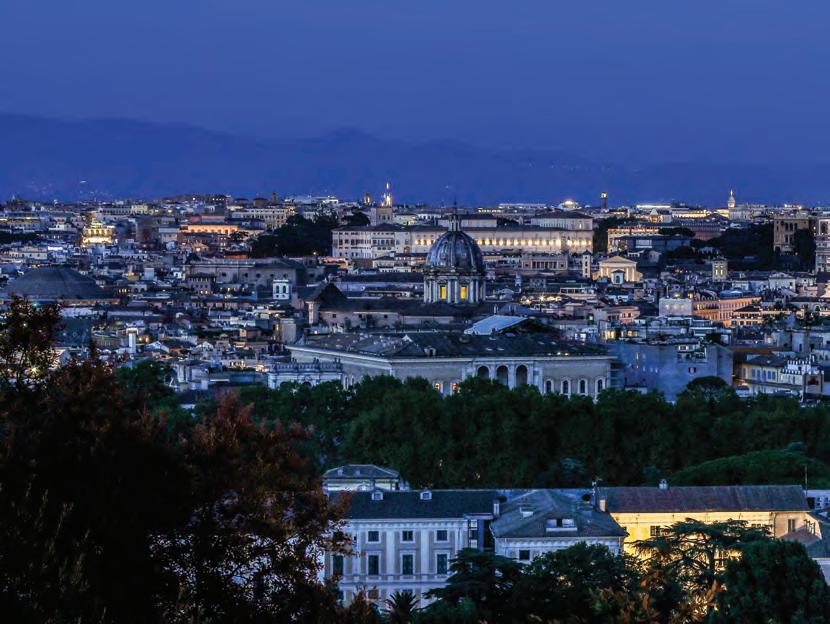
Connections II Sleeping Rome, Italy [Alex Barnosky]
Reflecting back on time spent in a place as old as Portugal makes one acutely aware of history. To think about the expansive stretch of time that passed between when the Castelo de São Jorge was built in the 10th century (and then rebuilt after the earthquake in 1755) to when we gathered there in June of 2023 is enough to make anyone feel incredibly insignificant in the grand scheme of things. But sitting there, among friends that had become like family, I remember feeling overwhelmingly lucky. Somehow, in the vast expanse of human history, my life had briefly intersected with the lives of these people from all corners of the world who shared with me a love which, itself, felt like it could have existed for centuries.
So much of my experience in Portugal was about these friendships. To be sure, I thoroughly enjoyed the parts of the country that I expected to enjoy: the landscape, culture, food, and fascinating history. Experiencing the famous June festivities in Lisbon, watching the massive waves
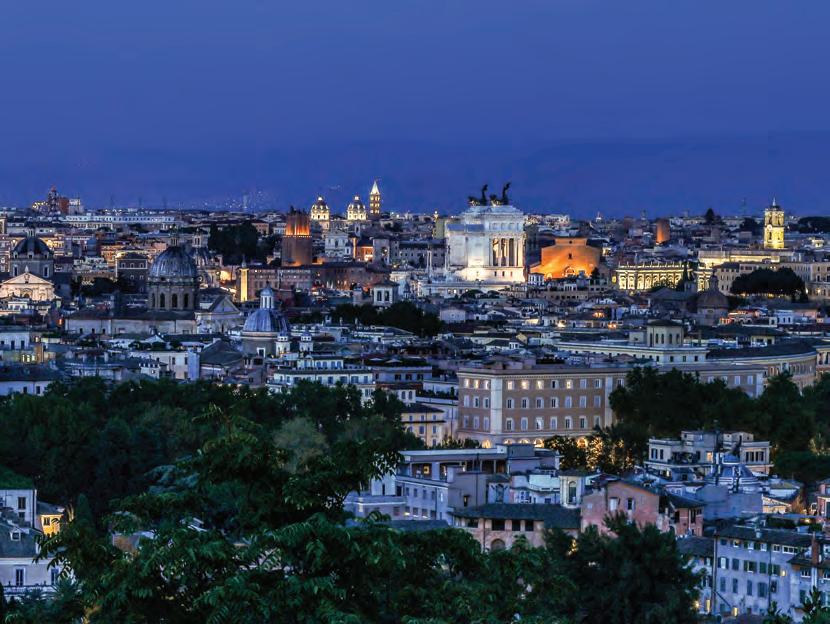

in Nazaré and surfing the smaller ones in Ericeira, drinking wine in Porto, hiking among the clouds in Madeira, and seeing Cristiano Ronaldo play a soccer match were all incredible memories that I will forever cherish. Yet, truthfully, I would have traded all the touristic experiences I had in Portugal for more time with the people I met. The profound moments of connection, especially those cross-cultural connections that show you a whole new side to the world, are what make studying abroad such a special opportunity. I met people who moved through life in radically different ways than I was accustomed to, who approached the world around them with such a great sense of adventure, empathy, and openness. They taught me new ways to live and love, to take risks and seek discomfort, to revel in the beauty of the world. Even though we had only known each other for a brief time and despite the language barriers, we managed to form unique bonds unlike any I have ever experienced in my life. In some strange way, I felt like they knew
30 The Aleph
View from the Alhambra, Granada, Spain [Paulina Tejada]
the most authentic version of myself that I had ever been, one brought out by their love.
My last night in Lisbon will be eternally ingrained in my memory as a culmination of all of the love that I found there. I might not remember the exact details, which were blurry even in the moment, but the feeling of existing there, in that perfect little intersection in time where the lives of all these wonderfully special people briefly collided with mine, is what I will hold with me always.
I feel lucky to have been able to experience a place as special as Lisbon, and even more so to have shared it with the best company I could have asked for. I will forever be changed by their love.
- Elisa Ribordy
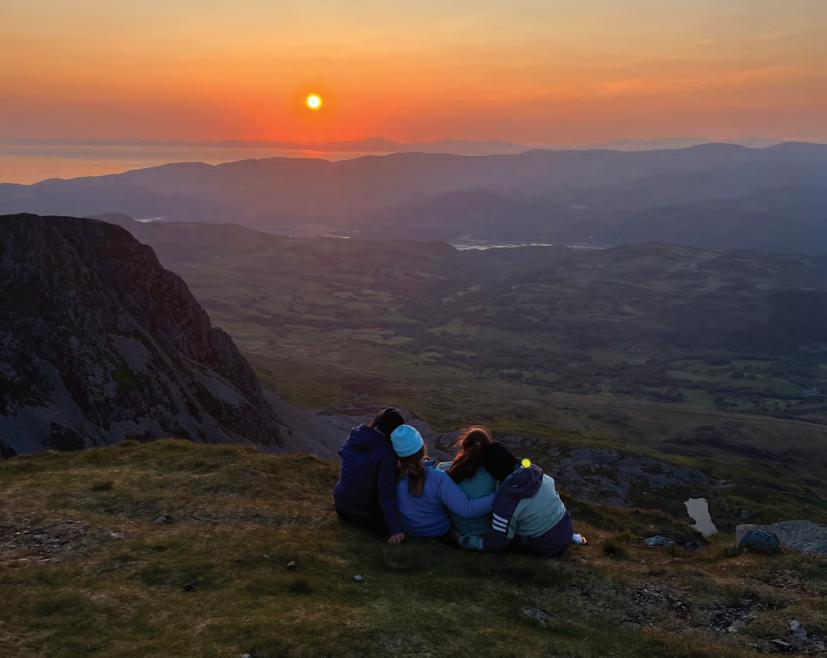 Tonight’s the Night, Cadair Idris, Wales [Jordan Britton]
Tonight’s the Night, Cadair Idris, Wales [Jordan Britton]
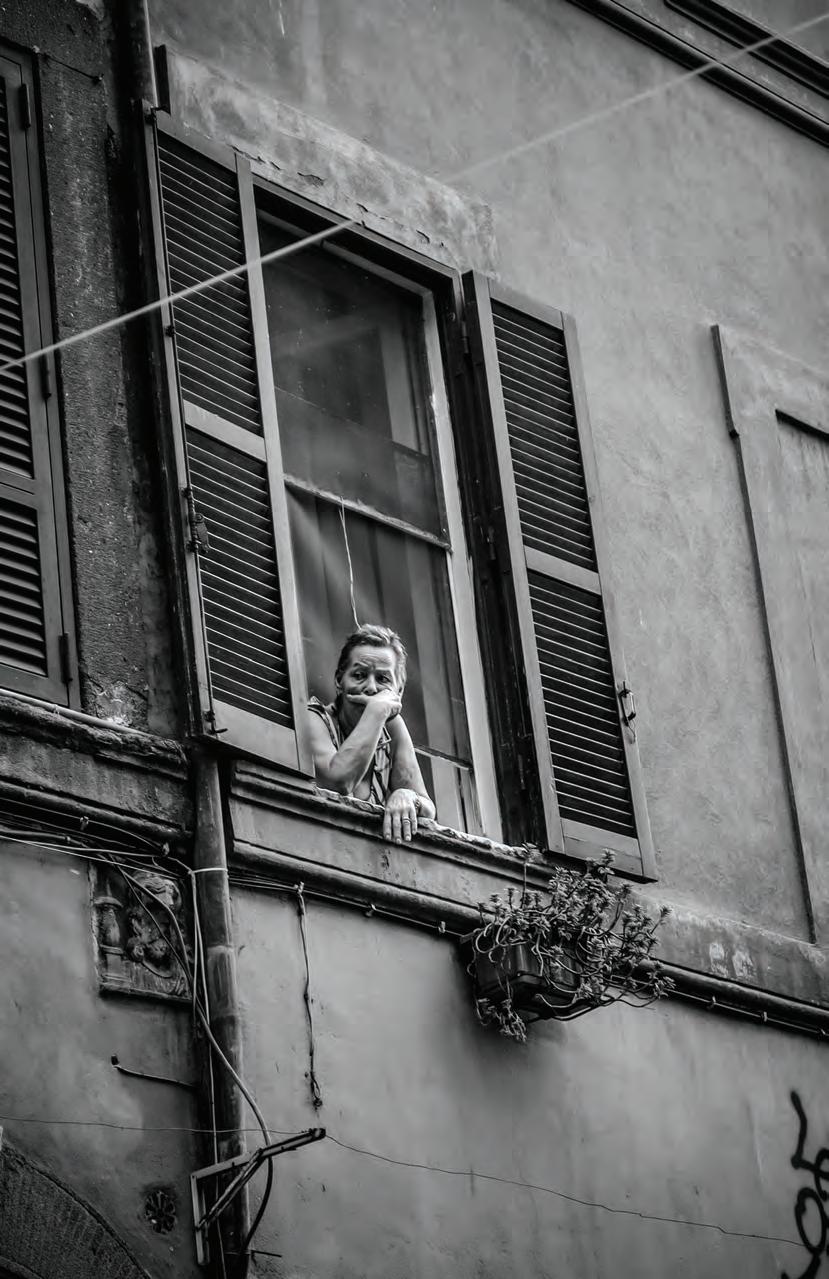 Woman Watching, Rome, Italy [Alex Barnosky]
Woman Watching, Rome, Italy [Alex Barnosky]
Eine Kleine Reise Nach München mit IES
While on a weekend trip to Munich with the IES Abroad team, we visited the Alte Pinakothek, where I was able to appreciate the art housed there and consider how it compares to American art museums.
I would like to take a moment to share one of my favorite pieces from this museum: Die Zwillinge im Alter von 33 Wochen (The Twins at 33 Weeks Old), most likely painted in the 17th century by the Dutch artist Aelbert Cuyp. The two babies in the painting are twins (Zwillingsgeschwister), and so I naturally felt a bit of kinship with it, being a twin myself. Unlike these twins, however, my brother and I were never dressed in long, flowing clothes for a portrait. I’m not entirely sure what it was about this piece in particular that captivated me so much, though I suspect it has something to do with the expressions on the children’s faces, which I find quite humorous.
The Alte Pinakothek, like many other old European museums, has a lot of stairs that can be a challenge for some, including the elderly. The museum has an elevator, but, on high-traffic days, it can be quite a wait before one gets to use it. It is because of these stairs that I had one of the most wholesome experiences of my entire time abroad thus far. As I made it to the top of the stairs, there was an elderly woman who (alles auf Deutsch, natürlich) asked me where the elevator was. I had no answer for her but was able to offer help down the stairs using my A2-level German instead. I ended up carrying her bag for her as she clung to the railing. At the bottom of the stairs, she began thanking me profusely…I presume. She spoke quickly, and all I was able to catch for sure was “sehr sehr freundlich.” Regardless of the language barrier, I was happy to have helped and felt quite
a journal of global perspectives 33 Connections III
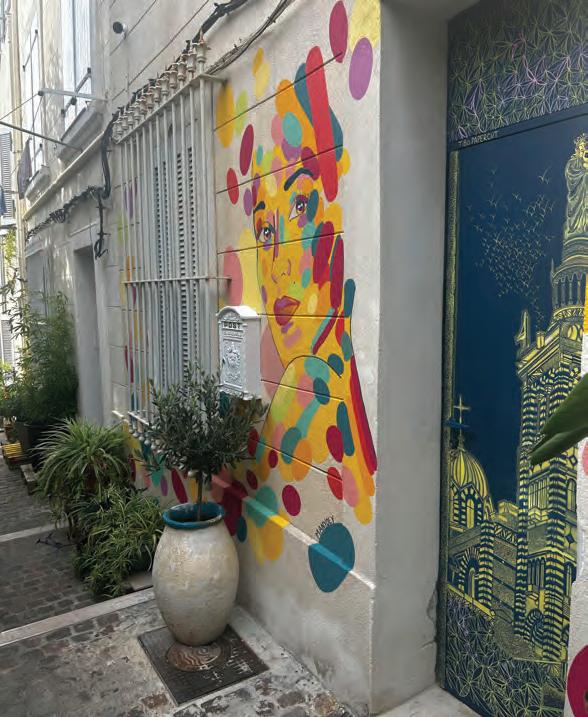
proud of myself for being able to understand her question and offer help in a way she understood.
The whole interaction made me consider the accessibility of museums like the Alte Pinakothek, which was originally constructed in 1836, clearly without taking any issues of access into account. Generally speaking, I have found that museums built relatively recently, like the Humboldt Forum, are often quite accommodating, with resources like multiple wide elevators and tactile lines and maps for those with vision impairment. I was reminded of traveling in Florence with my older sibling in January after an unfortunate fall in a piazza bound them to crutches. Their lack of mobili-
34 The Aleph
L’art contemporain à Marseille, France [Djeneba Diop]
ty significantly hampered their ability to explore and enjoy the city, especially museums such as the Academia, which had areas only accessible via stairs.
In the US, while certainly more can be done in terms of making everywhere accessible for those with mobility issues, many of our art museums are simply newer than the Alte Pinakothek and thus were constructed with a different ethos. For example, one of America’s most popular art museums, the MoMA in New York City (which was founded in 1929), is wheelchair accessible at every entrance, as is every exhibit housed within. The museum has an entire section of its website dedicated to its accessibility accommodations, which include the aforementioned wheelchair access as well as a sensory map and an open invitation for guide animals. These resources are not available to visitors to the Alte Pinakothek.
- Ian Moon
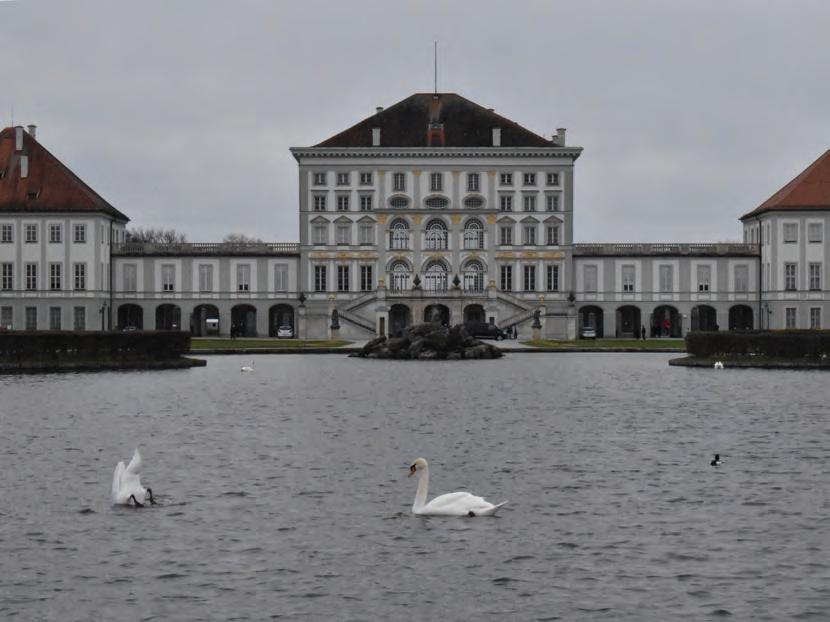
Nymphenburg
Germany [Will Russell]
Palace, Munich,
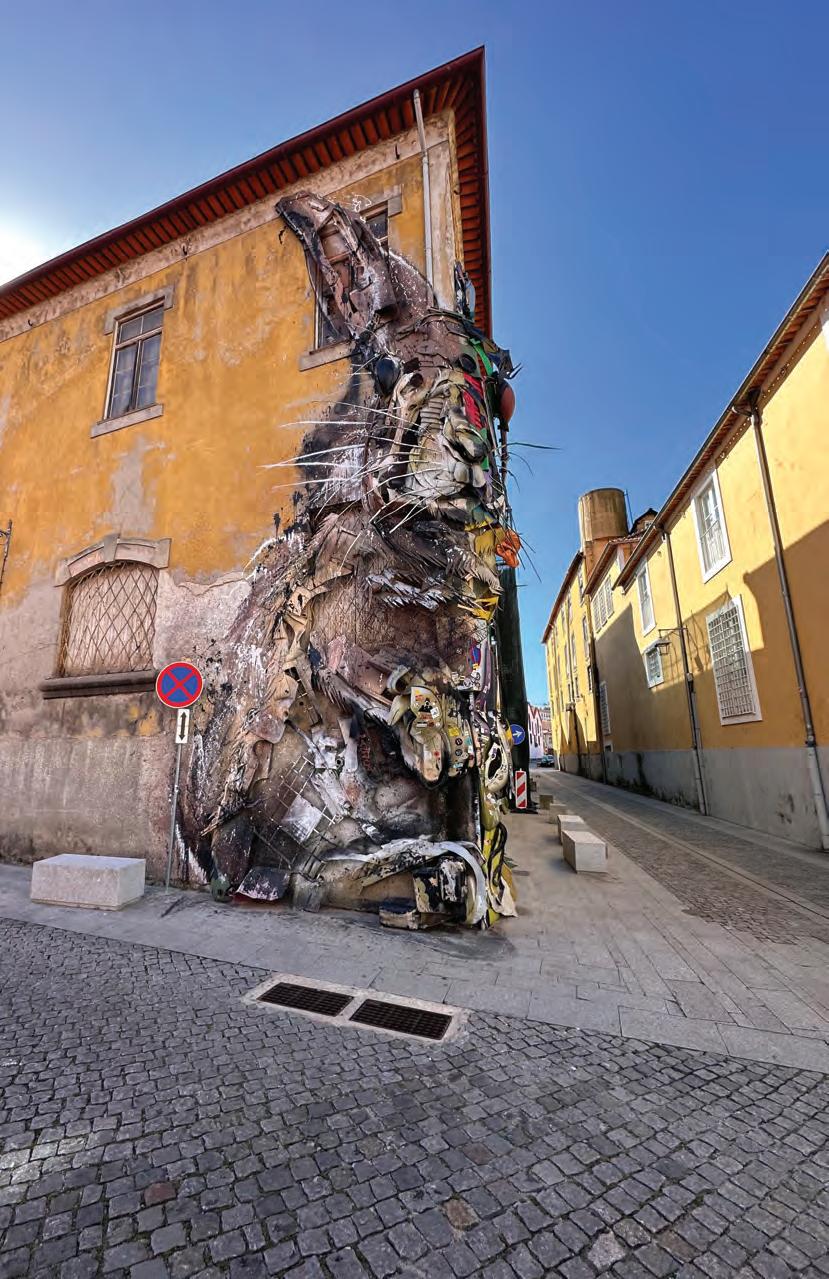
CROSSINGS
n. 1. the action of moving across, over, or through something
2. the act of being a place where two roads, paths, or routes meet
3. a passage through a border
Sculpture in Porto, Portugal [Katelyn Weeks]
CROSSINGS I
Fruitless Attempts at Understanding Home
It’s funny to me how quick I am to call somewhere home. I wonder what a place does to deserve that title. I was in a convenience store in County Mayo shopping with three friends when I casually said, “Let’s do it when we get home.” The home I was referring to, understood between my friends without a second thought, was our rental home down the street where we had just arrived the previous day.
John, Ella, Griffin, and I filed through the door in a bout of excitement, eager to set our bags down, claim our beds, and scope out the bathrooms. There were two black leather couches and a low, light colored wooden coffee table in the living room. It looked curiously similar to the furniture in the college accommodation that I was escaping for the weekend but was much nicer - the couches with their plush arms and the unmarred surface of the table. The carpet underfoot reminded me how comforting the feeling of soft fibers squishing between your toes is and that I actually really enjoy sitting on the floor when it isn’t made of cold, dusty tiles or unforgiving hardwood. I marveled at the sight of a double bed, so excited to be able to stretch beyond the bounds of a college twin, even if I was sharing it with Ella. One cozy night in the foreign house and the very next day I’m calling it home. How traitorous.
That Mayo rental was perfect for us, but, when I get off the
a journal of global perspectives 37
bus in Eyre Square and the familiar sky of Galway welcomes me, I let out a breath of air, my heart expands, and I relish the feeling of being home. I lift my pack onto my back, descend the steps of the bus and spill out into the center of Galway. The utter exhaustion that gripped me on the bus loosens its hold and relief sets in. The corners of my mouth lift, and I get that warm, fuzzy, just-ate-a-bowl-of-yourmother’s-chicken-soup feeling in my stomach. I am home. I start the walk toward my apartment and pass O’Connell’s Pub. With chipping blue paint framing the giant windows, it doesn’t look as alive from the street as it turns out to be when you cross through the stale barroom into the sprawling beer garden hiding in the back. O’Connell’s was where I went on the first night of my four-month stay in Galway with a group of relative strangers, and it’s where I first knew that I was going to be happy here. I’ve been back many times since that night and a flood of memories surges through my mind every time I peer through the window into the dimly lit front room as I walk past.
Next is a triangle intersection. Cars heading away from O’Connell’s split into one-lane roads to go their respective directions - left toward Shop Street or right toward where I live. Cars also soar past moving away from Shop Street in the direction of my apartment. This traffic control design means that for a pedestrian to cross the road, they must use two crosswalks and sometimes pause in the middle of the triangle. I maneuver through this seamlessly, never stopping in the middle, never waiting for the pedestrian light to turn green. There are rarely any cars heading toward Shop Street, making it easy to cross - an insider secret. I feel acutely at home when I walk with a purpose through this intersection, like I’ve done it one hundred times - I have done it one hundred times. I blow past the tourists who stand at the edge of the curb like the sheep Ireland is so famous for, waiting for a green walk light to flash and herd them across.
38 The Aleph
After the intersection is the Gala, a common stop on the way home in the nighttime hours of the morning. Gala is simple - there aren’t many options which makes midnight snack picking easy. I think of all of the times I have gone with Griffin and resisted buying my own snack with the claim that I’m not drunk-snacking anymore and then eaten his snack the whole way home. Most importantly though, Gala sells my favorite cookies, Cadbury Crunchy Melts, which are hard to find at other Galway stores. Another alltoo familiar process: walk through the automatic sliding door, reach your hand around the rack of crisps on the left, grab the trademark purple package, give the cashier a few euro coins, exit, and immediately tear the package open. In high school, I learned that actions like moving your arm are voluntary muscle movements, while your heart beating is involuntary. You don’t have to tell your heart to beat, it just does. I swear opening that purple package the second I’m out the door has crossed into a category of muscle movements that includes inhaling oxygen and pumping blood. The only thing that saves me from overdosing on those beautiful, sinful cookies is that, when you get through the intersection, Gala is back on the other side of the street, so
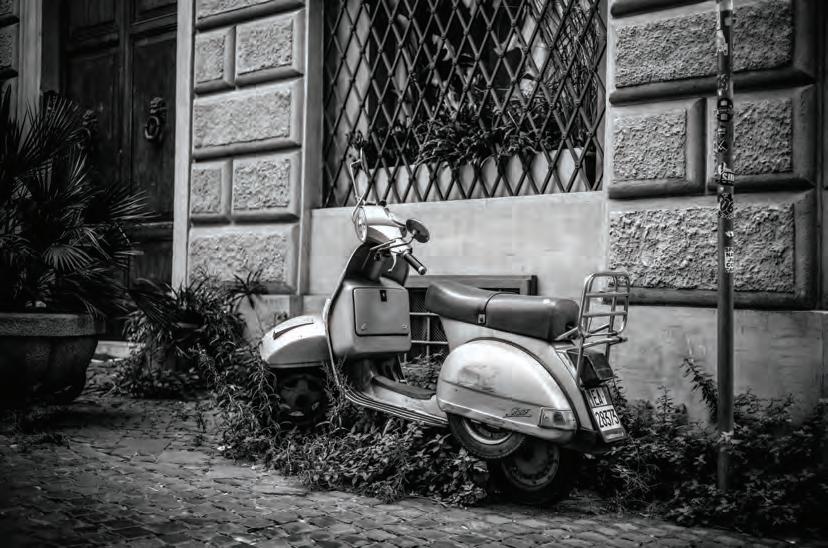
Vintage, Rome, Italy [Alex Barosky]
you simply look at it longingly and keep walking.
I veer left and turn into TK Maxx. I walk the same route as always, winding through the clothing racks. I steal glances at myself in the full-length mirrors as I exploit the store, using it as a superhighway to shave approximately 25 seconds off my journey and escape for a moment from the steadfast rain. The doors on both the front and back side of the store make it perfect for cutting the corner, and walking through the rows of colorful clothes provides me brief stimulation. I think of all the times that my friends and I have filed through the store with our hoods up, dripping wet, trying to get downtown. It’s our not-so-secret passageway, like a tunnel connecting distant wings of a castle.
The walk goes on and everything I pass triggers memories. Just after TK Maxx, there’s the hill that Molly and I got chased down one fateful night, then the window that the black-and-white cat with the pink collar sits in on sun-

The Friends You Make Along the Way, Pen y
Fan, Wales [Jordan Britton]
ny days, and the grocery store that sells pink frosted donuts for just 60 cents. Next is the stretch of sidewalk where Bethany made Ella and me laugh so hard we cried. On the other side of the street is the ever-tempting coffee hut that appears to be tucked away into the base of an electrical tower and the parking lot where Brenda, Griffin, Bethany, Ella, and I watched drag races once. (If you really want to feel like you’ve achieved insider status somewhere, watch 50 high schoolers rev their Volkswagen GTI engines outside of a McDonald’s on your way home from a pub on a Friday night and pretend like you belong.)
Every section of cracked sidewalk, every storefront spurs a memory of a conversation with a friend, a thought on a solitary walk, a feeling of familiarity. I’m halfway home now and the memories continue to guide me. I pass The Planet, a bowling alley and arcade, where Ella says she wants to go every time we pass. Whether I’m with her or not, I inevitably hear “Wait, we should go bowling one night.” Just after The Planet, I jaywalk across the busy road in a way that makes me feel completely Galwegian. I know exactly where I like to cross, where the traffic is usually light and there aren’t too many cars turning on or off the road into parking lots. It’s just ahead of the spot I used to use before watching Sofia cross here one day and realizing what a better place it is. On the opposite side of the street now, I pass the site near the intersection where, on sunny days, a man often juggles. Sunny or not, I always look for him. As I cross the next intersection, I do so with caution, remembering an incident on our first night when less care was exercised, and we almost lost Brenda to a set of oncoming headlights.
I’m close now; I know so because of the huge Dunnes Store that has been the destination of so many quick pastry, wine, and toilet paper runs. I can just barely see the apartments of Gort na Coiribe peeking through the brush and excitement bubbles to the surface. My pace quickens. I finally
a journal of global perspectives 41
turn into the Gort driveway and know when it’s raining not to take the path, but instead to walk on the road to avoid the puddles. I walk past Molly and Ella’s apartment on the way to my own and glance at their living room windows, hoping that they might be there so I can give them a wave. I can’t pass without rubbing my forehead, a consequence of a dramatic drunken event where, on March 17th, I fell down their stairs, cut open my head and gave myself a concussion. An angry red scar in the shape of a cross now marks my previously unblemished forehead and, when asked about it, I avoid the embarrassing truth by remarking, “It’s where I was blessed by St. Patrick.” The event lives at the forefront of my memory, overtaking the hundreds of other times I’ve successfully walked down Ella and Molly’s stairs, excited to tell them something, get dressed for a night out, or borrow a book.
I forge ahead and count up the row toward the safety of my own apartment: 3, 7, 11, 15, 19, 23, ah, 24. I descend the stairs that have never traumatized me, turn my key in the door, and I’m home. Dried leaves and unwanted newspapers that come falling through the mail slot on Thursday mornings scatter the floor just inside the door. It smells like mildew, mud, and stale cooking. It’s the same smell that greeted me when I first arrived months ago except then it was the source of tears. It smelled bad and I was sure that I’d never get used to it. I predicted it spoiling my mornings and preventing me from slipping into sleep at night. Never did I think I’d inhale the stale, damp air that lingers in my entryway and feel so at peace. The apartment is cold and a little bit disheveled. Its physical state is largely the same as it was the day I moved in and wondered how I could possibly live like this for four months, but now I see it so differently. It’s home.
After months of living in Gort na Coiribe and going on weekend trips to different cities and countries, staying in
42 The Aleph
hostels and rental homes nearly every week, I’ve found that the experience of returning to Galway is wholly unrivaled. It doesn’t matter how much fun I had over the weekend, who I was with, or how beautiful the landscape was, the walk to Gort na Coiribe is always the best part of the weekend. The dribbly gray sky that torments me on early walks to class Monday through Thursday rejuvenates me on Sunday afternoon walks home from the coach station. The mist that sticks onto my just-brushed hair and ruins it on the walk downtown on Tuesday nights is instead welcomed with open arms as it clings to my face and washes away one layer of travel grime. It reclaims me, peeling away the particles that a different city’s air has deposited on me and marking its territory with its own polluted water droplets. I relish the gray sky, murky smell, and rain drops that soak my jeans. The 15-minute walk that I’ve equated to hiking
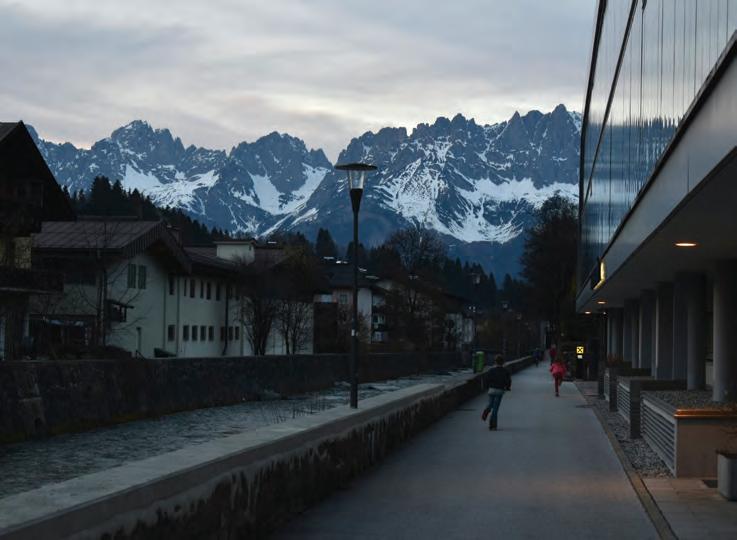
a journal of global perspectives 43
Kaisergebirge, Kitzbühel, Austria [Will Russell]
Everest when stumbling home from O’Connell’s becomes 15 minutes of gratitude when I’m carrying my overflowing backpack. I adore the characters that linger in Eyre Square, I feel protected by the people who walk too close to me on the narrow sidewalk, and I relax in the sensation of knowing my way home and not having to think about what my next turn is. It sometimes makes me wonder what it will feel like when I return to my other home, the one that my parents raised me in, that houses the double bed that I get all to myself, and has my own black-and-white cat. I shy away from saying “my real home,” because how can somewhere where I have a memory or emotion attached to every footstep not be real? Whenever I think of my other home - my first home let’s call it - on my Sunday walk to Gort, I shove it down, repress that thought, because I want to soak in every emotion, every thought, every fond remembrance that arises as I navigate home on autopilot. Galway is real and, despite not being my first home, or Gort not smelling like the peach candle in my childhood bedroom, it’s home.
Every time I walk home from Eyre Square, I pass the same homeless man who I’ve named Mike in my head. He sits just outside the TK Maxx Superhighway, sheltered by a shallow overhang and red-and-purple blanket. Galway is his home, too, and he and I trod the same path through the city. I imagine we step over the same puddles and look at our reflections in the same windows. He doesn’t have four walls or a roof over his head but then, the damp walls of Gort aren’t what make Galway my home. Maybe Mike, too, has a favorite snack and maybe when a generous passerby leaves money in his cup he goes to the same Gala as I do and mechanically grabs it from the shelf. Maybe Mike, too, has a favorite place to cross the street, and maybe it’s that insignificant familiarity that makes a home.
- Annette Stephens
44 The Aleph
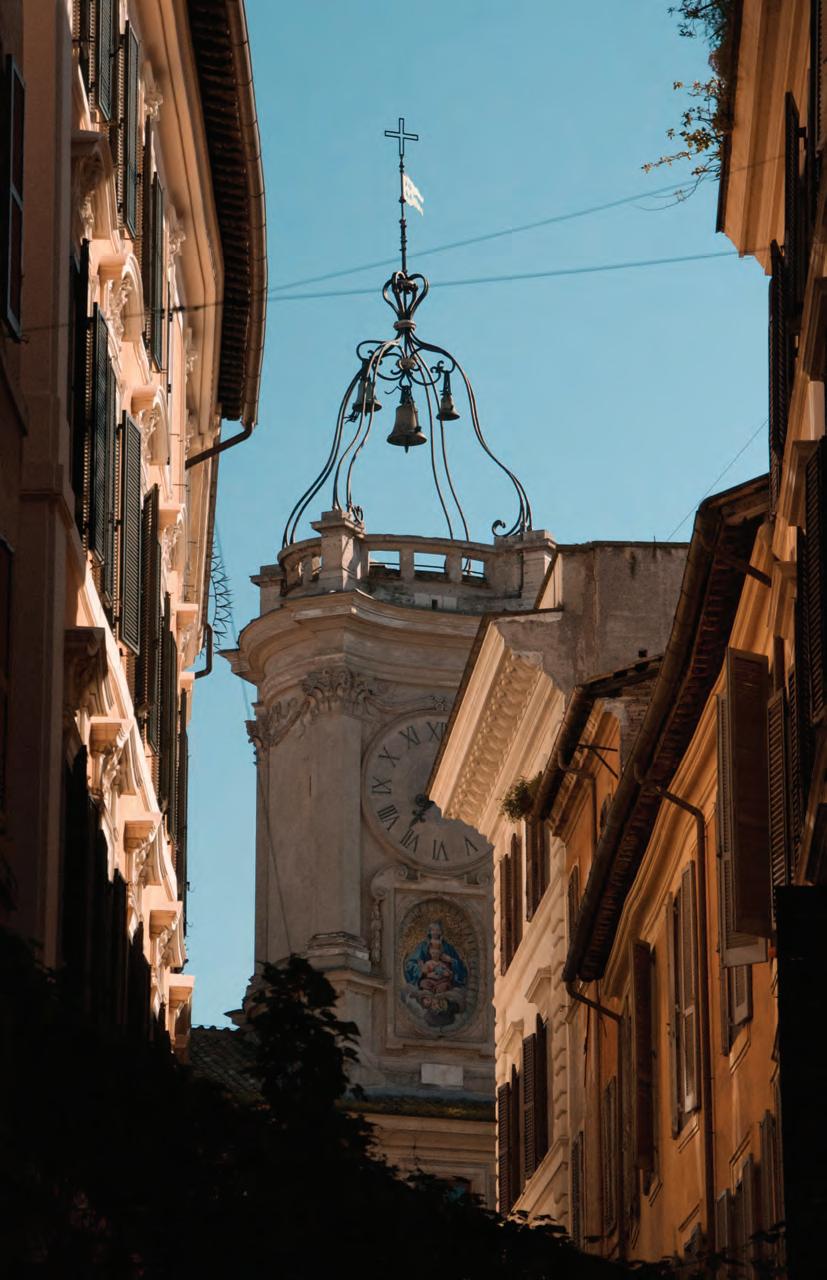
Piazza dell’Orologio, Rome, Italy [Alberto García de la Puente Stanley]
Into New Worlds:
Recounting the Tongariro Crossing with a Maōri Leader
It was the day after we had hiked the Tongariro Crossing, a legendary trail on the North Island of New Zealand that begins in the Mangatepōpō Valley, winds up and around active volcanoes, and continues down past emerald crater lakes. The volcanoes are Tongariro, Ngauruhoe (the famed “Mount Doom” in the Lord of the Rings movies), and Ruapehu. The last is New Zealand’s largest volcano and the place we called home for nine days.
We piled into our trusty white vans, littering dust of all colors on the floor from our dirty boots. We drove up to the village site through the lush jungle common on the North Island and emerged in a clearing. It was quiet at first. Only
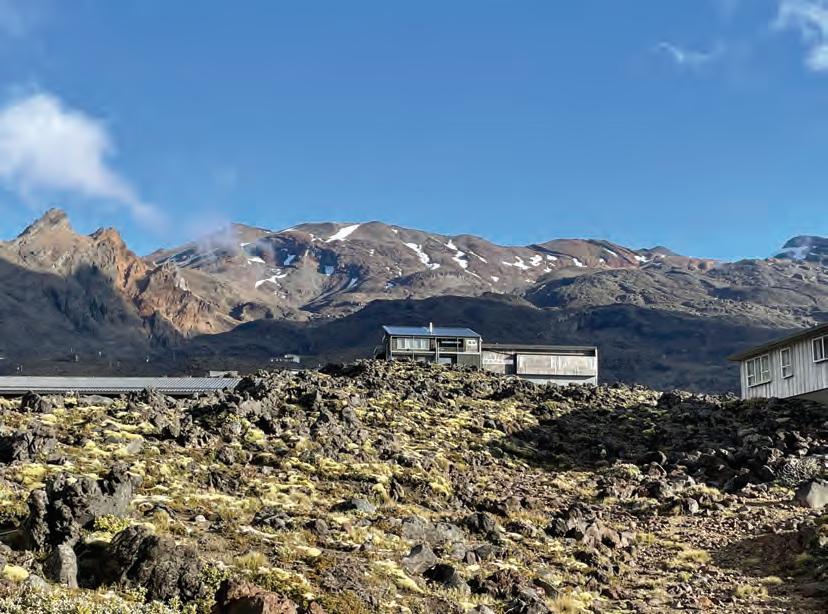
Looking up at Mount Ruapehu from our temporary home. The terrain is a lot steeper and more uneven than it looks!
Crossings II
the sounds of New Zealand’s plentiful birds were audible, but, as we adjusted to the serenity, we began to hear the familiar sound of laughter. Local kids had just returned from one of their camping trips, which are a required element of New Zealand schools. They were preparing to tramp (the Kiwi word for “hike”) the Tongariro Crossing, the track (trail) we had just done the other day. The Tongariro Crossing is a rite of passage for many North Island iwi (tribes).
We gathered around Bubs Smith, the cultural leader of the Ngāti Tuwharetoa iwi of the Opotaka kāinga (settlement). I remember the grass being soft and inviting, and I was glad to sit in a space that is so connected to the inner-being of New Zealand. While Bubs talked, I braided together strands from a fallen leaf into a bracelet; I ended up keeping that bracelet tied around my wrist for my entire time in New Zealand before it naturally fell away. He was framed by stands of trees, which opened into a view of Lake Rotoaira and the Tongariro volcano. We recognized the backside of
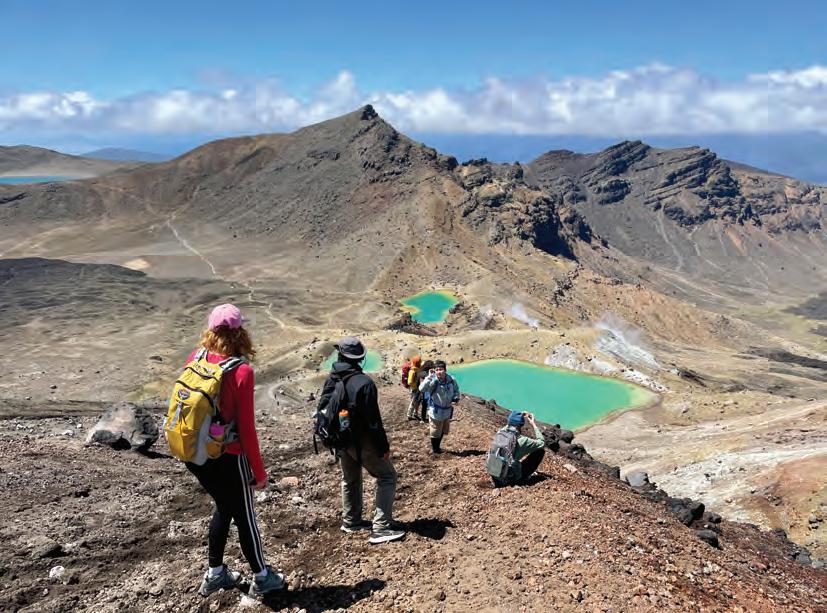
Descending a crater ridge on the Tongariro Crossing, looking out over the emerald lakes. Escaping volcanic gases give the water a bright green color.
the volcano from when we had hiked it a day earlier.
Bubs was a guide and tracker on the Tongariro Crossing and told us of his harrowing rescues on the trail. Unfortunately, many of his stories ended in tragedy. The Crossing is not a tourist attraction; it is both a sacred and dangerous journey that should be treated with reverence and caution. He did not mean to discourage us from the journey, but he wanted to caution us on the many faces that the volcano passage can show. He depicted the volcanoes and the journey as people, complete with contradictions and complexities. Like a person, it can be two things at once: salvation and destruction, life and death, a place of shelter and of danger, an attraction for tourists and an identity for the Maōri people. These qualities and the ascribed cultural significance of the volcano as a “Piece of the Universe” led to Tongariro being classified as a UNESCO World Heritage Site in the early 1990s.
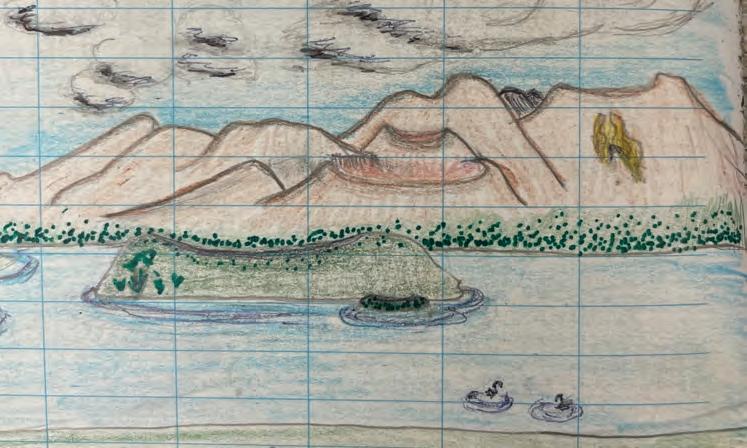
While listening to Bubs speak, I drew the beautiful view in front of me. The water is Lake Rotoaira, the volcano is Tongariro, and the wispy steam veins (right) are a sacred tribal site.
48 The Aleph
Bubs also told us about Ruaumoko, the Maōri god of volcanoes and earthquakes, who is responsible for Tongariro and all the other volcanoes on the islands. He told us that Ruaumoko is the son of the sky father, Ranginui, and the earth mother, Papatūānuku. In the beginning, Ranginui and Papatūānuku were together and there were no boundaries between earth and sky. They created many children who became the Maōri gods, one of which was Ruaumoko, who was, in fact, never born. Ranginui and Papatūānuku were separated by their children after the love affairs between the two began affecting the world around them, but Ruaumoko, the unborn god-child, was still in Papatūānuku’s womb. After they were separated, Papatūānuku was turned with her back facing the sky so that she didn’t have to bear seeing the sorrow of Ranginui. Ruaumoko was given the gift of fire to keep the earth mother warm, which explains the volcanoes that we see today.
While we were listening to Bubs speak, two mating kererū swooped from a tree behind us. A New Zealand pigeon in flight is a sight to behold; it seems too big and disproportionate to fly, and yet it is as graceful as a heron. Bubs paused as we all turned our heads in sync with the birds as expressions of both glee and awe bloomed on our faces. While the kererū is the New Zealand version of the pigeon, it is about four times as big as the pigeons that haunt American cities. One of my close friends on the program had grown up watching birds with her dad. Over the years, she has grown to love them, too, and she passed this love on to me. We would often get separated from the group as we gazed up at the tree canopy in a trance, trying to match the bird with its song.
- Maddi Meyer
a journal of global perspectives 49

50 The
Aleph
A kererū at Willowbank Wildlife Reserve in Christchurch. I saw many kererū in the wild, but none of them would stick around long enough for me to snap a photo!
My Emily Brontë
In Haworth, my room overlooks a cemetery. Although I remember climbing up the stairs, my room remains level enough with the ground, so that I can read the headstones out my window. Every once in a while, a couple passes. A bell-clock-tower chimes when it is time for the bell-clocktower to chime. Time is passing and I am in England, alone.
The Old church tower and Garden wall
Are black with Autumn rain, And dreary winds forboding call
The darkness down again
I have had a wish, or some may say a love, for Emily Dickinson for half of my life. Since I was 11, the belle of Amherst’s call rang through my ears. A bookshelf in my childhood bedroom is lined with edition after edition of Dickinson’s collected works. A poster from the Emily Dickinson Museum in Massachusetts, posted on my yellow walls.
Some - keep the Sabbath, in Surplice -
I - just wear my WingsAnd instead of tolling the bell, for church -
Our little Sexton - sings.
Born in Amherst, Massachusetts, Dickinson was unlike her contemporaries. Even before the invention of jet fuel, individuals of Dickinson’s social standing and wealth would make trips to Europe. Susan Huntington Gilbert Dickinson, Emily Dickinson’s sister-in-law, would make this trip later in her life, as afforded by the financial standing of the Dickinsons. However, the farthest Emily Dickinson traveled in her life was to Washington D.C.
a journal of global perspectives 51
Crossings III
When I arrive in Haworth, I have been traveling for about a week. Although I have lived adjacent to pastures my entire life, the rural of Upstate New York is nothing like the hills of Haworth. Each street is carefully cobbled so that my small carry-on teeters, stone by stone, up the hill and to my accommodation: a bed and breakfast located above a pub called the Black Bull Inn.
But lovelier than corn-fields all waving
In emerald and scarlet and gold
Are the slopes where the northwind is raving
And the glens where I wandered of old -
In 1985, Susan Howe wrote My Emily Dickinson, an attempt to evoke a poetic lineage. Howe claims Dickinson and frees her from the Victorian ideology of her original editors, Mabel Loomis Todd and Thomas Wentworth Higginson. Dickinson’s first editors ignored her poetic irregularities, “Who is this Spider-Artist? Not my Emily Dickinson.”
A Clock stoppedNot the Mantel’sGeneva’s farthest skill
Can’t put the puppet bowingThat just now dangled still -
Haworth, England is part of the geographic area affectionately called “Brontë Country.” First established as a settlement in 1209, Haworth is where the priest Patrick Brontë eventually settled with his six children at the aptly named “Brontë Parsonage.” It was here that Charlotte, Emily, Anne, and Branwell, the Brontë siblings, lived. It was in this house that Charlotte, Anne, and Emily found their literary success.
52 The Aleph
Why do I hate that lone green dell?
Buried in moors and mountains wild
That is a spot I had loved too well
Had I but seen it when a child
Emily Dickinson, the rare traveler she was, spent most of her time in her room. Dickinson’s poetic genius was contained, but not prohibited, by the confines of her room. Left in Dickinson’s wake were 2,500 poem manuscripts and 1,000 letter manuscripts. Dickinson’s most intense writing period was from 1858 to 1864, where she collected up to 800 of her poems in sewn-together, book-like fascicle editions.
Nature rarer uses Yellow
Than another Hue -
Saves she all of that for Sunsets
Prodigal of Blue
The bell-clock-tower chimes out my window on Tuesday morning. It belongs to the St. Michael and All Angels Church where Patrick Brontë served as incumbent, prompting the family’s move to Haworth. I set out on a short walk to the Parsonage. The April sun is warm enough on my back to offset the morning chill blowing over the moors. The Parsonage is clearly made from light-colored brick but appears yellow in a print I buy from the gift shop, reminding me of Dickinson, of Amherst, of the homestead, of home.
Spending Scarlet, like a Woman
Yellow she affords
Only scantly and selectly
Like a Lover’s Words -
Dickinson is American, as am I, yet I never felt my Americanness before crossing the Atlantic. In Maastricht, where I am living for the semester, my Americanness follows me
a journal of global perspectives 53
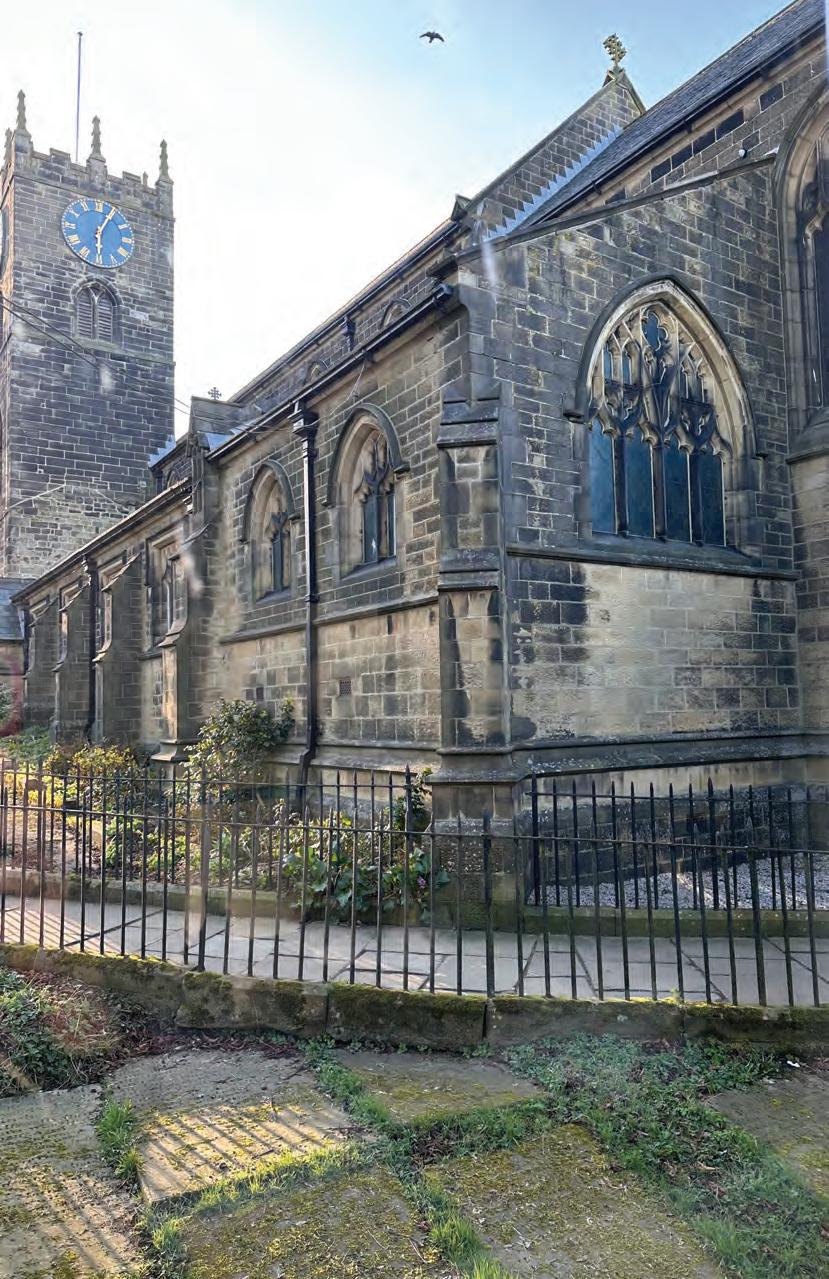 St. Michael and All Angels Church, Haworth, England [Katelyn Weeks]
St. Michael and All Angels Church, Haworth, England [Katelyn Weeks]
shamefully. I shop at Jumbo but think of Trader Joe’s back home. I think of my girlfriend in Buffalo, New York, slipping on ice in her parking lot. She is walking to her uniquely American car, bigger than any we’d see packing the streets of Maastricht, as we spend more time speeding through the wind, rain, and snow on our bikes.
In Haworth, I am most interested in the poetry of Emily Brontë. My tour guide comes prepared. We traverse the Parsonage together, him equipped with a collection of Brontë poems which he reads in each room. In the center of the living room is a big wooden table. My guide tells me stories of the sisters staying up late at the table after everyone had gone to bed. They were each other’s best editors and readers. In the living room, I imagine Emily Brontë, like Dickinson or Cohen. I look to the window, seeking to know where the light comes in.
Cheerful is the hearth, soft the matted floor
Not one shivering gust creeps through the pane or door
The little lamp burns straight; its rays shoot strong and far
I trim it well to be the Wanderers guiding star -
The Brontë children were an imaginative group, living both in the material world and out of it. They created imaginary worlds, imagined people, imagined wars. The children’s play was like any other, except it was recorded. The Parsonage contains remnants and record of Angria and Glass Town but remarkably missed Gondal, the world of Emily and her sister Anne. My guide tells me the museum holds no record of Gondal because it is unclear if Emily and Anne ever recorded its history. We know of Gondal only through the sisters’ poems and writings. As I observe the miniature
a journal of global perspectives 55
print of Charlotte and Branwell, contained in the books of Angria and Glass Town, I conclude. In her home, my Emily Brontë still resists a desire to be known.
At the end of the tour, my guide leads me into the library and to the archives. The curator shows me a manuscript of Anne Brontë and some other papers, but the centerpiece is a little book. Across the Atlantic, the Brontës were participating in bookmaking, in fascicle editions. The miniature book is a collection of poems Charlotte had written at thirteen, most of which have never been published. The curator holds the book close to my face, close enough for me to inspect her tiny print.
Emily Brontë, like Emily Dickinson, never imagined being published. It was her sister Charlotte who convinced her to publish her widely recognized novel Wuthering Heights. As far as her poetry is concerned, Emily Brontë’s desire to write for herself is clear. In her poems, my Emily Brontë is elusive, writing for herself, writing of Gondal, writing of worlds out of reach of our contemporary understanding, of her audience.
The night was Dark yet winter breathed
With softened sighs on Gondals shore
And though its wind repining grieved
It chained the snow swollen streams no more
Before I leave the museum, my guide excitedly pulls out the visitors’ book. I must have mentioned I was a fan of Virginia Woolf, or he assumes this of all literary types, but I listen as he explains how the museum has recently found Virginia Woolf’s entry in the guestbook. She signed under her maid-
56 The Aleph
en name, visiting long before she married Leonard. She was twenty-two, a year old than I am as I observe her curling script in the guestbook: Virginia Stephen - Nov. 24, 1904.
Virginia Woolf’s first published essay is about her visit to Haworth, aptly named “Haworth, November 1904.” The essay appeared in The Guardian in December 1904. Woolf’s impressions of Haworth are much like mine. “The church, the parsonage, the Brontë Museum, the school Charlotte taught, and the Bull Inn where Branwell drank are all within a stone’s throw of each other.” Haworth has not increased in size, and the monuments Woolf mentions I stay in, I walk by, I observe during my visit in April of 2023. Woolf, like me, recognizes the ghost shade of yellow found haunting

a journal of global perspectives 57
Afternoon in Liberty Square, Budapest, Hungary [Lucas Gillespie]
the buildings in Haworth, calling the brick making up the Parsonage, “ugly yellow-brown stone.”
After my visit to the Parsonage, there was one thing left to explore: the famed moors. I started out on a hike to Top Withens, the decayed farmhouse said to have inspired Emily Brontë’s Wuthering Heights. The walk starts off heavily populated but becomes increasingly more rural. I pass through gate after gate, used to keep the sheep restrained to one area or the other. The only object in my eye line is the farmhouse structure, setting gloomily on the horizon, and lingering over the moors.
And the wind swept past her hopeless ear
Was nought earth so wildly drear
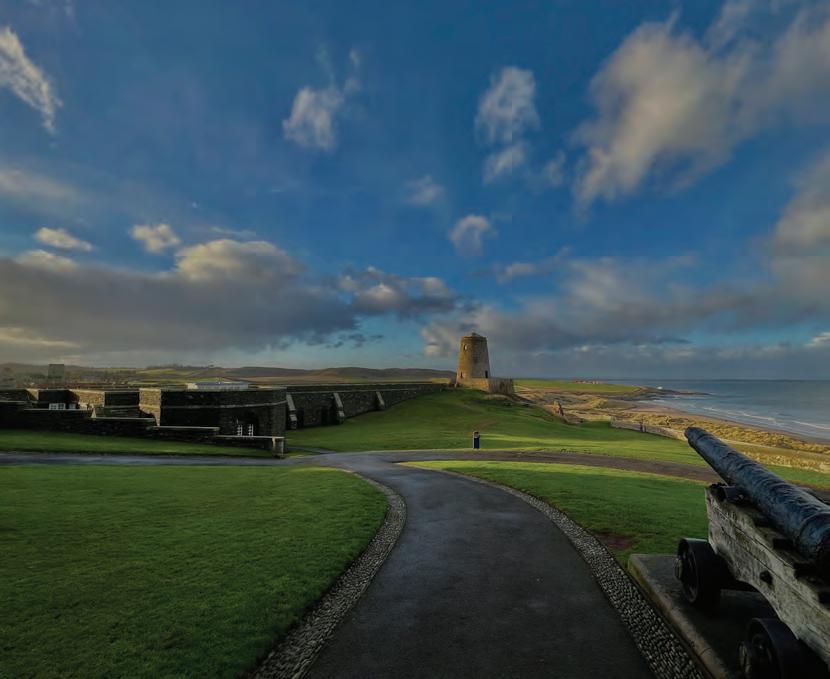 The Windmill, Bamburgh Castle, England [Jacob Newman]
The Windmill, Bamburgh Castle, England [Jacob Newman]
I reach the decayed farmhouse, Top Withens, about an hour and a half later. At the summit, I sit on a bench overlooking the moors. On the top of the moors, I feel like I am hearing the wind for the first time in my life. Rushing over the moors, I want to call the gesture of the wind “the whoosh of the brush.” On top of the moors, I think of tradition, of the poets who have tried to depict this version of natural silence and never can. I think of my attempt to get the real to stick to the page, like Spicer, like lemons, like poetic theory. I think of the potential futility of poetic gesture, and how to be witness to it all, anyway.
Between the March and April line -
That magical frontier
Beyond which summer hesitates,
Almost too heavenly near.
On my return from Top Withens, I pass what the locals, and consequently the tourists, call the “poet seat.” A chair-rock stands tall next to the riverbed I meant to cross on my way down. Inscribed with the initials C.B, legend goes this was the seat of Charlotte Brontë. I take a seat, and, as silly as it may be, I feel converged with history. All at once, I am in Emily Dickinson’s bedroom. I am in the Brontë’s Parsonage. I am sitting on a bench overlooking the moors. I am sharing a seat with Charlotte Brontë. This is how we trace poetic lineage. In tactic, in form, in worldliness.
Heavenly Hurt, it gives us -
We can find no scar,
But internal difference -
Where the Meanings, are –
Much later, upon my return, somewhere in Upstate New York, I came to the realization that anyone, tourist, local, Brontë, or other could have inscribed C.B into the chairrock. Yet in England, the chair-rock was a tactile reminder,
a journal of global perspectives 59
a talisman, a touchstone, a line from the Brontës to Virginia Woolf, back to America, to Amherst, to Dickinson, to Howe. A line from Emily to Emily. A line across the Atlantic, a line back to me.
- Katelyn Weeks
Author’s Note: Both Emily Dickinson and Emily Brontë often did not title their poems, so the poems are referred to by their first line. Throughout the piece, poem fragments attributed to Emily Dickinson are on the left and those from Emily Brontë are on the right. The selected poems are listed below in order of appearance.
Dickinson poems from “Emily Dickinson Poems As She Preserved Them,” edited by Christine Miller (2016):
1. “Some keep the Sabbath going to Church - ” (115)
2. “A Clock Stopped - ” (127-28)
3. “Nature rarer uses Yellow” (485)
4. “The saddest noises, the sweetest noise” (690-91)
5. “There is a certain Slant of light” (153)
Brontë poems from “The Complete Poems of Emily Brontë,” edited by Derek Roper and Edward Chitham (1995):
1. “The old church tower and the garden wall” (44-45)
2. “Loud without the wind was roaring” (66-68)
3. “Why do I hate that lone green dell?” (53)
4. “Silent is the House - all are laid asleep” (176-81)
5. “The night was dark yet winter breathed” (73-74)
6. “And wind swept past her hopeless ear” (205)
60 The Aleph
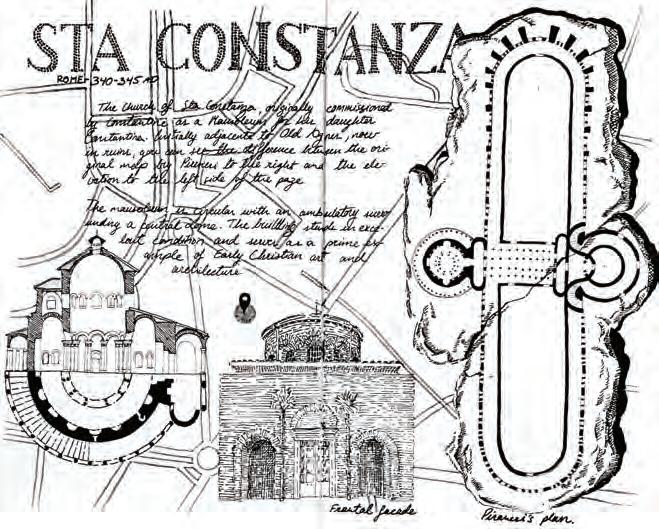
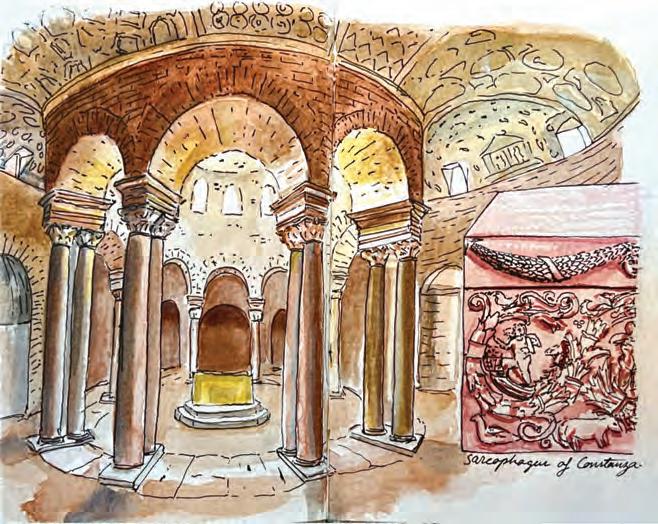
a journal of global perspectives 61 Sketchbook I
Santa Costanza, Rome, Italy [Alberto García de la Puente Stanley]
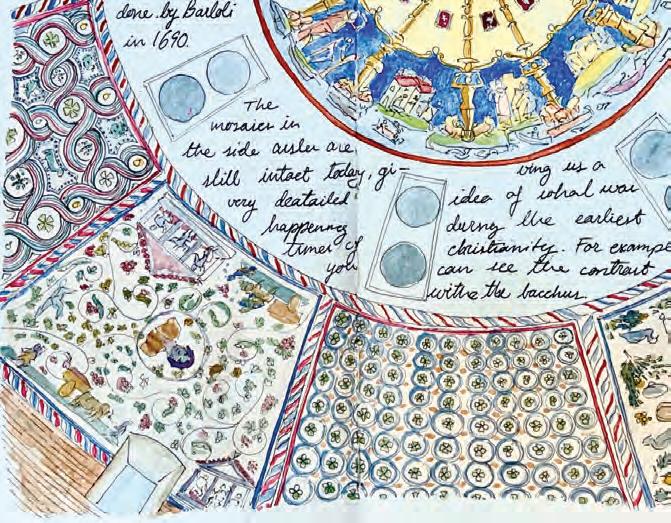
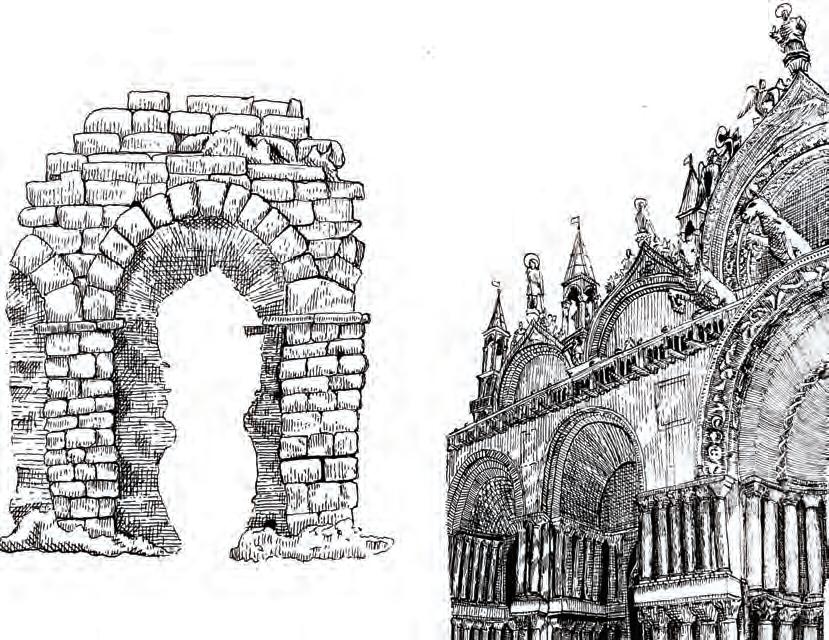 Dome of Santa Costanza, Rome, Italy Pen and Ink Sketches of Rome and Venice, Italy
Dome of Santa Costanza, Rome, Italy Pen and Ink Sketches of Rome and Venice, Italy
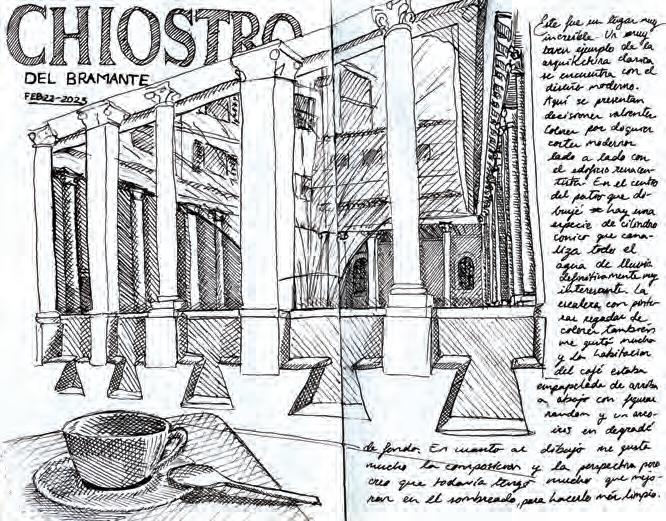
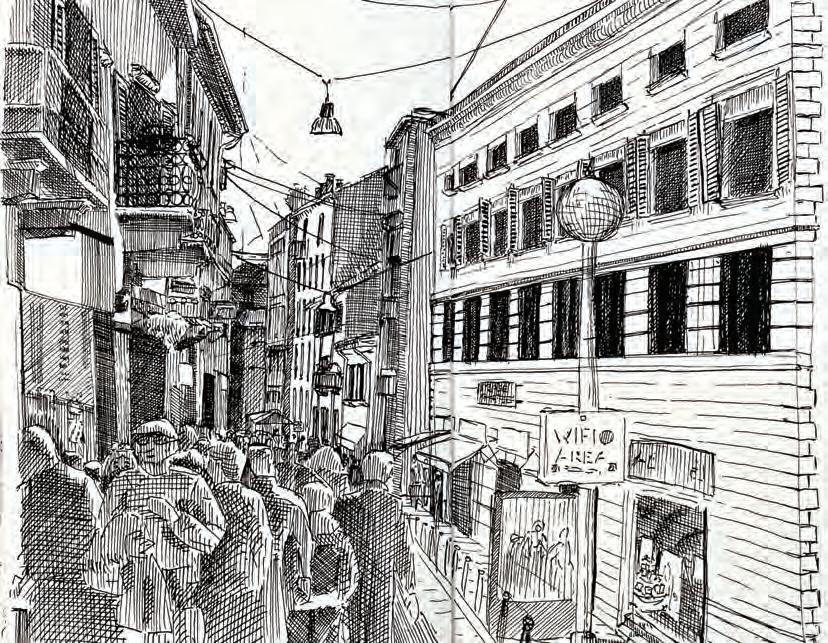 Chiostro del Bramante, Rome, Italy
Pen and Ink Sketch of Milan, Italy
Chiostro del Bramante, Rome, Italy
Pen and Ink Sketch of Milan, Italy
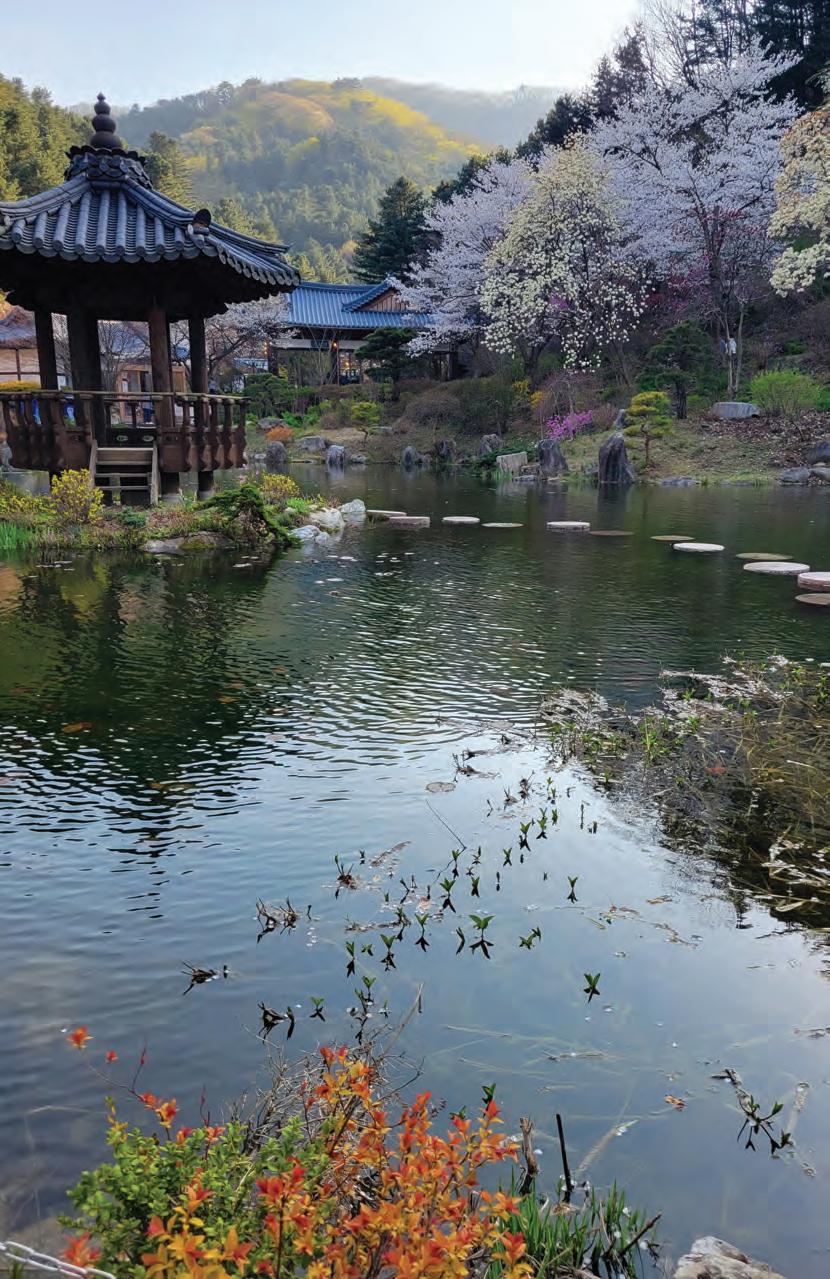
2. an occurrence that reveals, warns, or enlightens Nami Island, South Korea
LESSONS
n.
1. a thing learned by experience
[Lexi Hansen]
LESSONS I
The Blasket Islands: Lessons in Isolation
The history that surrounds us throughout Ireland is rich, and there is always more to see than meets the eye. Looking at things at first glance and not noticing the layers that lie beneath will never allow you to see the full beauty of what you are observing. With such limited time here, I have found myself taking advantage of traveling within Europe while simultaneously missing the home I have made for myself in Galway. I sometimes dread leaving, taking a three-hour bus to Dublin, and then a minimum flight time of two hours to my destination for the weekend. I wonder what I’m leaving behind: my warm bed in comparison to a $200 place to sleep; the Saturday Market art traded for postcards of places I may only visit once; my free Friday exchanged for a day spent plugging my nose to un-pop my ears and a late arrival in a foreign city.
My favorite weekends have been the ones where we are exposed to all that is below the surface of modern Ireland. The Blasket Islands were a force of isolation, resulting in peace and communion with the small number of inhabitants they hosted. Driving on windy roads, skimming each corner, our group of 16 found ourselves among these quiet islands. Hearing the sounds of the waves splashing the rocks, we all seemed to slowly regain any sense of peace that was missing since we left home. Stopping to see the coast at all angles, Eric, our driver, saved us from teetering
a journal of global perspectives 65
off the edge, following the path of the hills. We put all of our trust in him, which added to the weight of all the luggage we packed for just a two-night excursion.
The Islands were home to few, but those that inhabited them never had the intention of leaving. Looking at the small number of houses slanting over the cliffs, I thought about how the maximum population here at one time was 160 people. It was a simple life. I thought about all the things I miss from home such as a good dryer, prepared food, and the ability to take a hot bath. They had none of that, nor did they ever think to miss it. Happy with what they had, their community was strong through a lack of interference from the outside.
The Irish language on the Blasket Islands was an idyllic form of authentic spoken Irish, with thick accents that would be almost incomprehensible today. They spoke a specific variation of the Munster dialect, developed on the Islands and
 Proud Mary Lighthouse, Holyhead, Wales [Jordan Britton]
Proud Mary Lighthouse, Holyhead, Wales [Jordan Britton]
less influenced by English, other languages, or modernization. Though this type of Irish may have been isolating, it brought the community closer together.
The power of human connection is seen most profoundly through language assimilation. When I see a member of our group on campus or downtown, there is a sense of comfort that washes over me. There is a built community that forms within our own dialect and place of origin. For people on the Blasket Islands, hearing that specific Irish accent must have triggered a sense of community although the individuals may have once been strangers to each other. That’s how we arrived in Galway, strangers, and yet we still always look to each other for a sense of community and connection.
As I walked around the Blasket Centre, there was visual art catching my eye at every corner. Old photos of the people on the Islands, picturesque photographs of the beaches, and sounds playing overhead letting you experience the wind or rain they heard more often than was likely wanted. For some reason, I felt jealous. Their isolation seemed to be something they had grown used to. I thought of the greed I feel to see all of Europe, all I can get my hands on. How I feel like I don’t have enough time in my life to see it all, while also not seeing everything that’s in front of me in Galway. The people of the Blasket Islands were happy with all that surrounded them; the community was enough.
In the museum, I found myself paying more attention to the words than to the images. The writing on the walls intrigued me. There were great contributions to literature that came from these islands, including Peig Sayers and Tomás O’Crohan. It made me consider whether that isolation and all that time to think would make one infinitely wise. On the Blasket Islands trip and others where we’re given a time constraint, I try to take a few minutes to sit
a journal of global perspectives 67
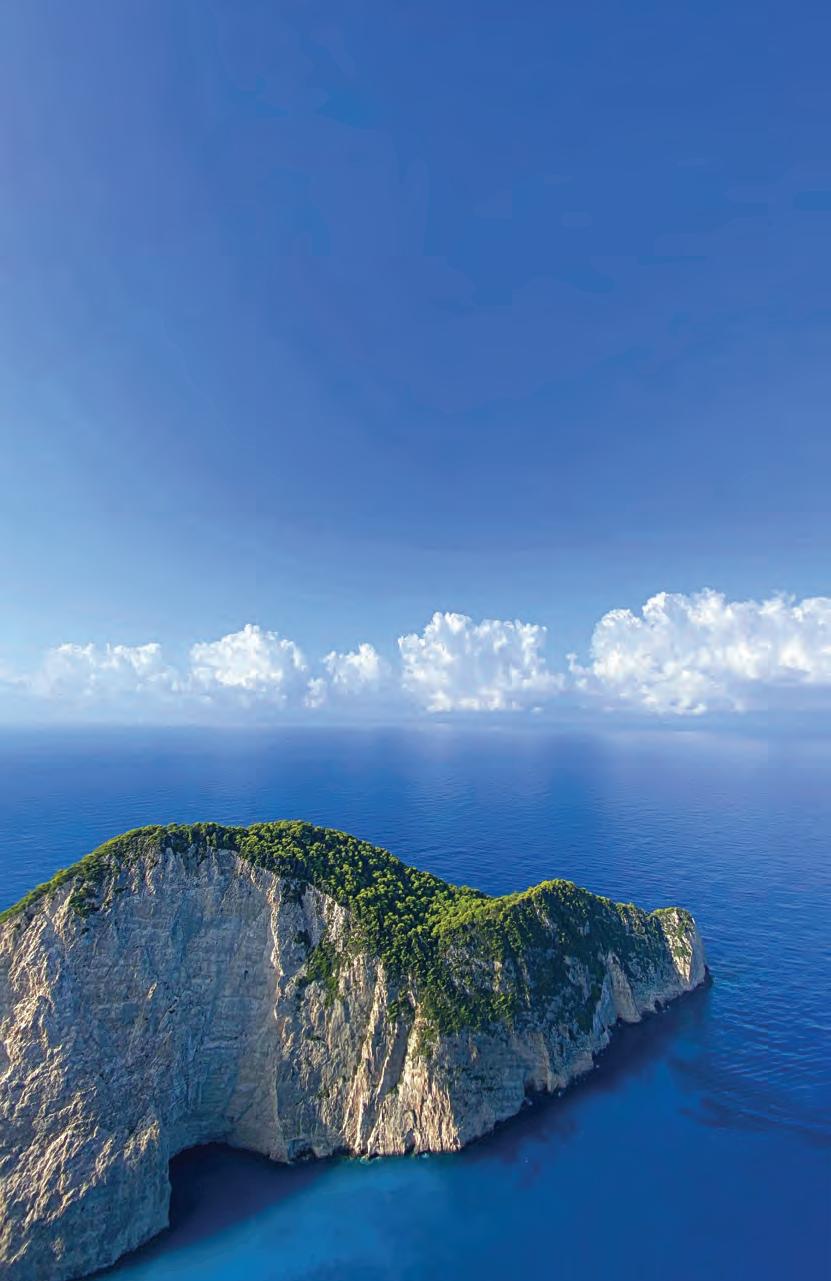
Rock Formation near Shipwreck Beach, Zakynthos, Greece [Eastwood Yeboah]
alone and take in where I am, to take a mental picture, a mental note, a moment of gratitude. I’m sure if I had more time, I may understand some of the perspectives of these individuals who spent so much time alone by the sea.
Peig Sayers embodied isolation, resulting in wise words and timeless lessons. An infamous Great Blasket Island name, Peig married into living on the island. As a poor woman writing in this era, she became a scandal. The thing is, it wasn’t exactly her writing: it was her son’s translation of her words. There are some ideas, thoughts, and moments that can never fully make it onto paper. Seeing the sea that kept the secrets of those who once lived there and cliffs that no one would dare to scale - putting moments like that into words is a big ask. Peig may have felt the same. One can only hope her son was able to convey the gravity of her words as soon as they left her lips.
The lessons learned by the people on the Islands are things that carry into modern life more than one might expect. They were minimalistic, happy while having so little as long as they trusted those around them and had music. Music has always been an integral part of Irish culture and communities come alive every time it’s heard. Walking through Galway’s Shop Street on a gloomy day and hearing a local musician playing for those around him could almost make the sun come out. As you keep walking and the music starts to fade, another artist comes into earshot, playing for enjoyment and any coins one has left in their pocket. These artists light up the streets of Galway and put their culture on display for any visitor or local to enjoy.
This minimalism pushed those on the Islands to appreciate the weekly post brought from the mainland and church every Sunday. The minimalism we have brought with us to Galway, bringing only what the airline would allow, staying under that weight limit has pushed us to appreciate com-
a journal of global perspectives 69
ing back to our made-into-home rooms and a warm shower (when lucky).
By 1953, the Islands’ population had decreased to 22 people. On November 17, 1953, the government evacuated the remaining residents due to extreme winter weather that cut off the islands from emergency services. Being forced to leave the place where you have made a home is an uncomfortable period of transition for anyone. We went through a transition like this one on a much smaller scale. And by choice, unlike the inhabitants of the Blasket Islands, I made Galway my new home and therefore owe it my time. Transitions are hard nonetheless, but I realized they are much easier once I dedicate myself to my surroundings and don’t flee at every opportunity. This period of transition and continued adjustment will be uprooted again once I get on a seven-hour flight back home. There I will be met with another set of challenges. I may again feel isolated after spending so much time among the rich history of Ireland.
These weekends have immersed our group in the Irish culture that surrounds us. I began this semester more excited for what I would explore outside of Ireland but now I appreciate the time we spent building our community in isolation. We have gained a greater understanding of all that we walk on and the implications of our own existence in new communities. I spend a lot of time greedy for more, but in these moments when we are immersed in the slow, quiet way of life on the Blasket Islands, I am happy with what I have. Trust in our Irish guide John Brady to show us the best places and the knowledge that surrounds them, trust in Eric with our lives on roads I know we couldn’t drive on our own, and trust in our group’s childlike curiosity with each place we’re taken. Stopping at each sign that advertises “hold a baby lamb.”
- Ella Weiss
70 The Aleph
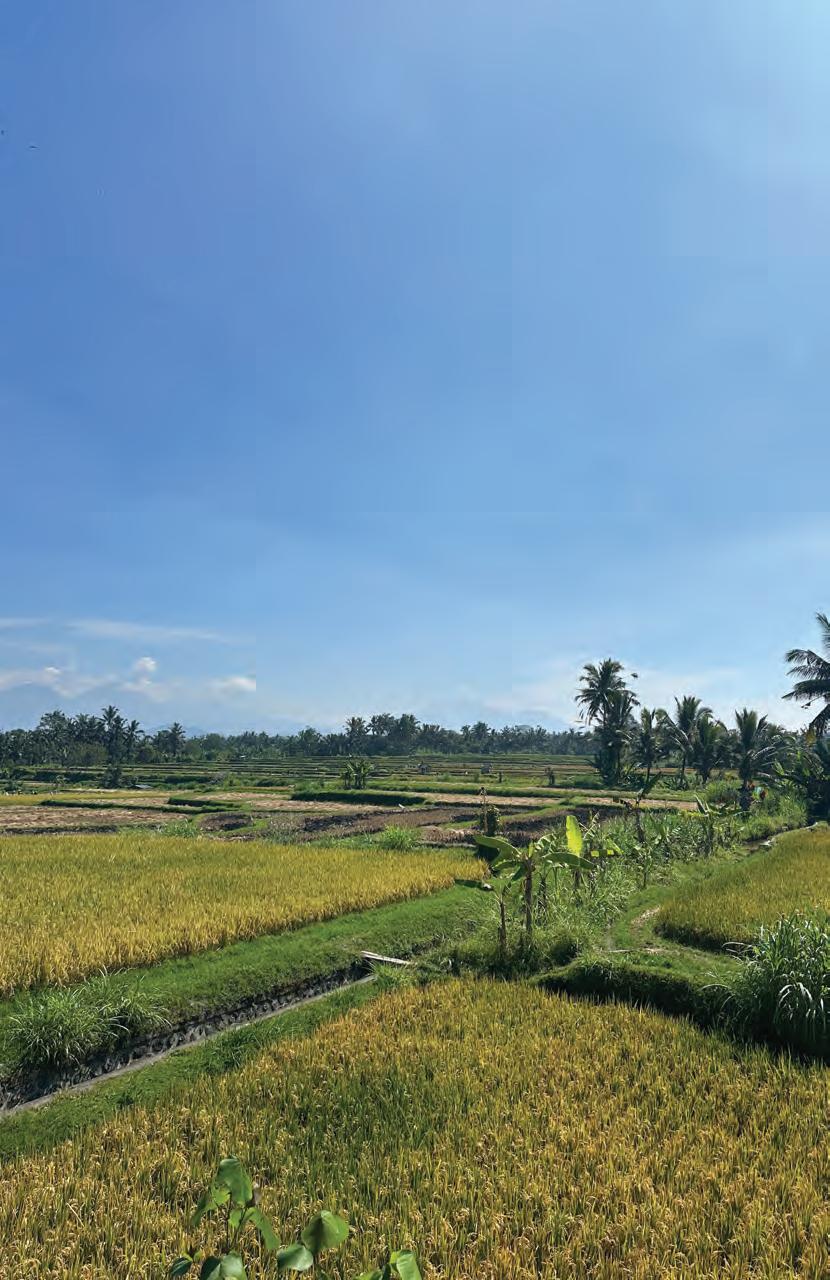 Rice Fields in Gianyar, Bali, Indonesia [Cayden Smith]
Rice Fields in Gianyar, Bali, Indonesia [Cayden Smith]
Messing in the Mensa
Throughout my entire childhood, I was never the person to try new foods, drinks, or anything like that. Simply put, I am a very picky eater, or at least I was. I stuck to what I knew and everything else either looked gross, smelled gross, or felt gross. Yup, you probably guessed it: buttered pasta was my favorite and most common meal. Not only had I never tried any German cuisine before coming to Germany, but there were so many spices and tastes that I had never sampled. Trying new foods has been an important goal I have pushed myself to pursue for the past year or so. I am hopeful to redevelop my palette while I am here in Leipzig and return home with a broader diet.
Now, let me tell you about the German Mensa, which is essentially a dining hall. Before I begin, it is important to understand the distinction between die Universitätscampus in Germany and university campuses in the US, specifically universities in cities. Instead of having a central location for all academic buildings, student dorms, and athletic facilities, these three elements of German campuses are spread all over the city. In contrast to HWS, there are eight Mensen and four cafeterias across the city dedicated to the students of Universität Leipzig. I have visited three Mensen, the smallest of which is roughly half the size of the dining hall at HWS. The largest is almost double that size, including a second floor and an outside entertainment plaza. I finish class in the afternoon around 2:30 and, by then, the smaller Mensen closer to the Physics Department have closed. Usually, I make the trek over to the main campus Mensa, Mensa am Park, in Zentrum. The 20-minute walk only fuels my hunger for delicious German meals.
These three Mensen where I often find myself sampling German cuisine are: Mensa am Park, Mensaria am Botanischen Garten, and Mensa und Cafeteria am Medizincampus. All
72 The Aleph Lessons II
Mensen work in a similar fashion to school cafeterias in the US. There are multiple stations offering different foods, including Fleisch, Fisch, Pastateller, veganes Gericht, and Salat, along with pizza, dessert, smoothies, and, of course, many different coffee drinks. Rather than having a prepaid meal plan that determines how often you can access the dining facilities like we do at HWS, in Leipzig you pay for every meal individually by loading cash onto your student ID, which I prefer. The food in the Mensen is also pretty cheap. A full meal (a food item, drink, and dessert or smoothie) will usually cost around 10 euro. There is a new menu almost every day, and the food is served hot and fresh. I still
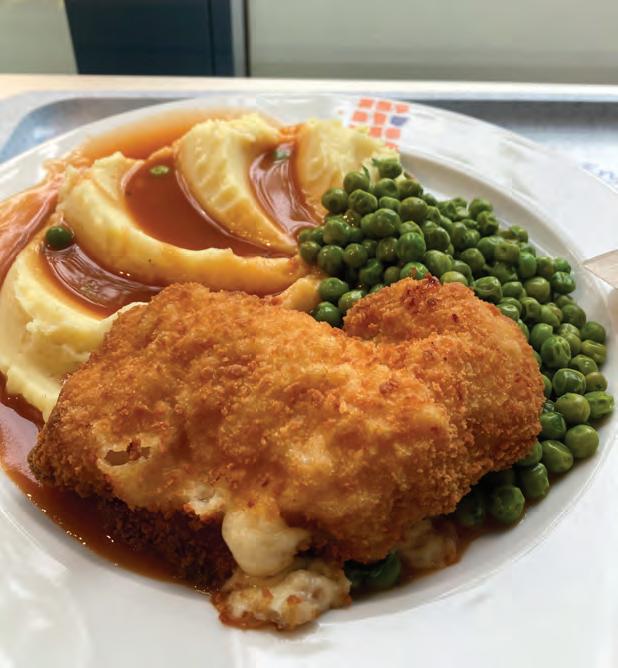
Hähnchen Cordon bleu mit Putenschinken & Käse gefüllt; Erbsen; Kartoffelpüree, Leipzig, Germany [Will Russell]
a journal of global perspectives 73
have yet to repeat a meal and it’s already been four weeks! Some of my favorite dishes so far are:
Gelbe Paprikaschote mit Rinderhack gefüllt; Couscous; Tomatensoße (a stuffed pepper filled with beef on top of couscous and tomato sauce)
Rinderfrikadelle mexikanischer Art mit Kidneybohnen; Thymian-Kartoffeln (Mexican beef alongside regional Kartoffeln and beans)
Buntes Wok-Gemüse mit Basmati Reis (mixed vegetables and rice)
Hähnchen Cordon bleu mit Putenschinken und Käse gefüllt; Erbsen; Kartoffelpüree (chicken cordon bleu with peas and mashed potatoes)
Schweinerückensteak mit Zwiebeln und Käse überbacken (pork steak topped with onions and melted cheese)
I genuinely love what the Mensen serve, and I’ve never heard of or seen half of these things before. There are so many unique dishes that you would not be able to try elsewhere, especially as a student, and I honestly didn’t expect to ever find a decent meal served in a dining hall.
Not only are the Mensen important for the food and drinks they offer, but also as an area for recreation, relaxation, and social bonding. They are a very popular location for hanging out and play an important role in a university student’s day. There is a constant whirl of motion, much different than the dining facilities at HWS which I usually find dead outside of the strict meal hours. In all fairness, Universität Leipzig does have a population of approximately 35,000 students, which dwarfs the population of HWS.
I am grateful to have the opportunity to investigate this niche of German cuisine and push myself to personally experience the culture while I am here, with, of course, the added benefit that the food tastes INCREDIBLE!
74
Aleph
The
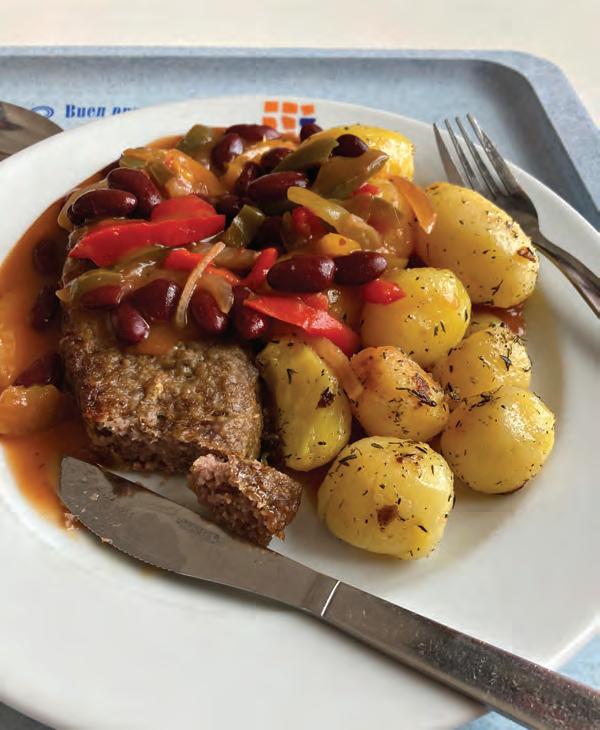
Rinderfrikadelle mexikanischer Art mit Kidneybohnen; ThymianKartoffeln, Leipzig, Germany [Will Russell]
A few months after my return from Germany and I am willing to try any food offered to me. Spice is still something I am working on, however.
- Will Russell
a journal of global perspectives 75 • • •
Can We Travel the World Through Just a Bottle of Wine?
“A bottle of wine contains more philosophy than all the books in the world.” - Louis Pastuer
The course was titled “Wine, Gastronomy, and Sustainability of the Mediterranean Basin,” lasting three weeks and spanning three countries. I tried over 50 wines and studied more than 20 different wine regions. Beyond all of this, I gained an appreciation for where wine comes from and a special ability to travel the world without even leaving my town.
The French have a term - terroir - that has no direct English translation. Rather, it is more of an idea or guiding principle used to understand a wine both before it is produced and as it is being enjoyed. Terroir has five main parts:
The grape vine biology: this involves anything from type of grape to the age of the vine.
The location: this brings in the history and tradition of a region, encompassing its farming techniques and how the wine is recognized.
The climate: think of the temperature, the wind, the precipitation, the amount of sun, etc.
The soil: this could mean soil type - limestone, silt, clay, etc. - the minerals in the soil, or even the slope of the land.
The people: the vignerons, vineyard hands, winemakers; everyone involved with the production of each bottle.
All of these pieces come together to create a wine that is locally distinct. Terroir is the basis for the French wine regions with historic boundaries marked to delineate different Appellation d’origine controlee regions like Burgundy,
76 The Aleph Lessons III
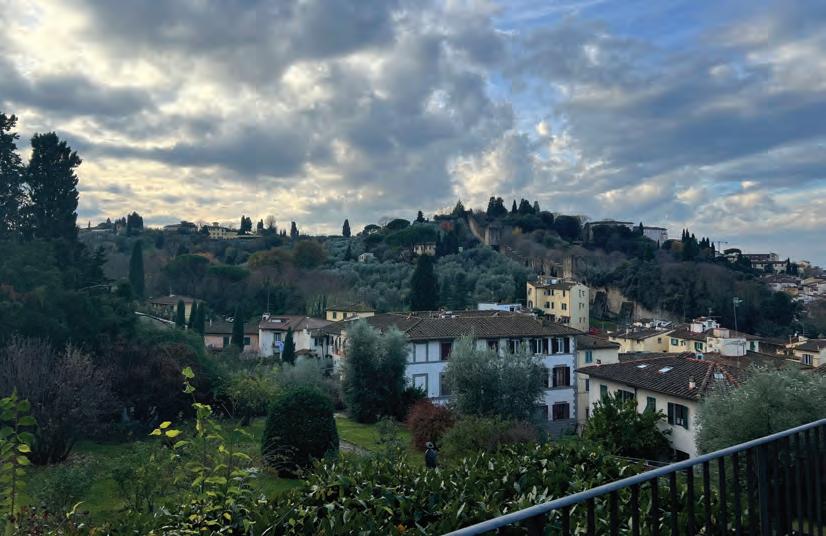
Champagne, and the Loire Valley. These regions can then be further subdivided into an area as small as an individual field with less than 100 vines. A similar system of localized classification is found in countries like Italy and Spain, which is why we have notable wine varieties like Barollo, Chianti Classico, Cava, and Tempranillo. This means if you are drinking a classified wine, you are experiencing more than just a grape variety, you are experiencing a place.
If I were to try the Domaine Tempier Bandol 2021 Rosé again, I might be transported back to the South of France where I stood outside the robin’s egg blue wine cellar door. The unique spiciness of the wine would make me think of the mourvédre grapes that are required to make up 50 percent of blends produced in Bandol. I could taste the apple, cinnamon, and red berry that would be unique to a Bandol region rosé.
If I were to have a sip of the Entre Amics Blend produced by Boquet d’Alella from the Alella region outside of Barcelona, Spain, I would be transported back to my memories of barbequing on the vineyard cuesta. In my journal, I described
a journal of global perspectives 77
The Hills of Florence, Italy [Jacob Newman]
the wine as “location in a bottle.” The bright citrus and pear notes combined with minerality present in the wine’s taste would remind me of the rocky, sloped setting and the sunny day that I visited.
These tastes do not only work in the past tense though, transporting me back. We can learn to taste and travel in the present. Terroir lets us glimpse into little towns, small vineyards, and even plots of land. We can think about the weather in an area or if we are surrounded by hills. When we drink wine, we can take time to taste and decode, allowing us to understand what came before. Then, with a little imagination, we can be transported to that setting, wine glass in hand. This skill lets us all be connected back to our times abroad in addition to our traveling dreams.
- Heather Kerns

78 The Aleph
Door to the Wine Celler, Domain Tempier, Le Plan du Castellet, France [Heather Kerns]
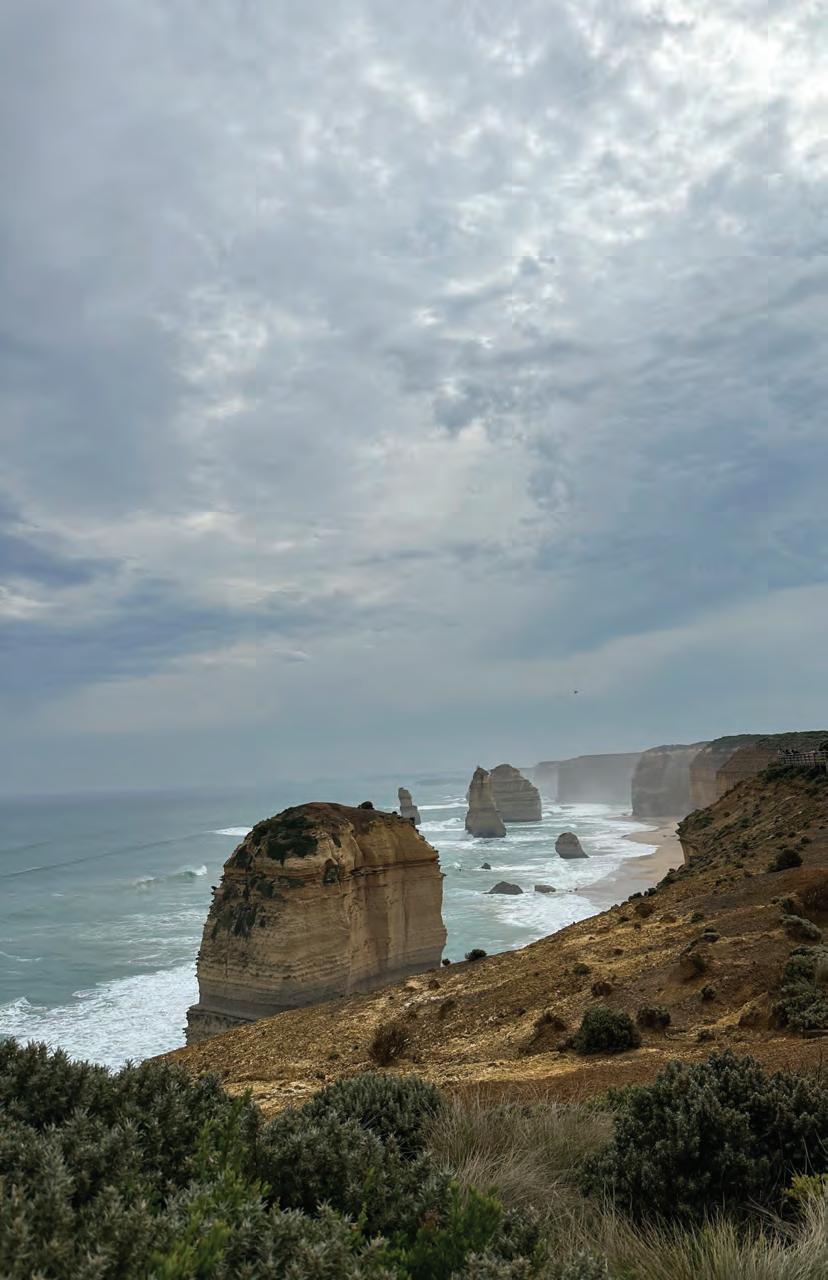 The Twelve Apostles from the Great Ocean Road, Victoria, Australia [Cayden Smith]
The Twelve Apostles from the Great Ocean Road, Victoria, Australia [Cayden Smith]
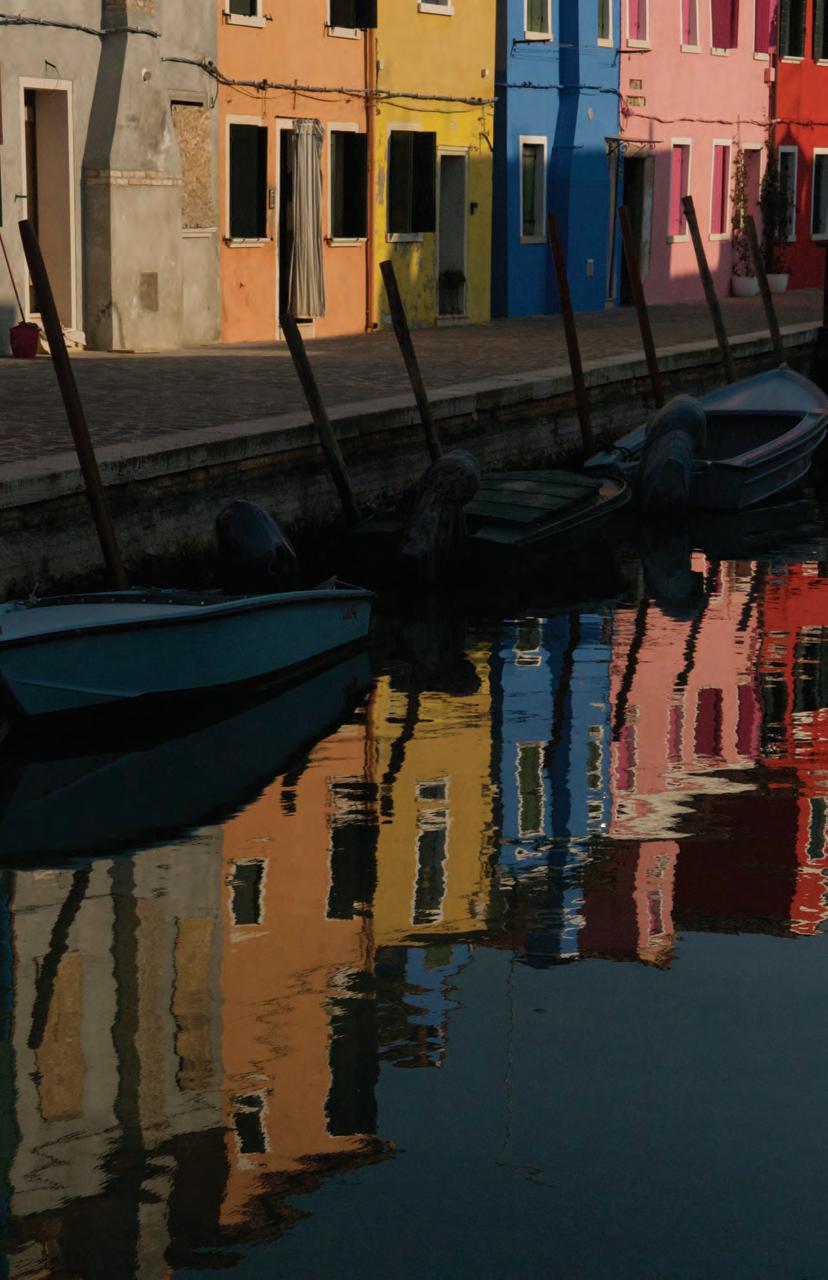
REFLECTIONS
n. 1. the product of a reflective surface or mirror
2. the effect or product of an influence
3. an opinion, realization, or thought formed as the result of consideration of an idea or experience
Colorful Reflection, Burano, Italy [Alberto García de la Puente Stanley]
REFLECTIONS I
My Love Letter to Seville
Dear Seville,
I arrived in your swelteringly hot city in September and thought I was prepared to take you on. Honestly, I wasn’t. I was soon met with a wave of culture shock, language barriers, and a lack of green vegetables. Spaniards were so direct that it took me a couple of weeks to realize they didn’t actually hate me. I thought my Spanish was good until I listened to the Andalusian accent, where all the D’s and S’s disappear, and people speak faster than I could think. I thought I loved chorizo until I couldn’t escape it in every meal (okay maybe this is an exaggeration but, seriously, there was so much chorizo). Also, I blame you, dear Seville, for my purchase of multiple sundresses to survive your heat.
But, despite it all, despite the sweat, the headaches, the frustrations, I am still so glad to have met you and your people. To think of walking down your Avenida de Constitución feels like a dream now, with the towering cathedral on my right, the street crowded with people and lively performers. The same street filled up for the tree lighting ceremony, people packed like sardines with no room to move. A stage was placed in the middle of the avenida, where a DJ helped us celebrate the lights that were about to illuminate your streets in a soft, festive glow.
Seville, your tiles never disappointed. Blues, greens, yel-
a journal of global perspectives 81
lows, and oranges lined up in perfectly geometric designs as far as the eye could see. Tiles in the Alcazar, tiles in Casa de Pilatos, tiles on the building that houses the local Häagen-Dazs. Unlike chorizo, I never got tired of your tiles.
Your streets always had a soundtrack of flamenco playing in the background. A woman in an extravagant red and black dress would start tapping her feet and raising her hands in graceful movements. Behind her, a man with an acoustic guitar starts a rhythm, while his companion claps in a beat of threes. Then, the most melodic and heart-wrenching song emerges from their lungs, accompanied by the dancer’s foot tapping and swift steps. Even sitting down for tapas with friends, I would hear your flamenco singers serenading us, a welcome distraction from our patatas bravas.
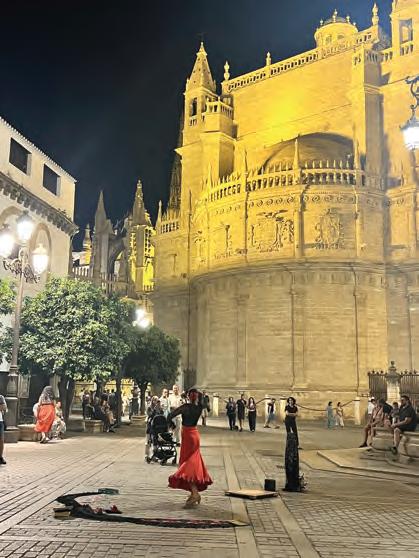
82 The Aleph
Flamenco Dancer near the Cathedral, Seville, Spain [Isabella Renzi]

I have you to thank for so many unforgettable experiences. Under the shade of your orange trees, I met people I’m sure I’ll be friends with far into the future. With the towering Giralda watching, I laughed so hard I had tears coming out of my eyes. In the vibrant green Parque de María Luisa, I became comfortable being by myself in a completely new environment. On your posh Calle Asunción, I became close with my host mom and her strange dog, and even was privy to her gossip sessions and allowed to give head scratches by the end of the semester (our dog usually hated to be pet). I took classes in your oldest university and walked through three different sunlit atriums on my way to class every day. And, on my way home, I gazed out over the Guadalquivir River while crossing San Telmo bridge. You taught me the sevillano attitude: trabajar para vivir (work to live), not vivir para trabajar (live to work). Trabajar para vivir - it’s important to work, but never forget to stop and enjoy your life.
Though leaving is hard, I know it won’t be permanent. Estoy tan agradecida de haberte conocido. Te amo, Sevilla.
Hasta pronto, Isabella Renzi
a journal of global perspectives 83
Guadalquivir River and the Torre de Oro, Seville, Spain [Isabella Renzi]
The Humboldt Forum
The Humboldt Forum is one of the most interesting museum complexes here in Berlin. Housed within the reconstructed Stadtschloss (located on the southern side of the Lustgarten on Museumsinsel, or “Museum Island”), the Forum consists of multiple museums and individual exhibitions - some permanent and some temporary - as well as spaces designed for public speaking and forums.
What I found most notable about the Humboldt Forum was the extreme care and importance the institution places on the provenance of their artifacts, and how it seeks to generate discussion surrounding the colonial past. This attitude is most evident in the Ethnographic Collections, which are the permanent installation on the third floor. Many (or really most) sections of the Ethnographic Museum are dedicated not to the artifacts housed within, but to the provenance of the objects. Often, the rooms in the museum have tables, comfortable chairs, and prompts for discussions about the artifacts surrounding them. There are also exhibits dedicated to amplifying the voices of the “originating groups” of the objects, discussing their significance and how they arrived in Germany.
Despite the attitude that the institution takes when it comes to the colonial history of their collection, there are still some potentially problematic elements. Primarily, despite claims to the contrary, how “decolonial” can an institution be while retaining artifacts obtained under dubious pretenses and existing in a reconstruction of a Hohenzollern palace? While the efforts of the museum are commendable, and the discussions it’s generating are important, should most of the objects not simply be returned? Like other major museums, the Humboldt Forum is often slow when it comes to the actual repatriation of artifacts, often due to the difficulty of tracing provenance and documenting ac-
84 The Aleph
Reflections II
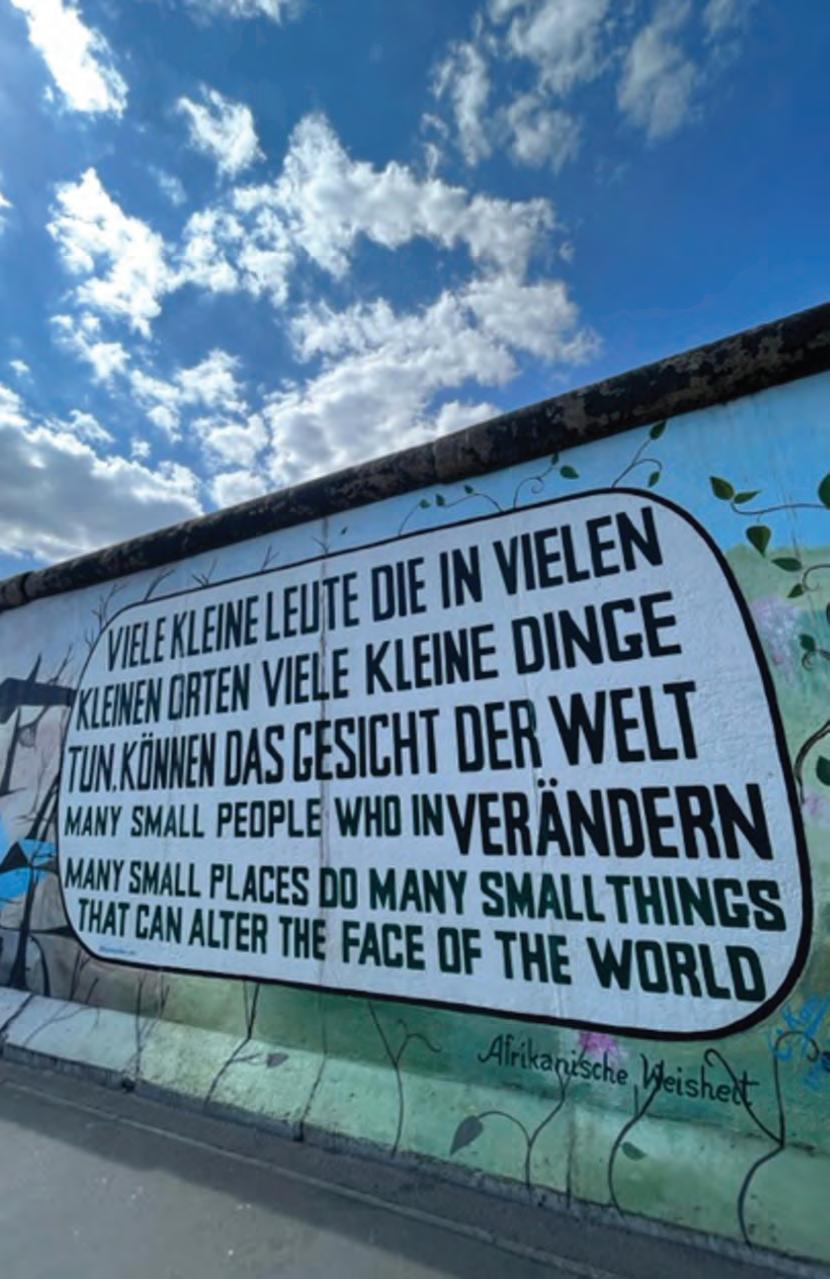
East Side Gallery, Berlin, Germany [Anjalee Wanduragala]
quisition when the objects in question are hundreds (or thousands) of years old, among other reasons.
Despite the problematic histories and current issues facing museums, I still cannot help but get excited about seeing certain artifacts. And so, I would like to take some time to gush about the parts of the Humboldt Forum that I found the most interesting during my three trips these past two weeks. The boats from Pacific Island cultures cut a striking and memorable image. No matter how cool the boats may look, I’m glad that I don’t have to navigate through ocean waters in one. These ships are easy to enjoy from the meta museum-analysis angle as well, since the government of the Solomon Islands doesn’t want the boats back and has actually explicitly stated that the boats should remain at the Forum so that a wider public can see and learn about them.

86
The Aleph
A View of St. Stephens Basilica, Budapest, Hungary [Lucas Gillespie]
I also found the Schlosskeller, located in the basement of Humboldt Forum, to be fascinating. As previously mentioned, the Forum is located in a reconstruction of the 1443 palace that once housed the royal Hohenzollern family. After the palace was left in ruins during the Second World War, the remaining portions were demolished. From 19501971, the lot was home to Marx-Engels Platz. The Palast der Republik was built in 1976 to house the Volkskammer, the East German parliament. In 2008, however, the Palast was torn down after a long closure due to high asbestos levels. Finally, in 2013, the decision was made to rebuild the palace. The only constant in all that history has been the ground itself. In the Schlosskeller, one can see the history of the site laid out, each above-ground variation of the space leaving evidence underground. I had an absolute blast wandering through the old brick walls, imagining people in the past going about their daily lives in the basement and above. It reminded me a lot of the remnants of Santa Reparata in Florence, which sit beneath Santa Maria del Fiore, and prompted me to think about the age of the space I was in. I could practically feel the weight of time in the walls, something I rarely get to experience in the US.
I cannot think of any American museum that takes an approach to their collections similar to that of the Forum. We have no constructed space with as long of a history as the original Stadtschloss, and have no museum as dedicated to fostering dialogue about the past. While the historical significance of a building cannot be replicated, I think it could be really interesting to see if a similar space could exist in the US, perhaps incorporated into the Smithsonian Institute. Without the specific history that led to the creation of the Humboldt Forum, it’s difficult to imagine a comparable environment appearing anywhere. It really is a unique and undervalued portion of Museumsinsel.
- Ian Moon
a journal of global perspectives 87
To Be the Lucky One
As the first person in my family to travel abroad for a semester, I’ve had a great deal of pressure put on my shoulders to succeed in my classes, to have fun, to call every day, to visit every country, and I’ve found myself looking to balance those expectations with my own search for self-identity. To be frank, I’ve accomplished one of those tasks - the rest have been rather insurmountable. How could I be expected to call every day when I can’t even remember the name of the street I live on in Triana? How can I go visit other countries without having explored the Iberian Peninsula, and simultaneously succeed in classes? Who am I kidding? That was never going to happen. I mean all of that as a joke, but it sheds light on my situation. I was trying to experience as much as I could while not even taking in all of the sights around me.
With the burden of my family’s expectations, I knew I had to try to enjoy every last bit of Seville; I would wander, searching for something with no clear goal in mind, and would gloss over the small yet intricate beauty of my surroundings. So, I slowed down. I started taking photos and capturing all that was around me, trying to keep memories of this new place so many miles away from home. While I didn’t call home, I got closer to my new friends; we became a tight-knit group, wandering the warm and bright Seville nights together, forming a bond abroad. My parents would call and I’d answer, but each call made me miss home, so I found comfort instead in interacting with those around me.
In a country with a prominent bar culture, the easiest way to meet and learn about new people is over tapas, a small snack or meal of varying types. In these interactions, I’d find myself speaking French and Italian along with Spanish to learn more about people and where they came from.
88 The Aleph
Reflections III
From Brussels to Morocco, from Seville to Venice, I’d find myself speaking to people from all walks of life and forgetting that I was away from home. But, inadvertently, I had made myself a new home, built through the shared experiences and stories of people just like me, trying to find their way through life. So, would I return to Seville? Truthfully, this city has become like my home in Newark, NJ, like Geneva, NY, because it has formed a new part of me, and I’m thrilled that I had the chance and the privilege to have called this city my home.
- Abel Guzman
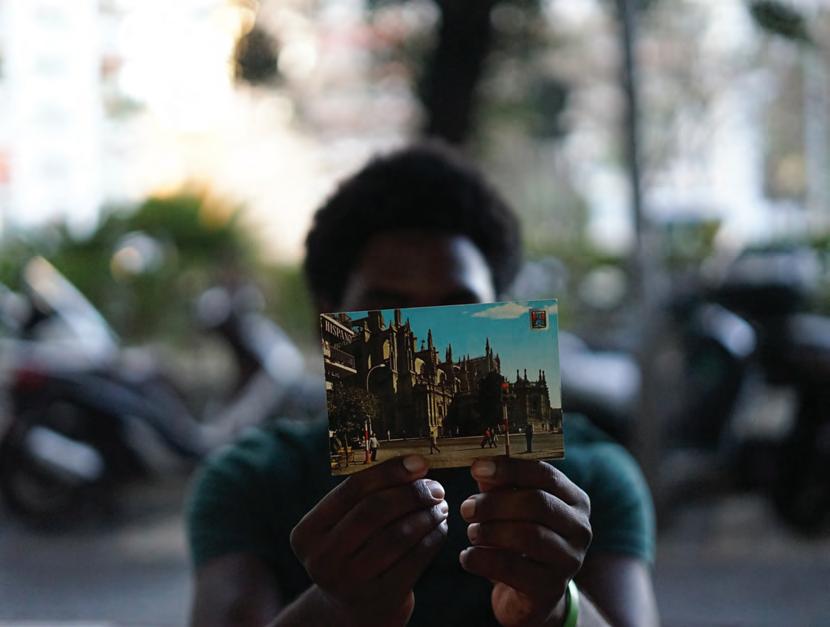
a journal of global perspectives 89
Holding a Postcard of the Cathedral, Plaza de Cuba, Seville, Spain [Abel Guzman]
 Joy, Rome, Italy [Alex Barnosky]
Joy, Rome, Italy [Alex Barnosky]
Goodbye Berlin
After spending four months studying in Berlin, I have been lucky enough to learn about the ways Germans entertain themselves. From soccer games to late-night clubbing, there is something for everyone. Upon my arrival in February, I felt excited to explore a new city but scared to experience the unknown. Luckily, I had a fantastic group of friends who were just as eager as I was to do everything we could in the time we were there.
After seeing Berlin change from winter to spring and then to the early bits of summer, it was cool to see the way it sprouted and opened into a flourishing and bustling city. The view I had from my room looking out to the trains running in and out of Jannowitzbruke Station all day and night reminded me of how alive the city was. People were going everywhere at all times of the day because anything is possible in a city like Berlin. It is a place with a vibrant entertainment culture where nightlife, sports, festivals, museums, and celebrations of all kinds thrive. I quickly came to realize that seemingly everyone indulged in some type of entertainment daily. Whether it was heading to the park after work or to the sports bar to watch soccer, I felt that there was community everywhere. People always came together to enjoy entertainment and I really valued that.
In each place that I went for entertainment, there was a collective agreement to live in the now and to embrace the people around you. The nightlife was the most prominent example of this because people came dressed in unique outfits and there was an openness to be yourself. There was no judgment and everyone was there to have fun and enjoy the music. The parks were also a place where you could go to enjoy yourself while in the company of strangers. My favorite experience was a Sunday in early May when the weather was warmer so a lot of people were out. There
a journal of global perspectives 91
Reflections IV
were kids playing on the playground and people sitting by the pond, eating, drinking, running, walking dogs, playing basketball, skating, and more. Everyone was enjoying and entertaining themselves differently but in the same place, and it really showed me that there was a strong sense of community in the city.
Berlin is also exciting because it offers an extremely rich history. It is a classroom and I was lucky enough to learn in it. Almost every place you go you are reminded of what happened there and how it fits into our world history. I went on many excursions with my program to learn about the history of the city, whether to the Altes Museum, Be-
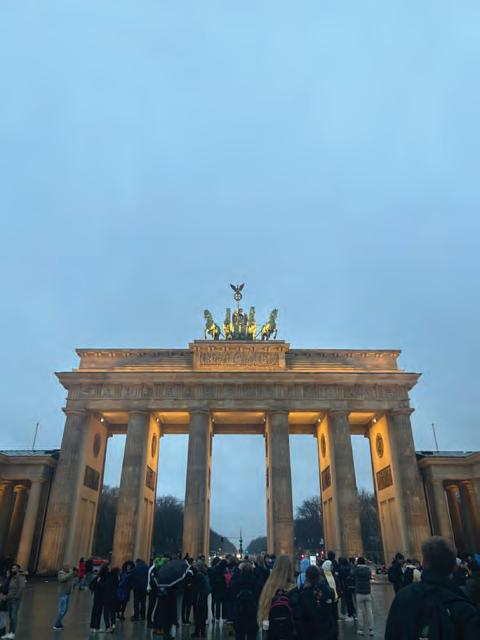
92
The Aleph
The Beauty of Brandenburg Gate, Berlin, Germany [Emma Kirts]
belplatz, or a street that was once home to victims of the Holocaust. Every corner you turn, there is something to be learned.
Although large, Berlin gives one the opportunity to find different types of entertainment in a close vicinity. You can find yourself wandering Museum Island one second and then eating döner across the Spree in Monbijoupark with your friends the next. Don’t be surprised if you walk through a flea market or street performance on the way. Berlin also offers one of the best transportation systems in the world, so getting to Tiergarten or the Brandenburg Gate is a quick trip. I particularly enjoyed walking from my
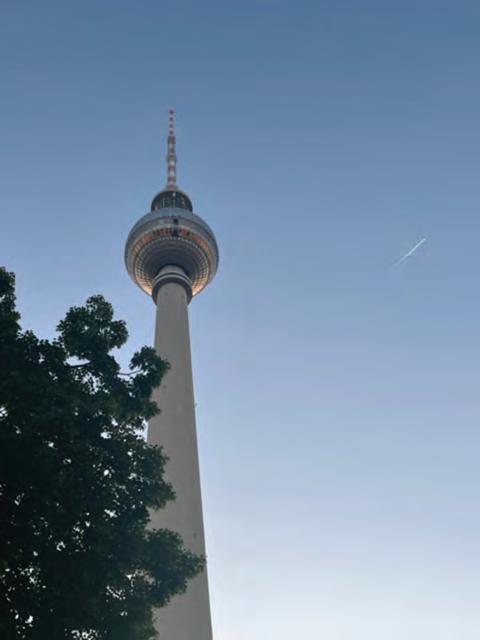
a journal of global perspectives 93
Berliner Fernsehturm, Berlin, Germany [Anjalee Wanduragala]
school building to the Hackescher Markt station because there was always something to see, hear, or smell. I also enjoyed going to the sports bar to watch Premier League games with my friends. The bar was consistently packed and it was really fun to be in a country where the most popular and loved sport was soccer. It was exciting to see and hear all the locals cheering for teams. Watching soccer was not the only way I got to enjoy the sport, though. By far my absolute favorite experience was joining a local football club called Berolina Mitte. I truly bonded with my teammates and all of the practices were in German; I became friends with them and learned more about the German lifestyle. My teammates differed a lot in age and showed me that everyone turned to soccer for fun, no matter what was going on in their outside life.
I am lucky that I got to experience all of this in Berlin. It is a city with a variety of opportunities for everyone and I cannot wait to go back to try more of what it has to offer. It is a place of never-ending entertainment of all types from movies to markets to museums and more. The city taught me about myself: I am smarter and braver than I thought, but I also am vulnerable and still learning about life. I am grateful for the experience and would do it again if I could. Four months is not nearly enough time to spend in this city, but it just means I have to go back soon!
- Emma Kirts
94 The Aleph
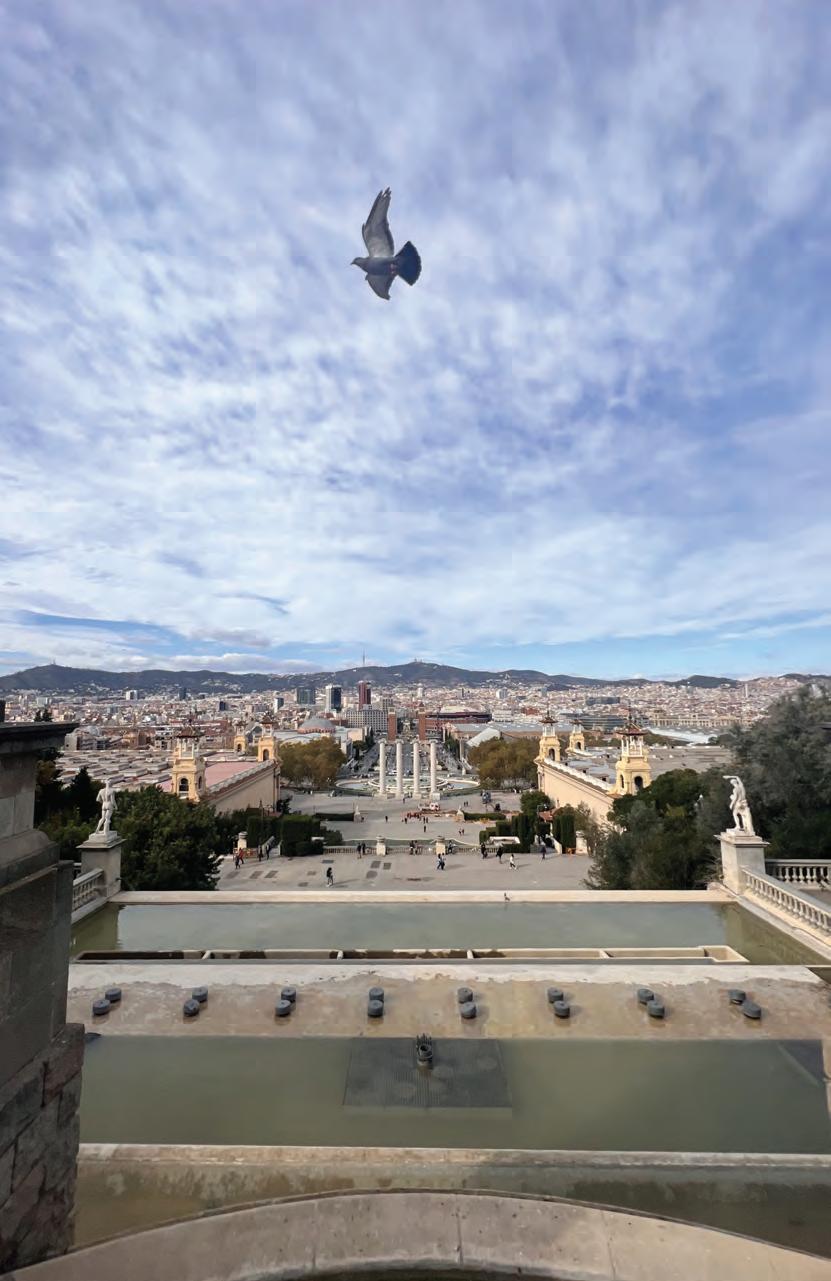 View from Above, Barcelona, Spain [Isabella Renzi]
View from Above, Barcelona, Spain [Isabella Renzi]

 Die S-Bahn, Leipzig, Germany [Will Russell] Roman Subway, Italy [Alex Barnosky]
Die S-Bahn, Leipzig, Germany [Will Russell] Roman Subway, Italy [Alex Barnosky]
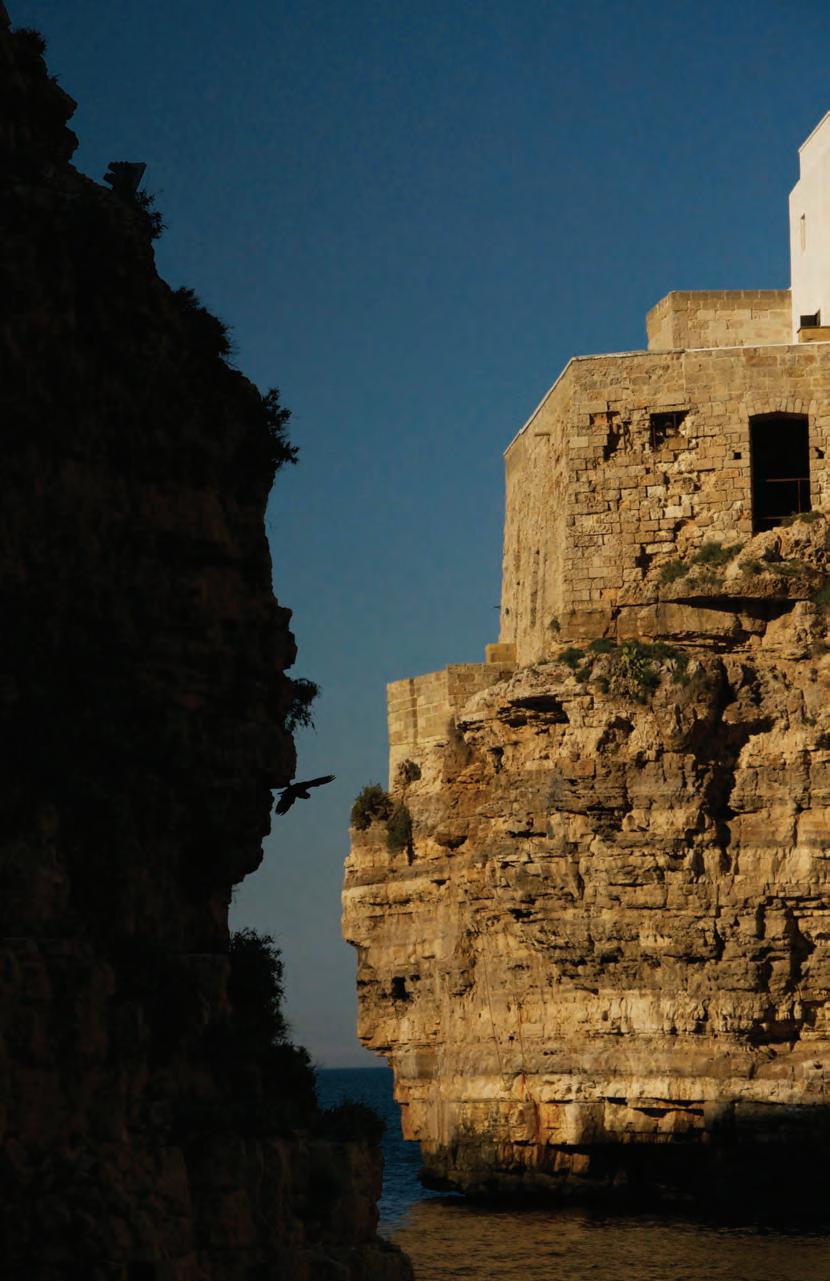 Cliffside Flight, Poliganano a Mare, Italy [Alberto García de la Puente Stanley]
Cliffside Flight, Poliganano a Mare, Italy [Alberto García de la Puente Stanley]
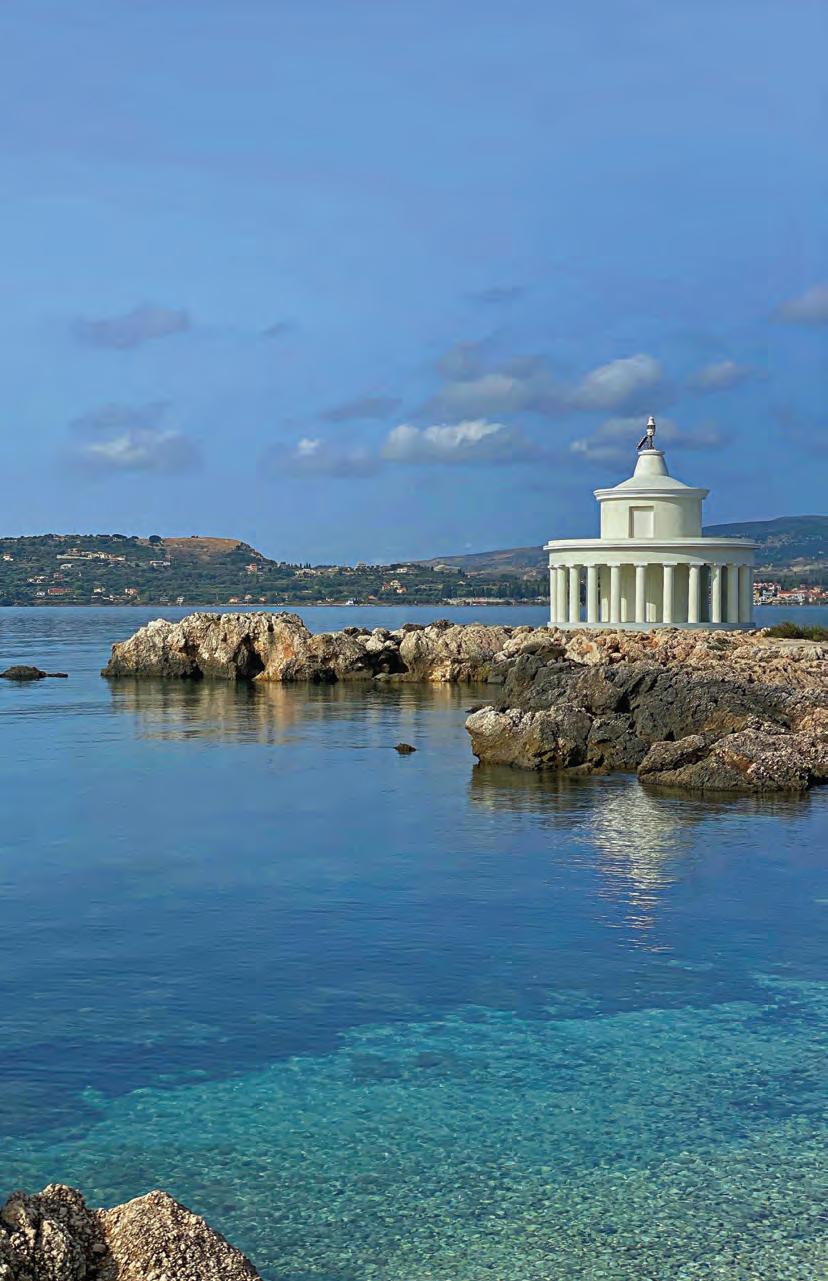 Lighthouse on the Island of Cephalonia, Greece [Eastwood Yeboah]
Lighthouse on the Island of Cephalonia, Greece [Eastwood Yeboah]

Sunset over the Atlantic, Signal Hill, Cape Town, South Africa [Ahmed Wise]
Floating in the Mediterranean, Les Calanques Cassis, France [Mia Tetrault]
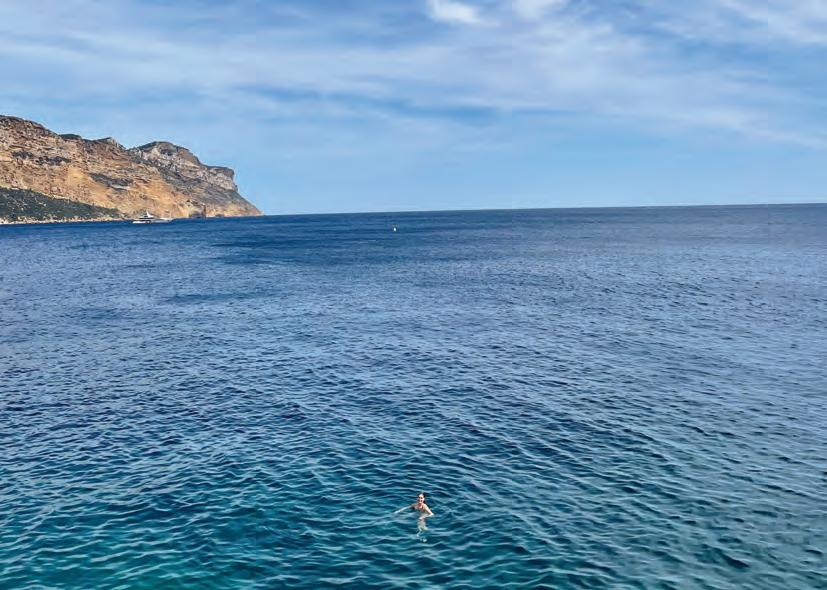
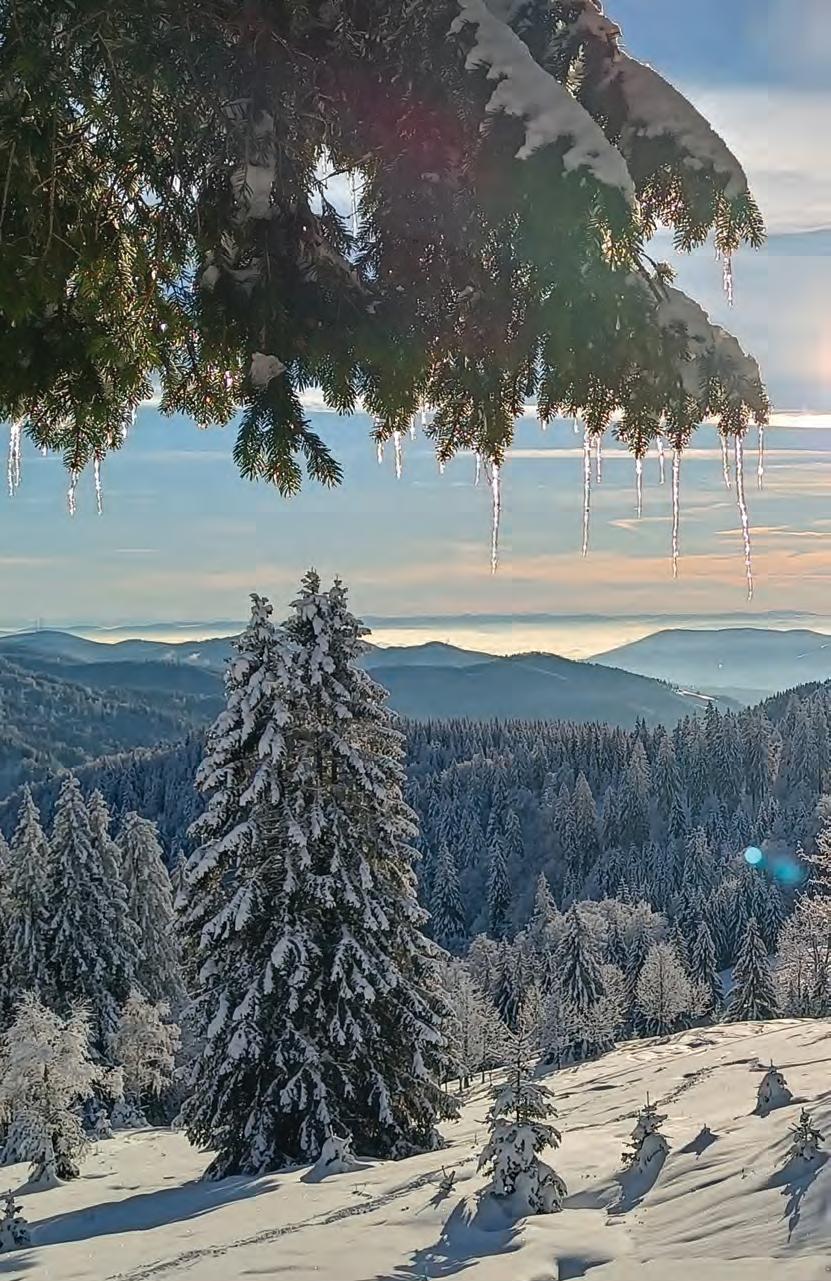

Sledding in the Black Forest, Feldberg, Germany [Tarang Malhotra]
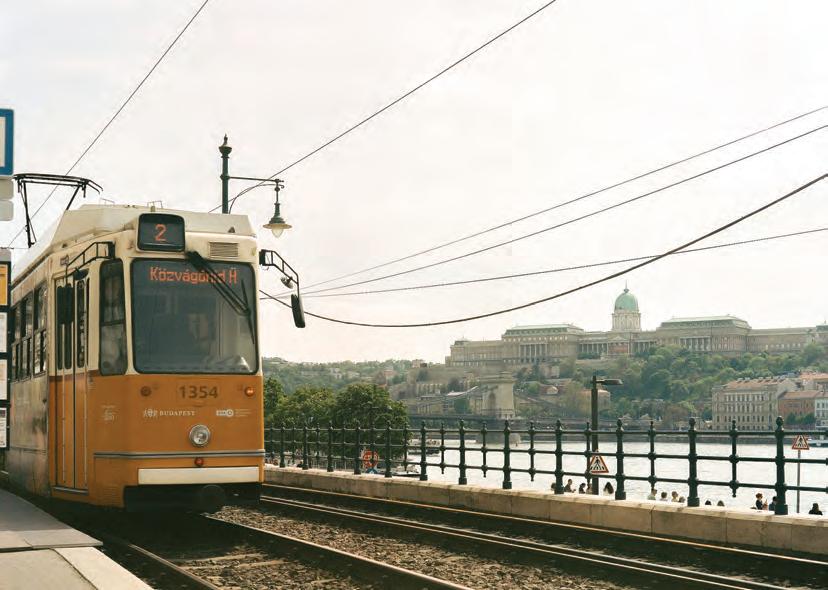
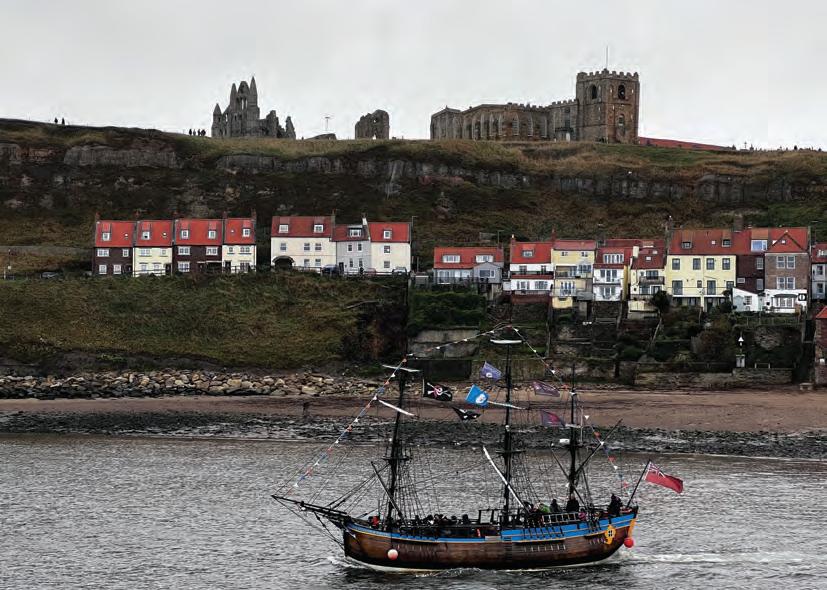 Tram Line 2 at Vigadó tér, Budapest, Hungary [Lucas Gillespie]
Boat Passing Under the Whitby Abby, Whitby, England [Jacob Newman]
Tram Line 2 at Vigadó tér, Budapest, Hungary [Lucas Gillespie]
Boat Passing Under the Whitby Abby, Whitby, England [Jacob Newman]
 Castel Sant’Angelo, Rome, Italy [Alex Barosky]
Castel Sant’Angelo, Rome, Italy [Alex Barosky]
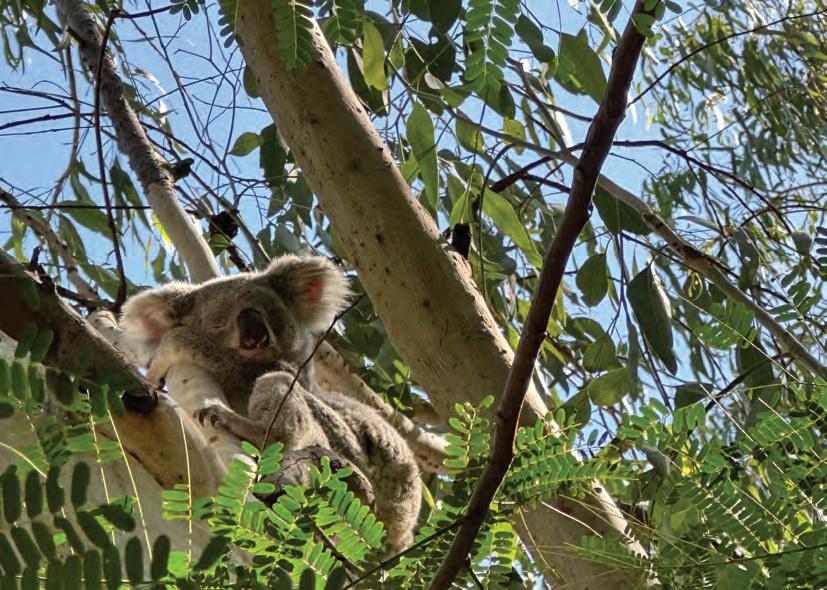
 Sleepy Koala on Magnetic Island, Queensland, Australia [Cayden Smith]
Baby Monkey, Ben Smim Forest, Morocco [Isabella Renzi]
Sleepy Koala on Magnetic Island, Queensland, Australia [Cayden Smith]
Baby Monkey, Ben Smim Forest, Morocco [Isabella Renzi]
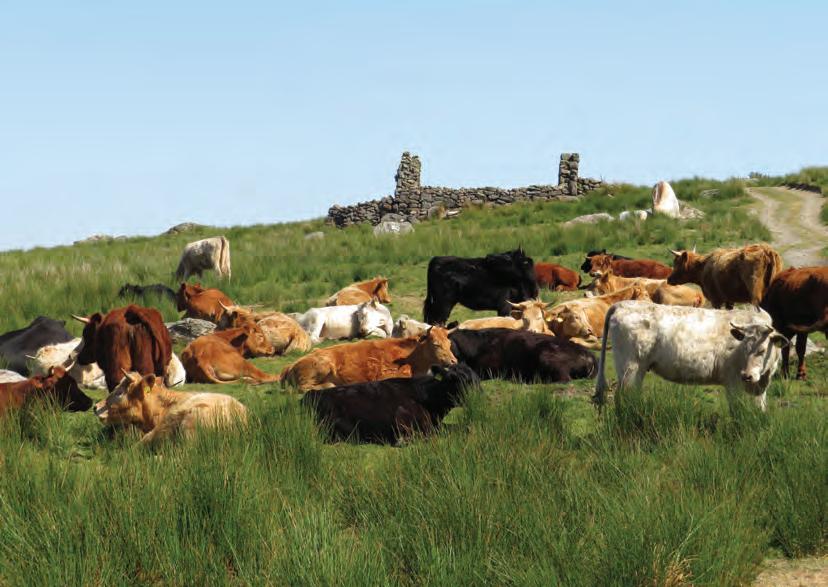
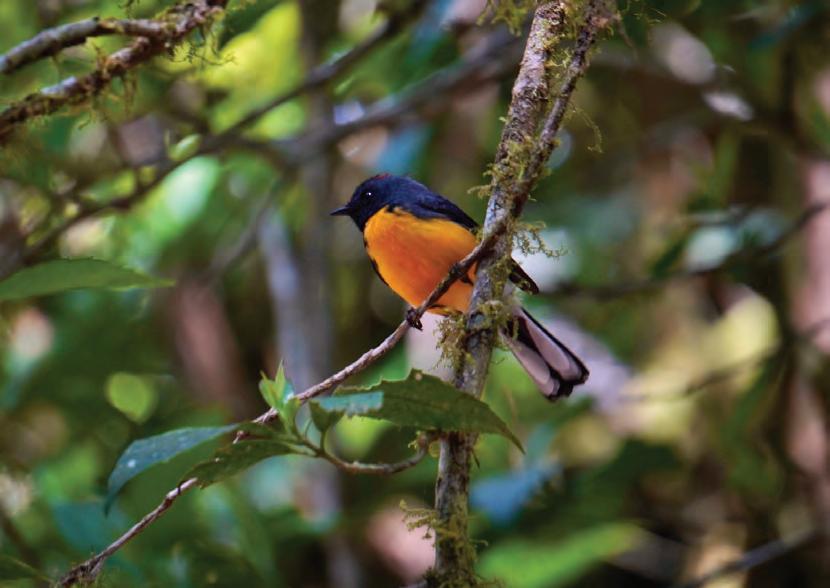 Cows in Llanberis, Wales [Jordan Britton]
Small Bird in Monteverde Cloud Forest, Costa Rica [Karina Connolly]
Cows in Llanberis, Wales [Jordan Britton]
Small Bird in Monteverde Cloud Forest, Costa Rica [Karina Connolly]
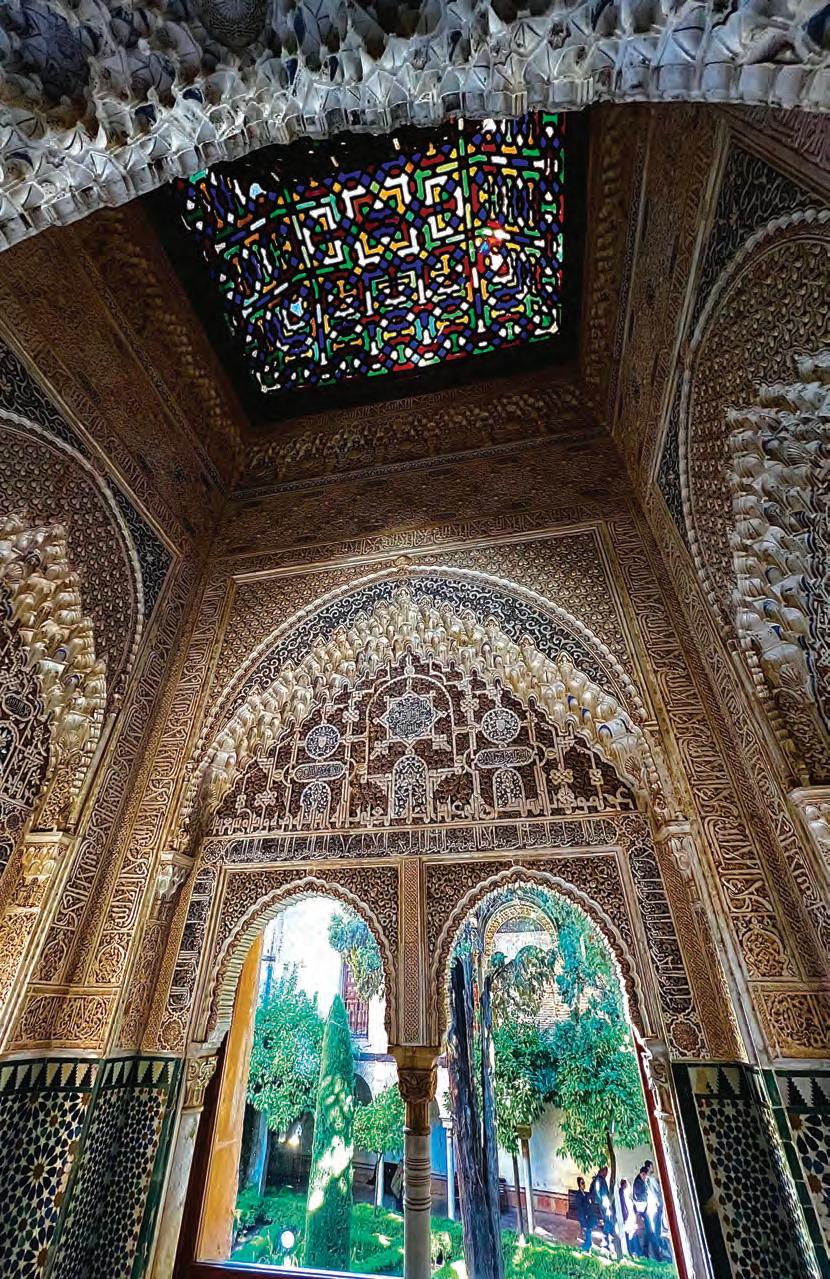 Intricate Plaster Work in the Alhambra, Granada, Spain [Paulina Tejada]
Intricate Plaster Work in the Alhambra, Granada, Spain [Paulina Tejada]

Sunrise over Lake Pukaki, New Zealand [Maddi Meyer]
La beauté de la neige dans la forêt, Grenoble, France [Djeneba Diop]
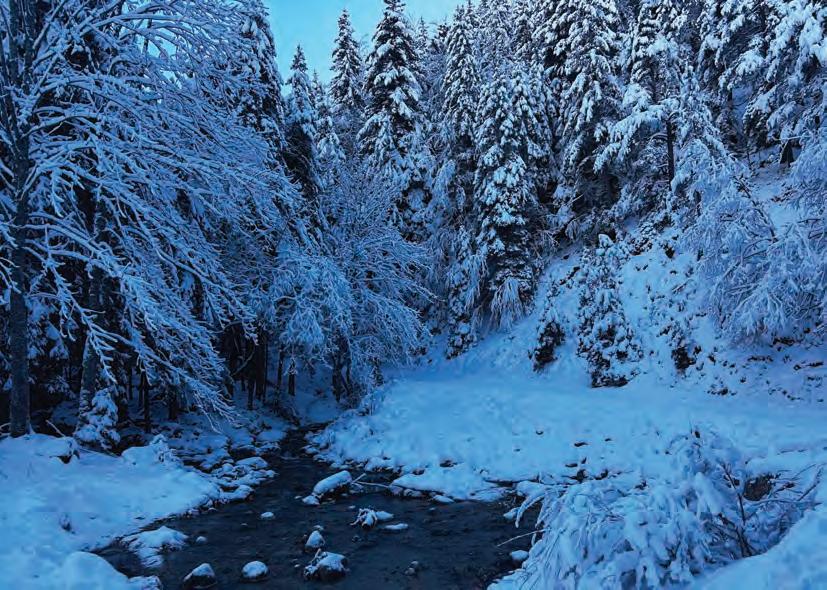

VERSE & VISION

in the
[Isabella
Nomadic Village
Sahara Desert, Morocco
Renzi]
VERSE & VISION I
La Giralda
Your eyes hold a story I long to know
One covered in years of rains
The vibrant sea holds no candle
To the beauty of your rivers
Your eyes glisten from the sun’s beaming rays
In the bright clear sky
Your bells chiming gently calming me
Patinated hands stretching a branch toward me
My eyes searching for you
Scanning the moonlit skies for you
And in a stupor who knows what may happen without you
But I know the next day you will be there again
Your familiar figure standing over us all.
- Abel Guzman
110 The Aleph
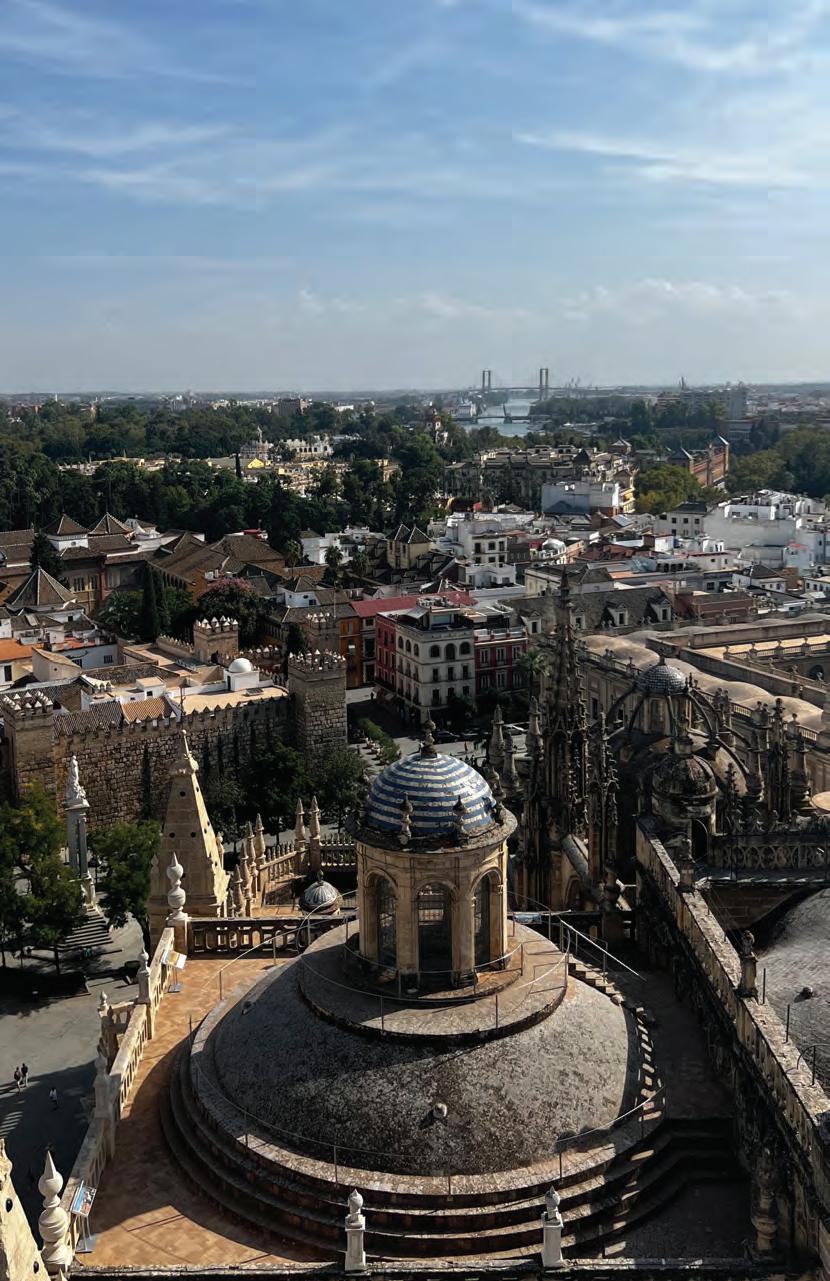 View from the Top of the Giralda, Seville, Spain [Paulina Tejada]
View from the Top of the Giralda, Seville, Spain [Paulina Tejada]
Our Method of Deliverance
Last night, I got teary-eyed on my bike ride home.
The stars are clearer in Maastricht.
I would not be surprised if there is less light pollution here.
There is less pollution in general.
On clear nights, I pull into the path of the bike shed.
I get a good look at it. The Big Dipper, I mean.
Last night, I biked home at 3am.
Maastricht was covered in a fog of hazy amber.
Our cobbled paths illuminated by sparse streetlights.
The Big Dipper hangs in its balance over Volksplein.
I got teary-eyed on my bike ride home.
It is singing so I know. We see the same sky after all.
I chose a window seat on my flight.
I was up while my neighbors slept.
Window seat’s stars linger outside plane windows.
The Big Dipper forms as time and space fly by.
Mom and Dad watch my plane take off from the airfield by our house.
They watch me through security, in sight as long as possible.
I cry when I say goodbye to Evan.
112 The Aleph Verse & Vision II
I have a sneaky feeling there is less light pollution here.
The stars are clearer in Maastricht.
I walk my bike down the sloping path.
I perform a logical proof.
The Big Dipper hangs in its balance.
She rocks me to sleep. She is singing, so I know.
I get teary-eyed when I bike home.
- Katelyn Weeks
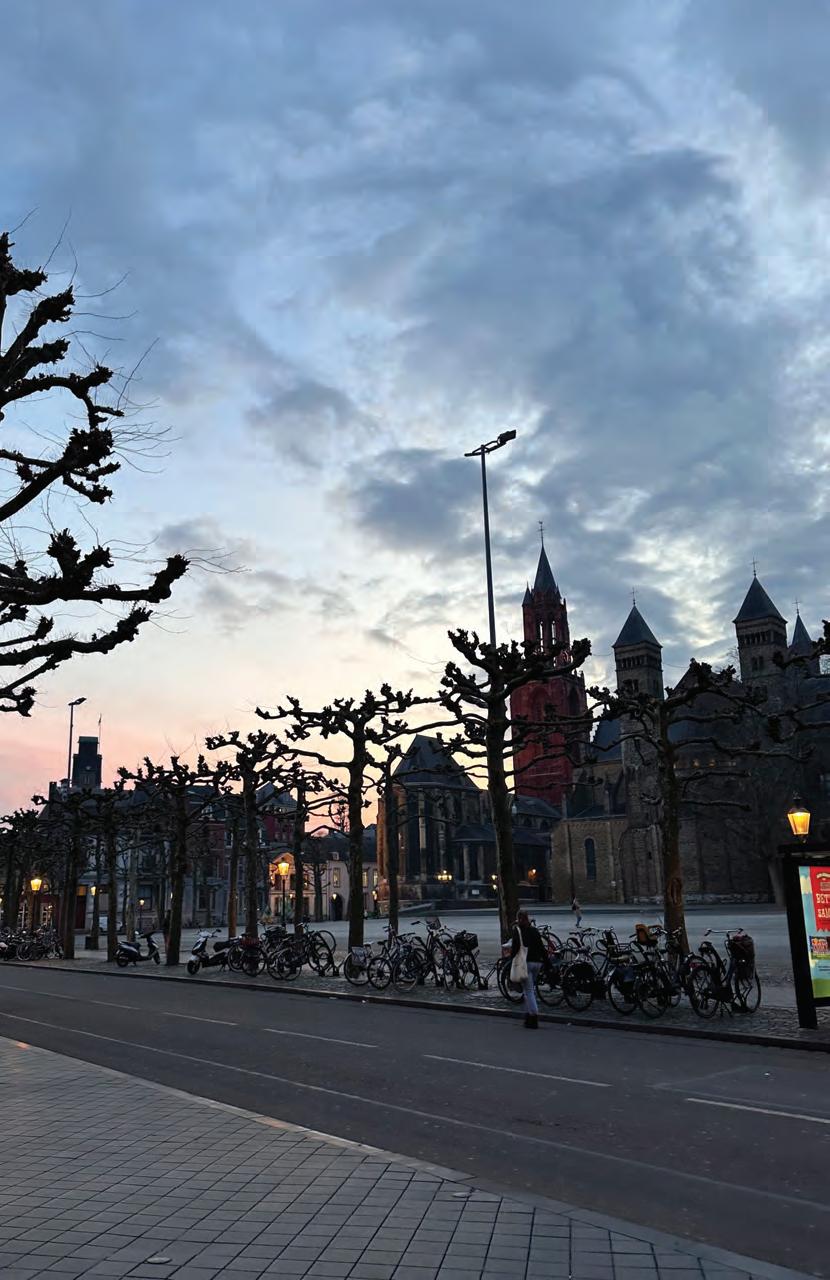
Maastricht in February, Netherlands [Katelyn Weeks]
Chamber of Darkness
In the realm of shadows, I enter, Breathe the essence of aged timber and earth.
Through the veiled chamber of darkness, I walk, Witness to silent echoes of spirits yearning for solace.
Deeper I journey into the chamber of darkness, Fingers tracing the icy veins of cobblestone; A distant flicker of light beckons, Yet, within the shadows, Lies the profound cost paid in the chamber of darkness.
Within the chamber’s lamenting embrace, I tread the path of history’s haunting refrain, Where souls, like ethereal whispers, plead for warmth, Their stories etched in the marrow of cold stones.
In this sepulcher of despair, The glow of distant hope is but a feeble ember, For what countless hearts lost, In the unrelenting grip of the chamber of darkness.
Note From the Author: Participants in The March: Bearing Witness to Hope are exposed to an overwhelming amount of information. We will all remember, however, what we
114 The Aleph
Verse & Vision III
smelled, saw, heard, and felt. This poem tries to emulate these senses, while evoking the power of repetition.
Written at Auschwitz KL in Poland on 06/06/2023
- Cameron Guan
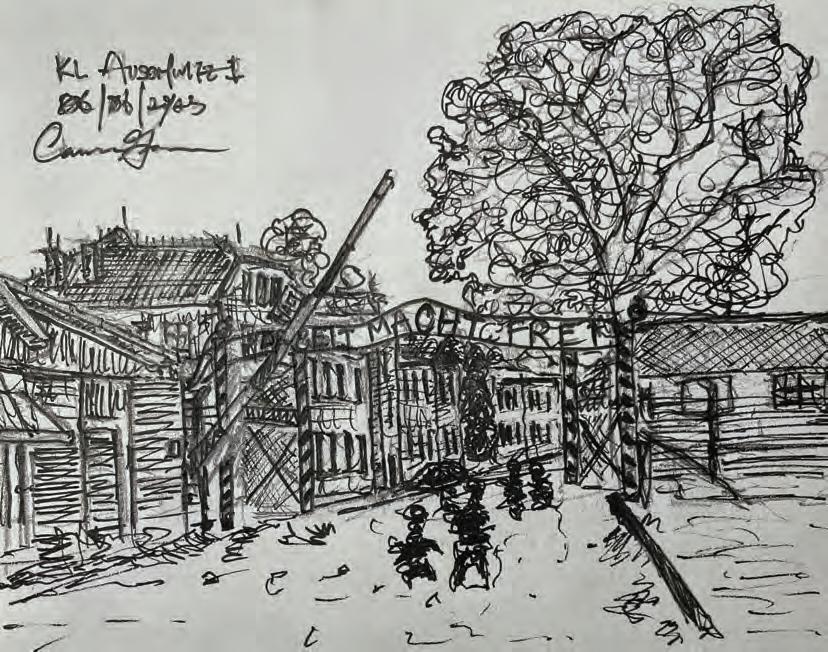
a journal of global perspectives 115
Arbeit macht frei Gate, Auschwitz I, Oświęcim, Poland [Cameron Guan]
My Experience in the Netherlands
A mixed woman in a Dutch city is a confusing thing. Is she part tiger, Apennine, lesser kiskadee when she’s really there in the country of leeuw as a bald eagle? Where does she fit in?
Sent from the west, she moved east and found a temporary home in the lower Netherlands. Surrounded by fermented drinks and cobblestone works she learned the beauty of a country connected to her ancestors by tumultuous ties.
For her people and moeder, life was altered by the leeuw’s patronage of lesser kiskadees. The tigress moved from place to place and found purchase in the Amazon, home to the lesser kiskadee. Conspicuous around the lesser kiskadee, the tigeress was home and spoke in their tongue.
Fleeing her home years later she settled and birthed a multicultural bird, who would eventually make its way to the lower Netherlands. In this story our bird is perceived as a tiger and bald eagle and treated as such by the less-than-welcoming xenophobic individuals in her travels.
In a time where culture is mixed and free-flowing like beer, she was startled and confused by this welcome but nonetheless persisted and by the time of her departure found beauty in the country.
She hopes to one day fly there again and roam among the leeuwen once more. - 王美如
Velocity Lopolito
116 The Aleph Verse & Vision IV

Waterfall
in Milford Sound, New Zealand [Jack Daley]
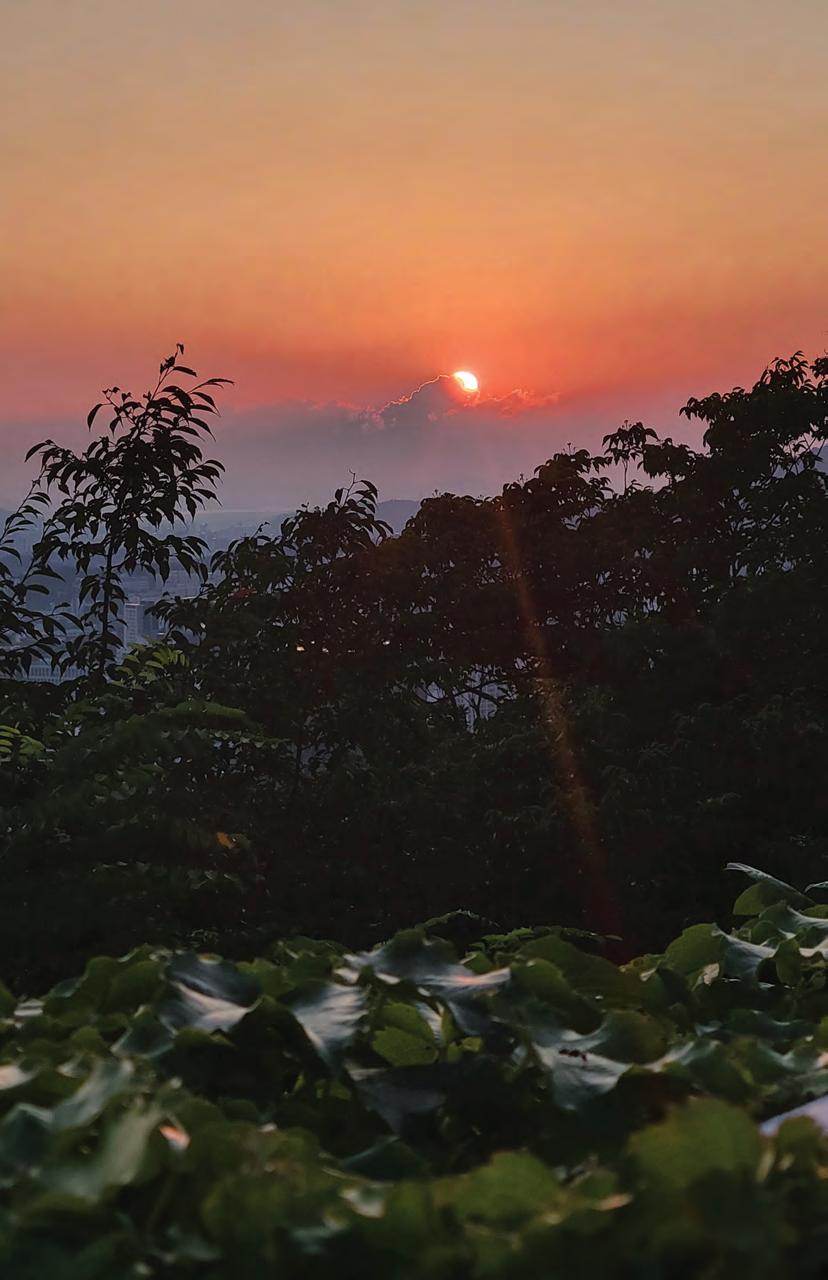 Sunset in Namsan, South Korea [Lexi Hansen]
Sunset in Namsan, South Korea [Lexi Hansen]
El Americano
I wander through the fading light of the sun
Carrying the weight of two worlds
The American seeking new experiences
And the wanderer searching for himself
I’ve been lost for a while
Je ne sais pas la raison
Y no sé cómo mejorarme
I rely on the Spanish I learned from my mother
And the French I retained over seven years
To look for other stories
I search for myself within their words
As I walk the dark streets for hours
Y sentado mirando la luna desde el puente de Triana
Seul sur ce pont je reste avec les étoiles et je sais que tout ira bien.
- Abel Guzman
a journal of global perspectives 119
Verse & Vision V
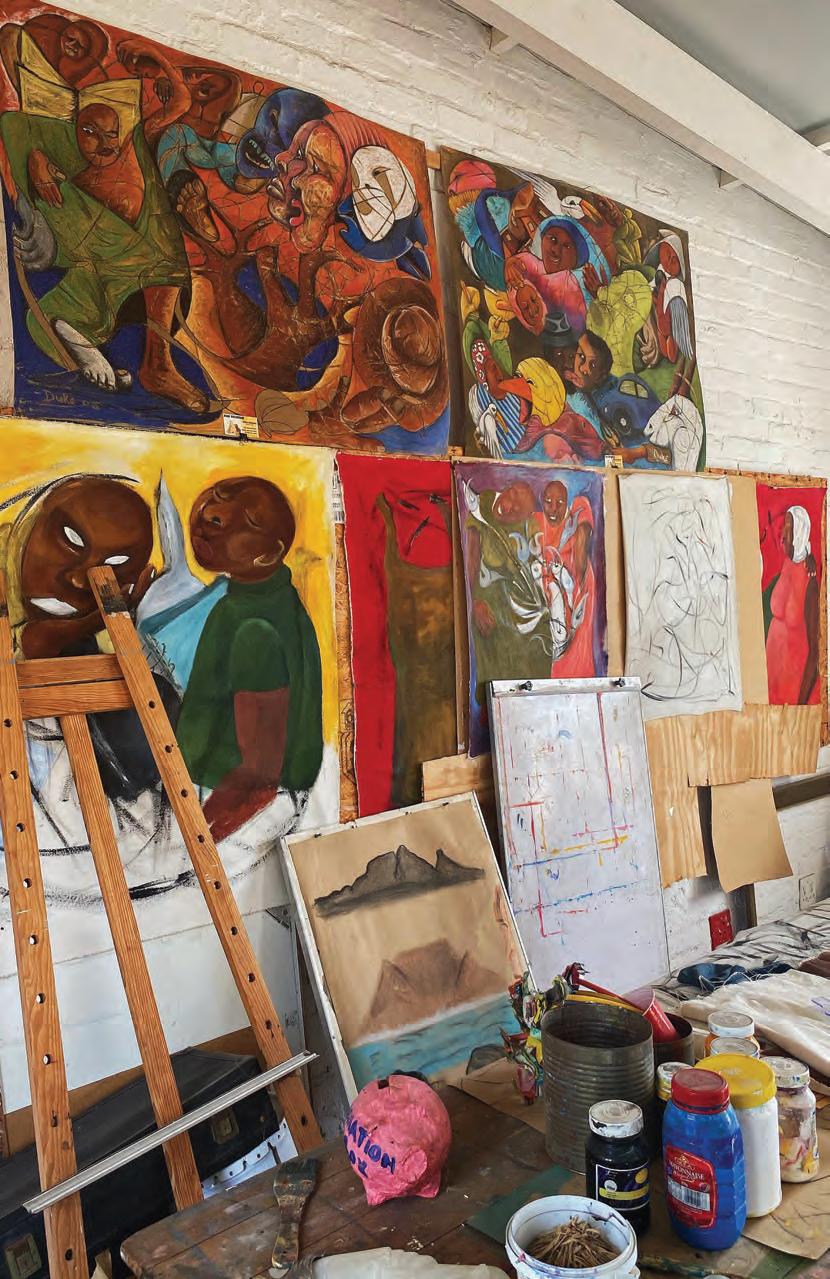 Commissioned Artwork at the Community Recreational Center, Cape Town, South Africa [Eastwood Yeboah]
Commissioned Artwork at the Community Recreational Center, Cape Town, South Africa [Eastwood Yeboah]
This series is an attempt to characterize the most significant places I went while studying abroad in Berlin through trees and architecture. The first is of the Berlin TV tower (the Berliner Fernsehturm), a staple of Berlin’s communist architecture. The second is of my old home in Amsterdam, where I was born and lived until age three. The tree was in a park behind our house that grew diagonally, protruding from the ground; my family would picnic under it and always told me about it when I was older. The third is the Berliner Philharmonie, the concert hall of the Berlin Philharmonic, designed by Hans Scharoun. My semester studio project was to design a concert hall for its parking lot, and I spent a lot of time there. The fourth is Villa Balbiano on Lake Como, where I visited for spring break. I had been there once before and was struck by the amazing trees and scenic structures. The last is of the Louvre, which I visited as part of a program excursion in Paris.
- Cooper Robards
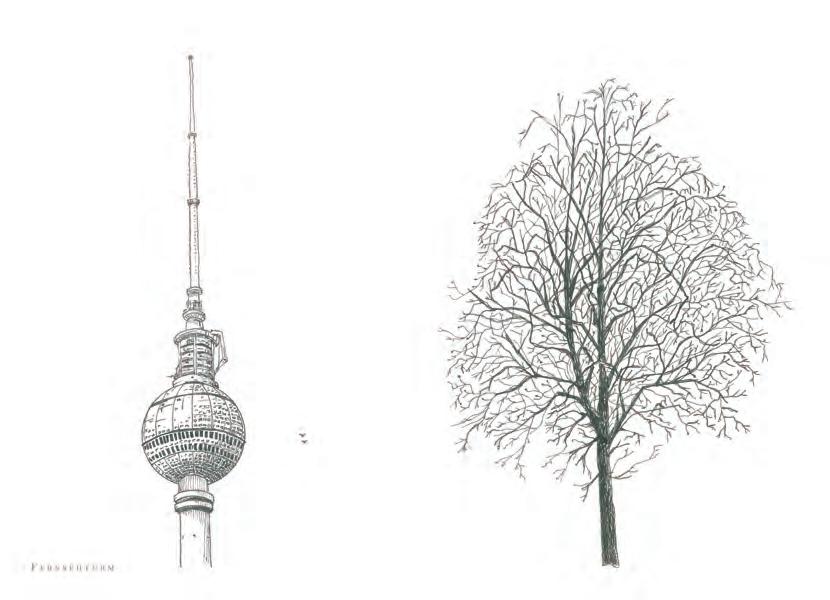 Berliner Fernsehturm, Germany
Berliner Fernsehturm, Germany
Sketchbook II
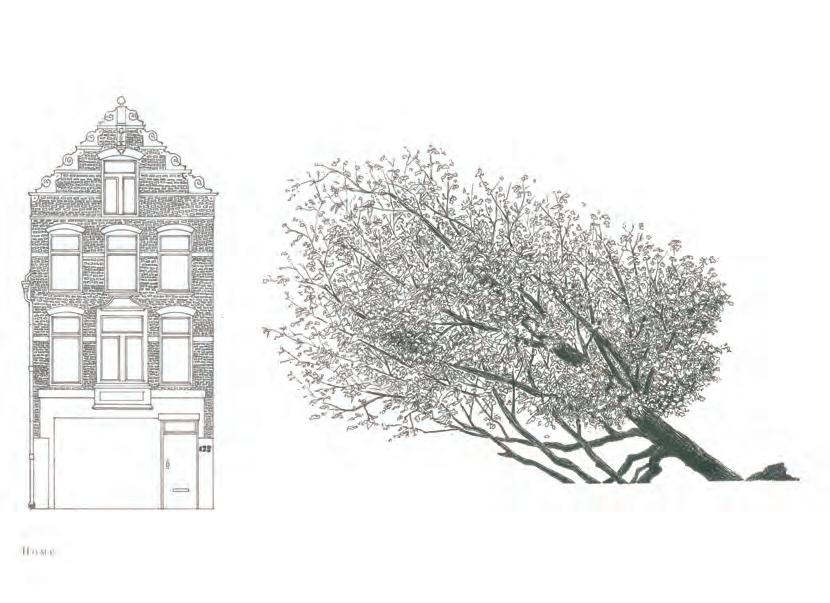
My Old Home in Amsterdam, Netherlands
Berliner Philharmonie, Germany
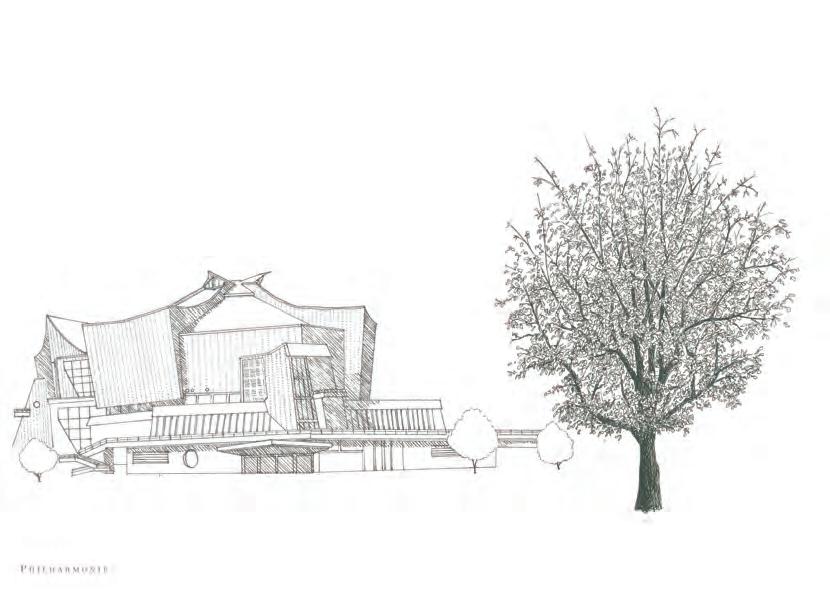
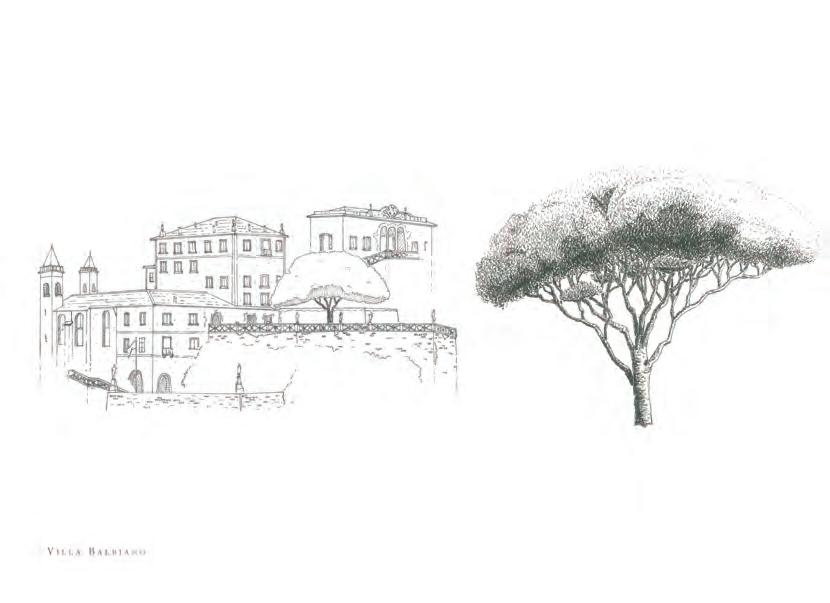
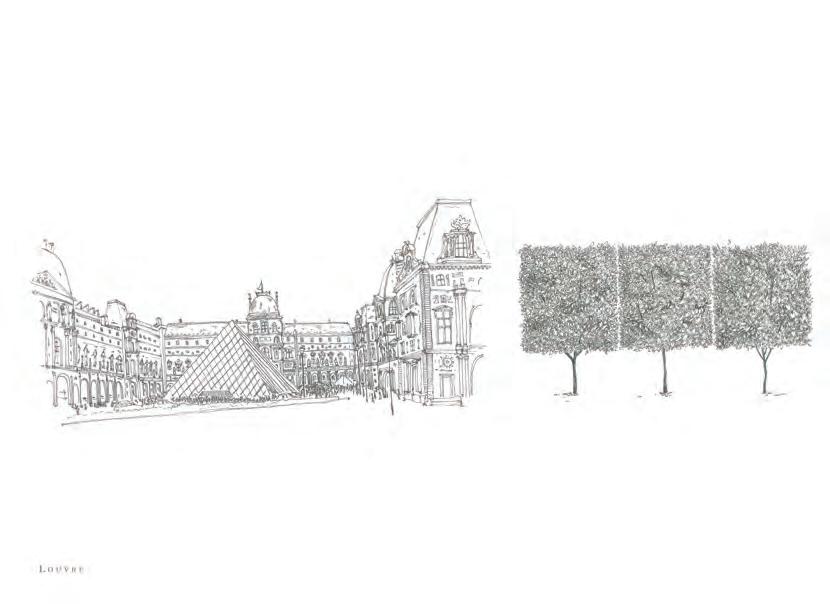 Villa Balbiano, Lake Como, Italy
The Louvre, Paris, France
Villa Balbiano, Lake Como, Italy
The Louvre, Paris, France
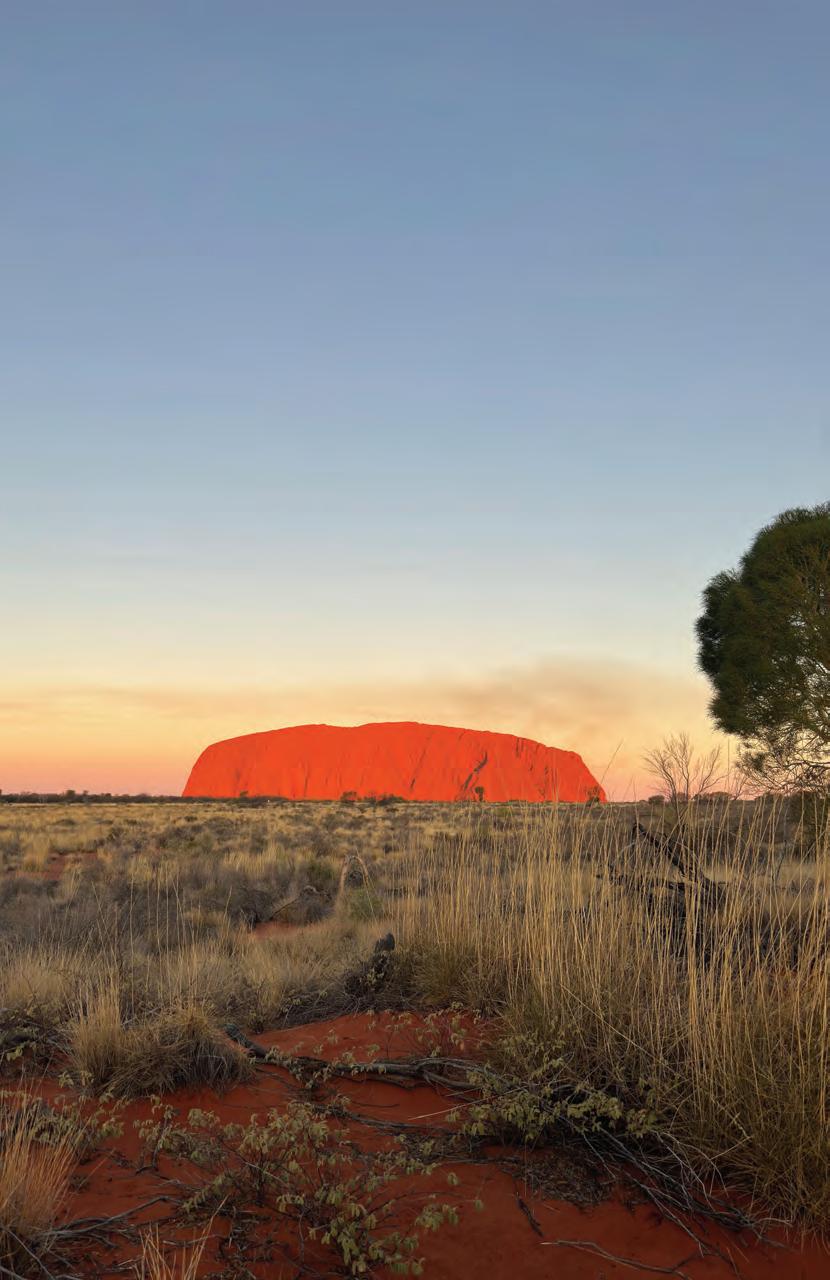
MOMENTS
n. 1. a very brief period or exact point in time
2. a particular stage in something’s development or in a course of events Sunset
on
Uluru, Mutitjulu, Northern Territory, Australia [Cayden Smith]
MOMENTS I
The Way of Thinking in Galway
Looking at pictures of summers past on my mom’s overindulgent Facebook page has made me realize how far I am from the place where I grew up. It’s comforting to know that we lie under the same stars each night, though it’s daunting to know she sees a completely different view than I do. Sending me pictures of the snow that prevents her from leaving our remote home makes me more aware of the rain that hits my window, as if it is angry at me for staying in bed all day. I decided it was time for me to get groceries; even just the short walk to Dunnes to imitate productivity. All I had in our miniature fridge, shared between three people, was a salad that had gone bad and pasta sauce. Neither were appetizing. Or edible.
I suited up in the raincoat I bought because of the reputation of rainy Ireland and my matching rain boots. Little things that make me feel as if I belong. I braced myself for the last moment I would be dry but convinced myself it was worth it in exchange for a warm meal. The walk always goes by faster than anticipated. I wove across the road, planning out how to make it across the highway as quickly as possible without being “that” American that risks her life for a small pesto pasta salad. I walked through each aisle shopping for what could possibly satisfy my cravings in the coming weeks, checking items off on my shopping list. I’ve always been a list maker - bagels, eggs, coffee, bowtie pasta, spinach, toast, butter, wine, some fruit for balance.
a journal of global perspectives 125
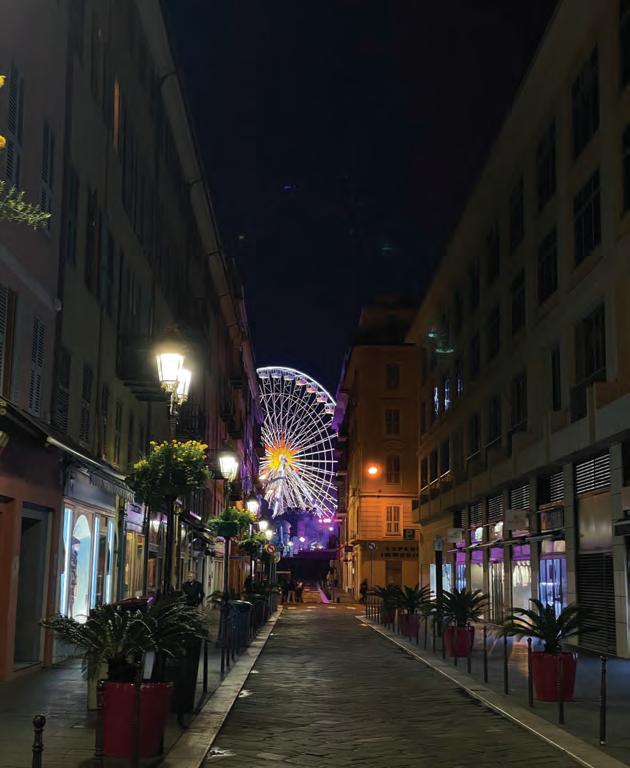
The walk back always feels longer than the way there. I carried what felt like a bag of bricks in a new, reusable Dunnes bag because I always forget to grab one from the collection Molly and I have made. The arches displaying the name “Gort Na Coiribe” proudly and comfortably welcomed me as I skipped over the puddles that threatened to swallow me whole. As I approached my newfound home that I can get to with my eyes closed, my Irish roommate Tadhg rushed over to open the door as he saw the sea-monster version of me through the large glass windows that make our place
126 The Aleph
Carnival at Night, Nice, France [Bianca Jameau]
dollhouse-like. The door opened and Tadgh greeted me with the smell of tobacco and and a warm smile, saying in his cheeky Irish accent, “Oh get in here, Ella, it’s mad out there!” This gesture was small but made me appreciate the Irish chivalry that they all seem to uphold.
Feeling accomplished that I got something done in the madness that surrounds me, I thought about times at HWS when I would have slept the day away. I guess I embody the cliché that studying abroad has changed me. I turned to Tadgh and his friend who passed back and forth a cigarette in our common room and complained about the rain that doesn’t seem like it will stop for the next few weeks according to the weather app on my phone. “It just makes me want to not do anything all day,” I said. Tadgh thought about my response and had a completely different take on the monsoon that smacked the windows that protected us.
“It definitely rains a lot but doesn’t Ireland always look so much better after it does?”
Whenever the stars align and we are blessed with a sunny day in Galway, it is so easy to admire the neon-green grass that borders the bay and leads you to Shop Street to get whatever you need. Everything shines a little brighter. Whenever it rains, it’s natural to keep your head down, put one foot in front of the other and focus on the dry destination where you aim to land. That night we had decided to go out, a tradition when we all happen to be in Galway on a Friday night. The biggest decision we had to make was whether we would meet at Kings Head, O’Connells, or Taylor’s. With my fresh bag of groceries, I knew I could come up with something good for a pregame. Annette and I decided to put our household ingredients together and conjure up a pasta that would fill us up with carbs before the night that awaited us. With our bottles of wine, we put on our favorite playlist singing You’re So Vain as we waited the 20 minutes
a journal of global perspectives 127
it took for the pasta to boil on the ancient machinery. We took turns stirring the pasta and standing by the fireplace to warm up; it was shaping up to be a good night.
After the walk downtown that I dread without Annette’s motivational company, we arrived at our favorite pub that no one else likes: Sally Longs. That may be our favorite thing about it, that we stumbled across it one night looking for a game of pool, that it was “our place.” Walking through the testosterone-filled alley that leads to the pool table, we were met with looks of shock and excitement that two young women had found themselves there. We enjoyed the crowd of Irish men that were regulars who, while not the most conventionally attractive, always had a story to tell and a drink they wanted to buy us. As drinks were poured by the bartender whose long beard I’m convinced almost went into each cocktail he made, we invited the friends who were open to taking a risk on our place. Bethany, Ainsley, and Brenda sheepishly entered the pub with unconvinced looks of why we had dragged them there. “I promise you’ll love it,” I said. Since the first night that we wandered in and gave a poor performance at pool, we knew the punk
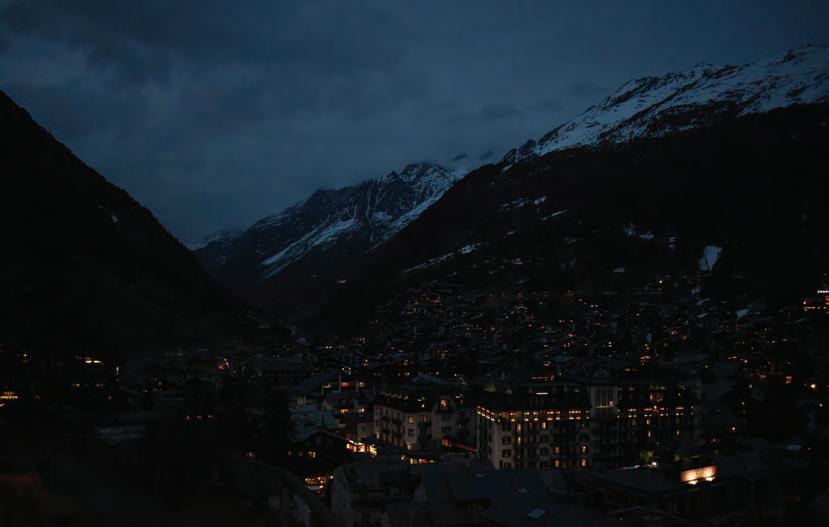
Cloudy Night, Zermatt, Switzerland [Will Russell]
rock and heavy metal played would become charming. The chalked sign above the bar displaying “rainbow shots” had always been intriguing. As I convinced Bethany and Ainsley to conquer them with Annette and me, we watched the bartender pour down the line of shot glasses and masterfully have each come out a different color. It was magic. With our stomachs filled with whatever was in the rainbow shots, the night ran away from us but the memories made at Sally Longs prevailed. It’s a bar that our trusty Irish guide, John Brady, went to in adolescence because they would serve him underage, a bar that I’m sure we’re the first HWS students to find.
Through the haze of the night, we made a pact with one another that whatever we got up to and no matter the conditions outside the next morning, we would make it to the Saturday Market. So, waking up with a headache and still in last night’s makeup, I texted Annette and Bethany and told them I was ready to go. In full rain gear, we walked downtown, reminiscing about all the funny things that happened the night prior. The blaring heavy metal, the body odor fragrance of the place, the cigarette smoke, and how we never
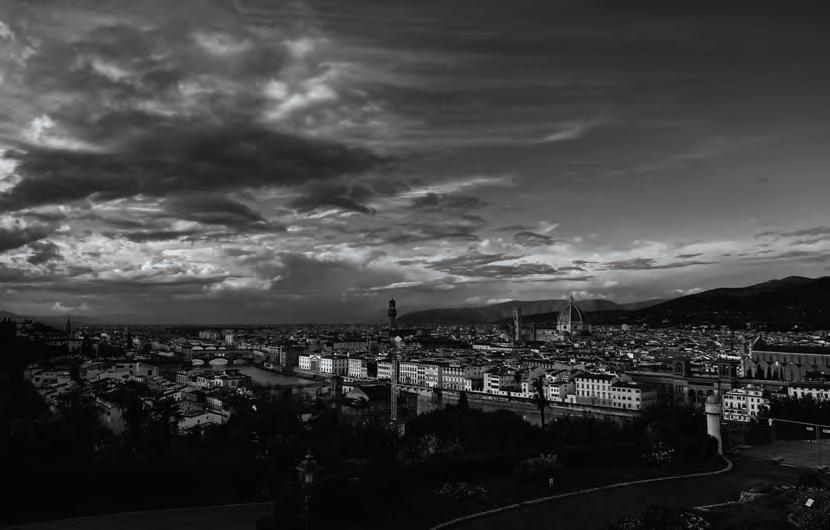 View from Piazzale Michelangelo, Florence, Italy [Jacob Newman]
View from Piazzale Michelangelo, Florence, Italy [Jacob Newman]
Graffitied Street, Melbourne, Australia [Cayden Smith]

managed to meet up with the rest of the group. We finally arrived at the market with the intention to try all the food we could muster, sad to see no Sausage Man or Donut Man in sight; the downpouring rain may have scared them away. Each of us got a bagel, satisfying our hangover cravings with a US staple. Bethany got colorful falafel and ate it until it was too soggy to be good. Annette got a pastry to satisfy her sweet tooth that always seems to follow something savory. “Guys, you know what would hit? Gelato.” Gino’s gelato is the best I’ve had, even better than when I went to Florence. We decided to have milkshakes and bring them to our favorite bookstore, Charlie Byrne’s, where we would pick new, enticing romance novels to read while hiding from the rain the rest of the day. The book-covered walls were a lot for my indecisive mind, but, with my milkshake in hand, I picked out Malibu Rising by Taylor Jenkins Reid.
Walking back with our hoods on and quickening our pace while being chased by the rain, our laughter never subsided. I told Annette and Bethany what Tadhg said to me the day prior and how, even on a day like today, when the streets are flooding, I still fall in love with our newfound home. Every time I travel, I find myself saying I can’t wait to go “home.” Not to New Hampshire, but to the streets of Galway and the haze of smoke in our Gort apartment. Something that I’ve learned from my roommate and days like this is that you can’t depend on the weather for your happiness. You have to create it. You could let it dictate your day, or your life, or you could force yourself up.
When I woke up the next morning and the sun was shining through the window, I noticed how much the rain had watered the grass and forced it to grow longer and exhibit its vivid color. I was sure the sun couldn’t bring the same character the rain exuded the day prior.
- Ella Weiss
a journal of global perspectives 131
Arriving in Spain
It was the first time I had ever travelled alone. I’d been out of the country before, but I’ve always travelled with my brother and my mom, so this was new for me. I did not sleep at all the night before - part of this had to do with me packing at the last minute, but my nerves just wouldn’t let me sleep. That morning was very hectic as family members wanted to see me one last time and grab breakfast or lunch before I left for the airport that night. In true Peruvian fashion, we went to a Peruvian restaurant. The goodbye was bittersweet as I was definitely excited for this once-ina-lifetime experience, but also nervously imagining every little thing that could go wrong, either on the drive there or at the airport. Everyone in my family congratulated me and wished me the best. We had talked about it all summer and I just couldn’t believe it was already time for me to leave. I’m the first in my family to go to college and, therefore, to go abroad for a semester. On top of that, I’m the first to go to Europe, so it was a big deal for everyone. I just didn’t want to let anyone down, especially my parents.

Moments II
Ceramic Balusters in the Plaza de España, Seville, Spain [Abel Guzman]
Luckily, the flight there was very smooth. I was able to sit next to two HWS students that I already knew and I slept almost the entire time. An eight-hour flight was nothing new to me as it was the same flight time to Lima, Peru, a trip that I have done many times. At 8:30am, we finally landed in Madrid and it still didn’t feel real that this was going to be my life for the next three months. All of the HWS students walked to baggage claim and, after two hours of trying to figure out where we had to go, we found a place in the airport to eat something and were able to meet other students from different universities that were also part of our program.
Eventually, it was time to board the bus that would take us to our hotel. We were greeted by Juan, one of the API coordinators, and he took us to our coach bus, which was definitely a hike! I’m 4’10” and walking with my carry-on rolling luggage, my backpack, and my checked bag was challenging. The inclined moving walkways did not make this any easier as I had to make sure that I planted my feet well so I didn’t fall forward. We had a 30-minute drive to our hotel, followed by a 10-minute walk because the bus wasn’t allowed to go any further into the area where our hotel was by the Plaza Mayor.
After arriving at the Hotel Moderno, we had some time off before our first meeting with the API coordinators and were advised to check out the area and get some rest. I’d never experienced jet lag like I did once I arrived in Madrid, but it made sense as we were six hours ahead. The only other place that I had travelled outside of the US was Peru, which is only one hour behind. Many of my peers suggested that I stay up as long as I could and maybe get a coffee to keep me awake even longer. Some of us went to eat at a café and walk around before we had to meet up with everyone else. I felt absolutely terrible and just wanted to sleep but knew I had to push through. I ordered a salad with goat cheese and or-
a journal of global perspectives 133
ange juice. Something that surprised me was the word that is used here for juice. While learning Spanish back in the US, they always taught us jugo, but in Spain they use zumo. The orange juice was all natural and freshly squeezed and reminded me of when I was a little girl in Peru and my Aunt Rosa would make my brother and me fresh orange juice.
When we were at the café, a woman overheard us speaking in Spanish and told us that she had moved to Spain about two weeks before. She used to teach Spanish in the US and quit her job because she enjoyed her time abroad as a college student so much that she wanted to teach English in Spain. She was very sweet and explained that, for us to really practice our Spanish, we would have to find Spanish friends so that we were less inclined to speak English. She also taught us a trick to say “thank you” more like a Spanish native as some letters are pronounced differently here.
For our program dinner that night, we were given various tapas from Spain. I remember learning about tapas in my Spanish classes growing up but never really understood what they were as they aren’t common in American or Peruvian cuisine. I love the ideas of tapas, though, and how, when a group of us go out, we can try various dishes. We were given croquettas, tortilla de patatas, pollo con patatas, a mushroom and egg scramble, and, lastly, pieces of fruit on skewers with chocolate drizzled on top for dessert.
It was nice to get to know the other students in our group that weren’t from HWS. I met another native Spanish speaker named Frida who was born in Mexico and had immigrated to the US when she was 14 years old. It was nice to be able to relate to someone who had a Latin American dialect of Spanish as she understood certain terms that I used that are not as common in the Spanish dialect. For example, there are so many different ways that people say the word “straw” and I almost never say the term used in Peru
134
Aleph
The
unless I’m in a Peruvian restaurant or with family. I also keep forgetting the term that is used in Spain and I just end up saying it in English or doing charades as I don’t want to get laughed at or say something that can be taken out of context. That is another thing: there are words in certain Latin American countries that can mean one thing and are totally harmless but can have vulgar meanings in other countries. Getting used to new terms is an adjustment, but I’m trying; sometimes they just come out on their own.
- Camila Garcia
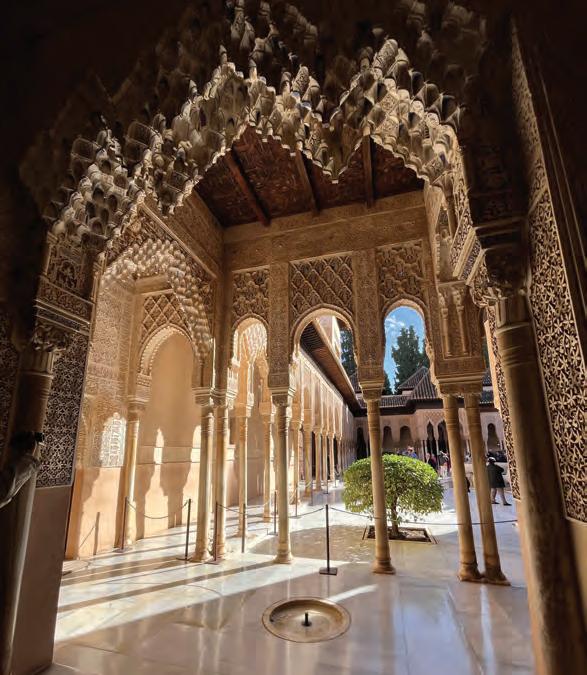
a journal of global perspectives 135
The Alhambra from the Inside, Granada, Spain [Thao Bui]
Shoah Reflection
No amount of studying or reading up on history can truly brace you for the solemnity of stepping into a concentration camp, or, in German, Konzentrationslager. The first thing that strikes you is the stark openness of the physical grounds. It makes you question how visible these camps were to the public during the war. Unlike places like Treblinka, concealed deep within the woods, some camps, such as Auschwitz or Majdanek, sit in proximity to residential areas. It’s hard to fathom that the local communities didn’t know.
Then there’s the unexpected sight of grassy fields within some camps. Auschwitz, for instance, had a ground once covered in mud and filth, devoid of any vegetation. One must wonder whether the perpetrators also deliberately made the victims’ surroundings as uncomfortable and unsightly as possible. It’s a curious detail worth noting.
As you step into the barracks, your perspective doesn’t immediately shift. Despite mentally preparing for the worst, you find yourself in a cool, dry room with the unmistakable scent of stone and wood. The emotional connection to the enormity of the Shoah, the catastrophic loss, is left to your own imagination. The consistent smell across most camps becomes a poignant trigger for sorrow and despair, resonating with those who can mourn and empathize with the victims.
This marks my initial reflection on The March: Bearing Witness to Hope 2023 trip. The experience is so profound that I anticipate a series of reflections in the coming days. It has been a journey filled with rewards and humility, yet shadowed by somber undertones.
136 The Aleph
Moments III
Note From the Author: The term Holocaust, derived from the Greek word for “sacrifice by fire,” is used less frequently in academic circles. Instead, the term Shoah, meaning “catastrophe” in Hebrew, is preferred as it acknowledges that those who perished were not sacrificed, but murdered.
- Cameron Guan
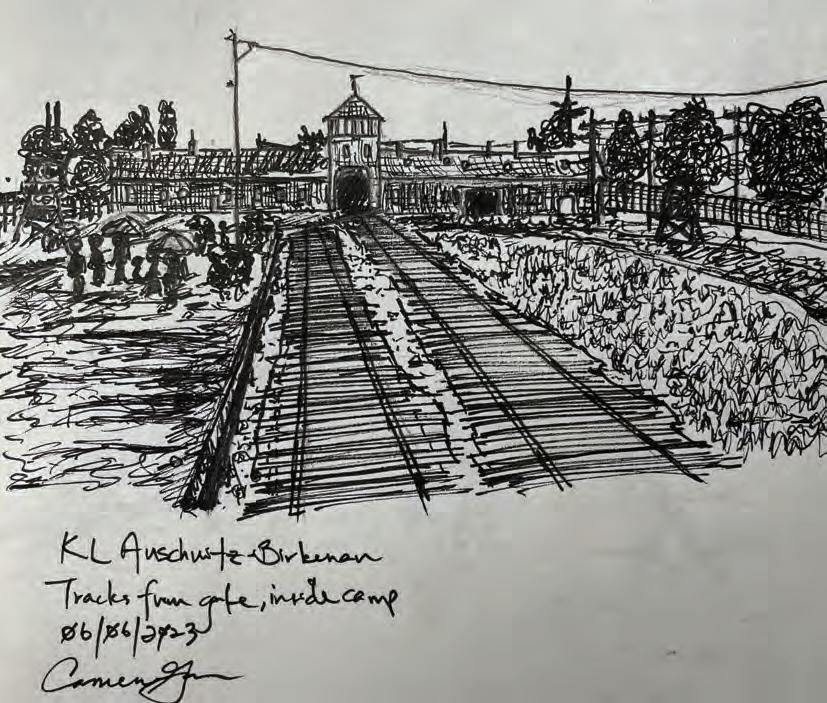
a journal of global perspectives 137
Railroad Spur, Auschwitz II-Birkenau, Oświęcim, Poland [Cameron Guan]
This morning, we had rice, curried potatoes, hard-boiled eggs, and hot black tea with sugar for breakfast. Though the potatoes weren’t as spicy as the chicken we’d had the night before, the depth of flavor was still there in a way I find hard to put into words. In every meal I had in Sikkim, there was a balance I’d never tasted before. Between the spicy and the acidic and the savory and the creamy, a musical harmony emerges with no note played so loud as to drown out the others.
After breakfast, we were taken around the inside of the Makaibari processing facility (the first tea estate in India, and a wholly organic operation), where all the tea plucked from the tea bushes was dried, fermented, and sorted. Though our guides were men, it was women who were doing the labor: laying out the tea to dry, working the machin-
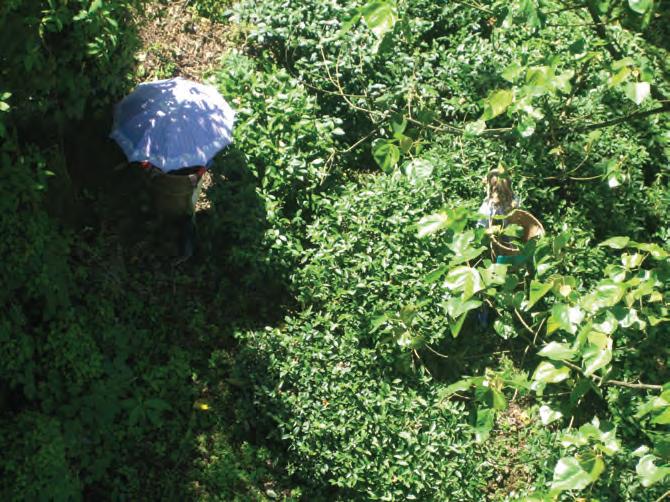
138 The Aleph From My Journal MAY 30
Makaibari Tea Estate, Kurseong, West Bengal, India [Aiden Greiff]
ery to crush the leaves to ferment them, moving trays from machine to machine, and hand-sorting the final product. Almost every variety of tea produced on Makaibari Estates is made from the same type of bush, varying in flavor and color due to the amount of time spent at each station in the processing facility. The length of time the leaves are left to ferment, the size of the dried leaf included in the final product, and the time of year the tea had been plucked all contribute to distinguishable flavor differences. The tea produced here was not the tea we’d been served by our host family, however. Over dinner that night, they told us that they could not afford the tea produced at Makaibari and sold in Darjeeling, grown just a few meters away from their house.
After touring the factory, we prepared to visit the tea gardens themselves. Despite how excruciating the inclines were, how damp the hot air was, and how sore my body felt during and after, it was an awesome hike - I was full of awe. The tea bushes were interrupted by trees here and there, creating the illusion of a mangrove forest or a swamp. When the path finally wound into a forest, the disparity in height became more apparent, and we were greeted simultaneously by roots on our left and treetops on our right. We passed a few groups of women plucking the tea in the fields, but only one was close enough to hear our guide’s call. When a few of us asked what the woman had said in response to him, he informed us that they’d been commenting on how difficult we would find it to walk up and down the paths - they were not joking.
When we got back from the hike, I spent some time playing games with Aiden and three little girls who lived in one of the houses nearest to the path. As I’d walked down to Aiden’s homestay to give him back his camera, they’d called to me from their porch, “Hello foreigner!” and ran down to follow me. We played coin spin and bottle flip for over an
a journal of global perspectives 139
hour (I lost both games), and they taught us words in Nepali and Bengali. They also asked me to teach them a dance, but were gravely disappointed by my lack of skill. By the time Aiden and I left for the tea tasting, we were like old friends.
After the tasting was momo-making. My homestay family’s daughter and her new husband had come to join us, and Ashripa (the daughter, only four years older than me) taught me the technicalities of each step. She allowed me to help her prepare each ingredient, and I made a record of the recipe (all parts - the dough, filling, and chutney). As she showed me how to crush the red chilis, I felt my eyes burn and the back of my throat sting. We talked about our mutual love of writing poetry, our shared clumsiness, and the closeness of our respective families as we cooked. That was my favorite meal of the entire program - not only was it some of the best food I’d ever had, but the conversation and engagement with my family was more profound than any
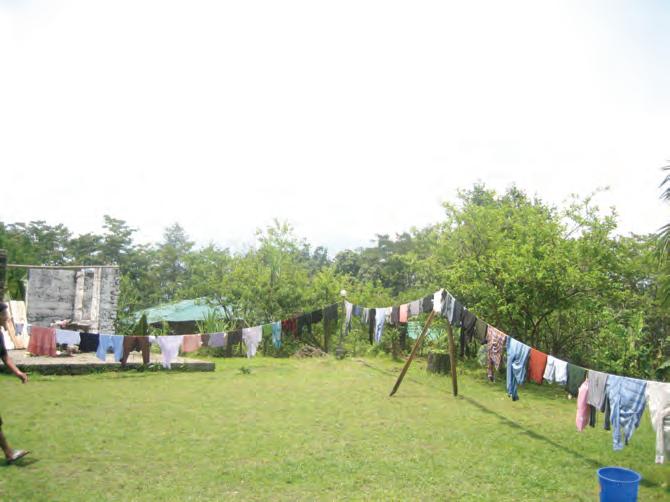
140
The Aleph
Yangsum Heritage Farm, Rinchenpong, Sikkim, India [Aiden Greiff]
other time in India. Over the course of several hours and several dozen momos, we shared whiskey and stories, language barrier aside. Communication came through body movements and laughs, and, as we sat around the table, we weren’t foreigners and locals, English-speakers and Nepaliand Bengali-speakers, but a gathering of humans, different in many ways, but the same in that we all understood the most basic of things: to be truly living is to share experience.
JUNE 4
This morning, we said goodbye to the farmstay in Rinchenpong, including Marcy and the dogs. I was not expecting to feel as heartsick over the loss of the routine of the past few days as I did. As we loaded the cars, Marcy called for me, “dīdī!,” “sister!,” and jumped into my arms for a final hug. Weeks later, when I got home, I had a dream that we’d all returned to the farmstay, this time bringing our families with us, and I’d seen Marcy again all grown up. She called me big sister still, and I slept on a bed I’d made of dirt, carved into the ground. Before Yangsum Heritage Farm, I’d thought our Kurseong homestay was, and would continue to be, my favorite homestay - the most welcoming, the prettiest. Though that stay is still a highlight for me, the farm was where I found myself enchanted by India. When I smell the conditioner, the deodorant, the laundry sheets I used in India, the first place I see in my mind is the big yard with the table where we had tea, where our clothes were hung out to dry, and where Paige got her first leech.
The view during our drive from Rinchenpong to Pelling had my eyes, as usual, glued to the window. Before arriving at our third homestay, we stopped and visited the Rabdentse ruins and the Pemayangtse monastery. The hike to the ruins was lush and the air was heavy. I’d used the restroom when we first got out of the jeeps and found a large sign
a journal of global perspectives 141
detailing the markers of “Deadly & Dangerous,” “Toxic & Poisonous,” and “Low-Risk” spiders in the area. I immediately took a picture of each part of the sign - I have always had a deep fear of spiders.
Our guide for the day was Thendup and Pema’s daughter. She led the way through the ruins, telling us the story of the old capital of Sikkim. From what had once been the throne room, we could see the Pemayangtse monastery perched on a hill, as well as the peaks of Mt. Kanchenjunga slipping through the clouds. As we arrived in the parking area, we could already hear the sounds of music drifting from the upper floors. When we reached the source of the music, I saw monks of all ages beating drums, blowing into horns, and chanting. Ascending to the next floor, we were presented with the most exquisite piece of art I’ve ever seen: a three-dimensional, mixed-media rendition of the stages of enlightenment. The sculpture had intricate beadwork and figures, woodwork and complex painted scenes. We weren’t allowed to take pictures inside the monastery, so I stood in front of it, circled it, memorized every bit of it until I was confident I could call up the image in my mind when I was no longer in front of it.
In the next room, there was a calendar on the wall that described a Buddhist parable of the partridge, the elephant, and the monkey. They lived without deference to one another, and, in order to determine what the hierarchy of respect should be, they decided to figure out who was the oldest. After discussing their oldest memories of the tree they sat under, they recognized the partridge to be the eldest. Through their creation of this system, they finally shared a “common life.”
This term, “common life,” rang in my head. The awareness of the interconnectedness between all living things appears at the core of Buddhist practice, mirrored by the pro-
142 The Aleph
gressive and protective environmental policies in Sikkim, which are further influenced by the animistic religious practices of people in this region. In this way, religious beliefs, practices, and a sense of responsibility for the natural world are infinitely intertwined. As we walked to lunch, I asked Thendup’s daughter what her beliefs were. She responded promptly: “I believe in worshiping nature. I don’t believe in gods, I believe in nature.”
JUNE 5→6
When we arrived in Yuksom this afternoon, I could barely keep my eyes open. I stayed back from lunch and lay on the roof of my homestay, reading. There is a relevant passage in Paulo Coelho’s book The Winner Stands Alone that I coincidentally read that day:
“How can we be so arrogant? The planet is, was, and always will be stronger than us. We
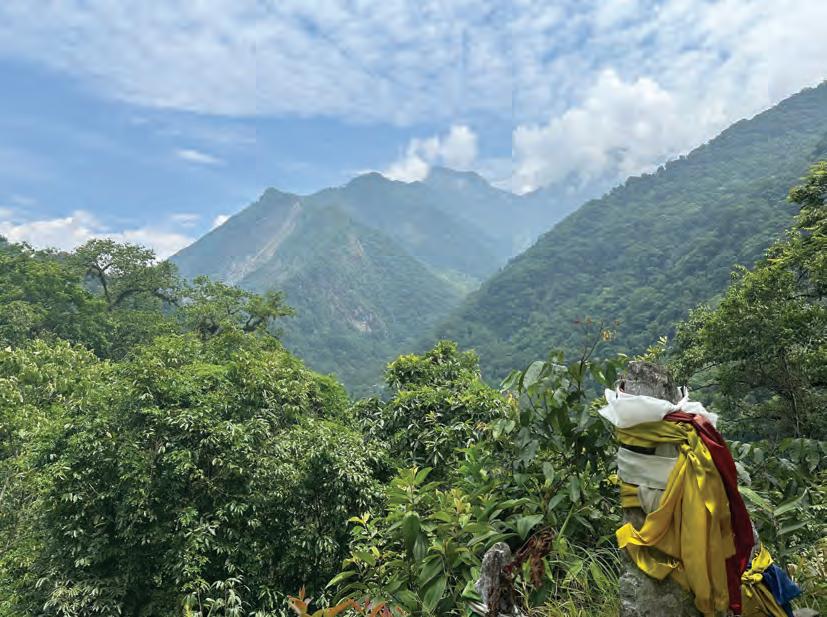 Lepcha Site Overlook, Dzongu, Sikkim, India [Anna O’Neil]
Lepcha Site Overlook, Dzongu, Sikkim, India [Anna O’Neil]
can’t destroy it; if we overstep the mark, the planet will simply erase us from its surface and carry on existing. Why don’t they start talking about not letting the planet destroy us? Because ‘saving the planet’ gives a sense of power, action, and nobility. Whereas ‘not letting the planet destroy us’ might lead to feelings of despair and impotence, and to a realization of just how limited our capabilities are.”
Coelho is right. Maybe if we understood our place in the natural world as part of the ecosystem as opposed to somehow above it, or in a position to control it, or in a different realm than that which is “natural,” we could more effectively cultivate the means to live sustainably in cooperation with our environment.
I rejoined the group later on, and we drove to the Kanchenjunga Conservation Committee headquarters. We learned about their homestay programs and zero-waste initiative, which has led to a trash collection and sorting project in which hikers must enter the park with a guide only after listing every item they plan to bring in and must return with all the waste they generate. The waste is then sorted into categories: reusable, recyclable, and hazardous. Some of the raw materials, including plastic, are reused and made into goods by the Women’s Self-Help Group, a constructive program recognized by the Indian government.
I have never heard dogs talk like the dogs in Yuksom do. I’ve seen, in movies, the way they can howl from farmhouse to farmhouse, apartment complex to apartment complex, communicating in a language humans can’t comprehend. As we fell asleep, and all through the night, they called to one another. I wondered what they talked about during
144 The Aleph
• • •
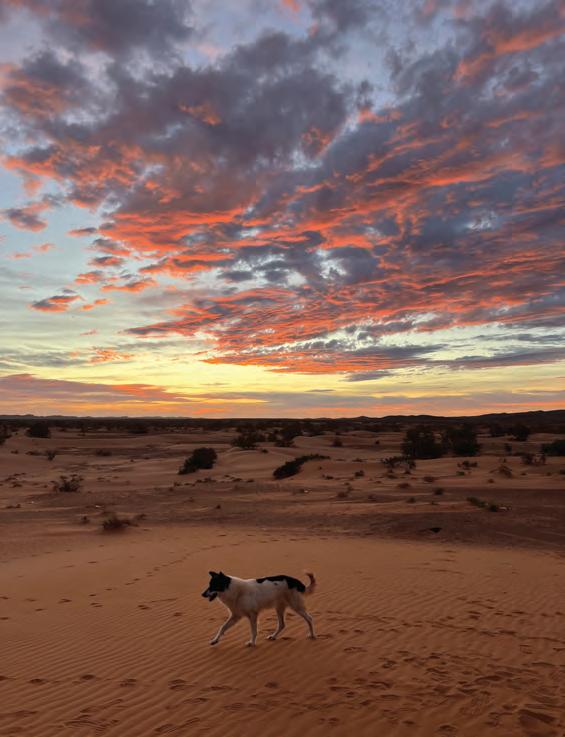
these long, ritualistic meetings. Were they sharing information about their days? The territory they occupy? Here, we’d seen dogs living on the street stroll confidently across the road, weaving their way through the cars and ignoring every person that was in their way - dogs on a mission, dogs with a life experience beyond that which was determined by a human counterpart. I wondered what this reflected about the impact of the human relationship to the environment and the role it plays in shaping our social dynamics on every scale.
This afternoon, we visited the Norbugang Coronation Throne. The same way the Pemayangtse monastery had been higher on the mountain than the ruins of the old palace - which, our guide explained, was symbolic of the fact
a journal of global perspectives 145
Sunrise in the Sahara Desert, Morocco [Isabella Renzi]
that the monks were more powerful than anyone royalthe three seats the monks held were built higher than the throne for the king, though they were all built as one connected structure.
As most of the group headed out for a short hike, some of us opted to visit the smaller monastery closer to the site of the coronation throne. We struck up a conversation with another group and learned they were domestic tourists,
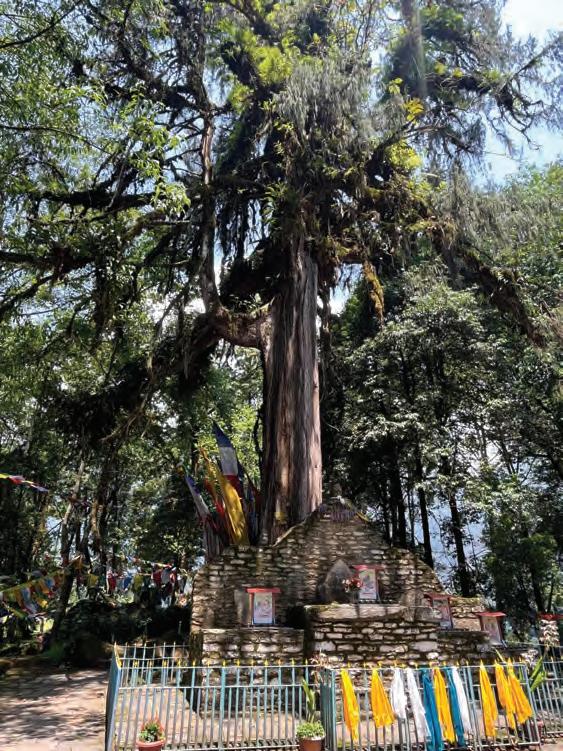
146 The
Aleph
Norbugang Coronation Throne, Sikkim, India [Paige Humphrey]
except one woman’s son, who had moved to America a few years ago. One of the women asked to take a picture with us and, once done, hugged us goodbye, murmuring “I love you!” to each of us in turn.
JUNE 11
Last night, I walked to the soccer field Su had told us about. Aiden was already there, playing soccer with a group of men, some of whom looked around our age and some much older. I knew I couldn’t keep up, but I still wanted to engage, so I edged my way to what appeared to be stone bleachers. On them, about halfway up, sat a little boy in a yellow shirt that buttoned diagonally across his chest. The buttons and his shorts were red, and his hair was cropped. Some of the older boys on the field wore the same garments and had the same haircut - a familiar one, which we’d seen at every monastery we’d visited. Later, Su explained that there was a small monastery right behind the field, and all the boys wearing the uniform were monks in school there. The boys got one Sunday off each month, and today was that day. I sat next to the little boy, and we smiled at each other.
We watched the game in silence for a little while, until I noticed there was a second soccer ball next to him. I reached over and tapped the ball, then pointed to myself and him in turn. I watched his eyes light up and he nodded. We walked to the tangled ground at the corner of the field and began our game, hesitant at first but growing more competitive with each pass. Soon we were both sweaty and laughing, neither of us aiming well nor able to control the strength with which we kicked. Sometimes, the ball rolled into the larger game being played. Each time, I braced myself for annoyed looks from the older men, exasperated by our lesser abilities, our repeated interruptions. Each time, I was surprised and relieved when they merely passed the ball back, grinning at our two-person soccer match. The
a journal of global perspectives 147
game was not one of competition, though there were opposing teams. It was a game of cooperation, and there was respect given based on nothing more than a willingness to engage, as opposed to skill or aggression. I’d never played soccer like that. When the larger game was over, everyone gathered together, urging the boy and me to join. The losing team got on all fours on the ground and the winners sat on top of their backs, fanning themselves and wiping their foreheads on their shirts. Everyone spoke a mix of Lepcha, Nepali, and English, but the language barrier was no obstacle. I watched them tease Aiden, and they asked us questions about our program before Su and the rest of the soccer players led us back toward our homestay.
Today, we hiked to Mr. Lepcha’s native village. Once the cars dropped us off, Su led us up a path with ferns and vines reaching over the edges of the stone steps. We walked along ridges with spectacular views of rice paddies and past passion fruit trees, and Su pointed out various plants that were edible or medicinal - at one point, he showed us small ferns that he picked to cook for our dinner. There was a type of mint that helps clot blood, stems with fibers strong enough to weave into baskets, and avocados growing above us. Every home had a garden and a dog (or two), sometimes chickens, and usually a chair on the porch or the ground in front of the house. Mr. Lepcha explained later that, when there are celebrations involving food, each family is assigned something to contribute, and someone will spend the day driving up the mountain, collecting the produce and dishes from each home.
At one point, my back hurt so badly that I had to pause while the rest of the group went ahead. Awa stayed back with me, and we sat on two rocks under the steady heat of the sun. Where we rested, there was a clear view of the mountain peak opposite ours, and we saw houses clustered in a clearing higher than we were. Orchids bloomed along
148 The Aleph
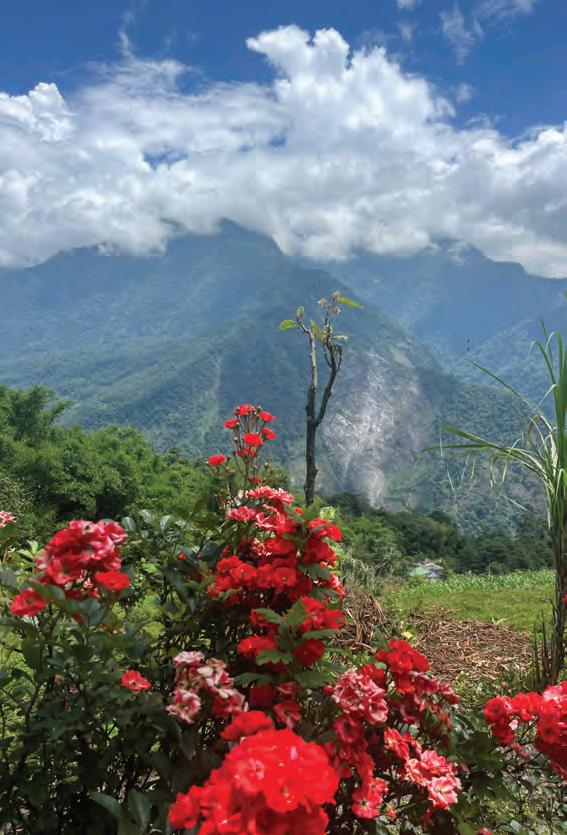
the treeline, and the sun cast a defined ray through the clouds into the valley. I have never been anywhere more exquisite. It’s no surprise that those who have experienced such profound beauty in their surroundings, such biodiversity, such rich color and fragrant air, have such a passionate drive for protecting the environment from those determined to drain it of every resource.
- Cecelia Ripley
a journal of global perspectives 149
Himalayan Foothills, Dzongu, Sikkim, India [Paige Humphrey]
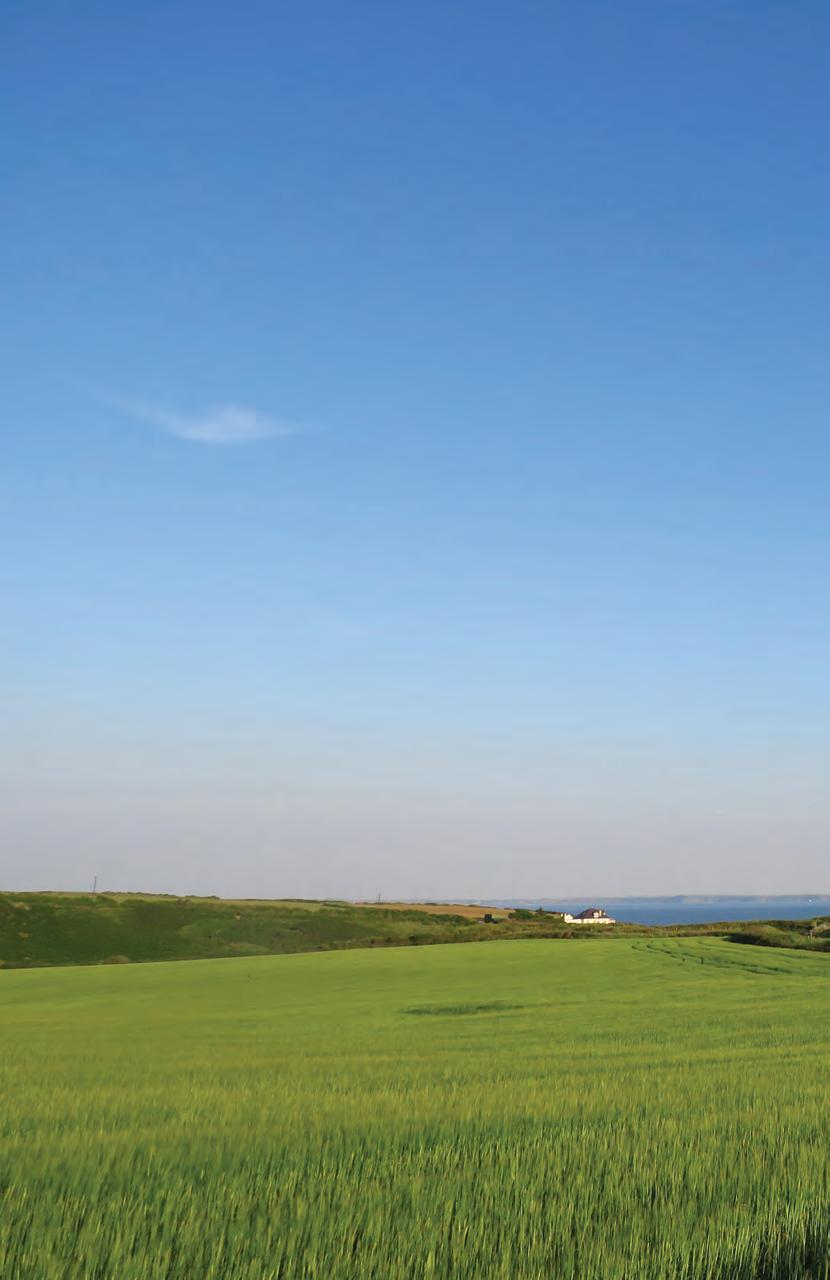
SURROUNDINGS
n. 1. the circumstances, conditions, or physical setting in which one finds oneself
2. the atmosphere or environment of a location
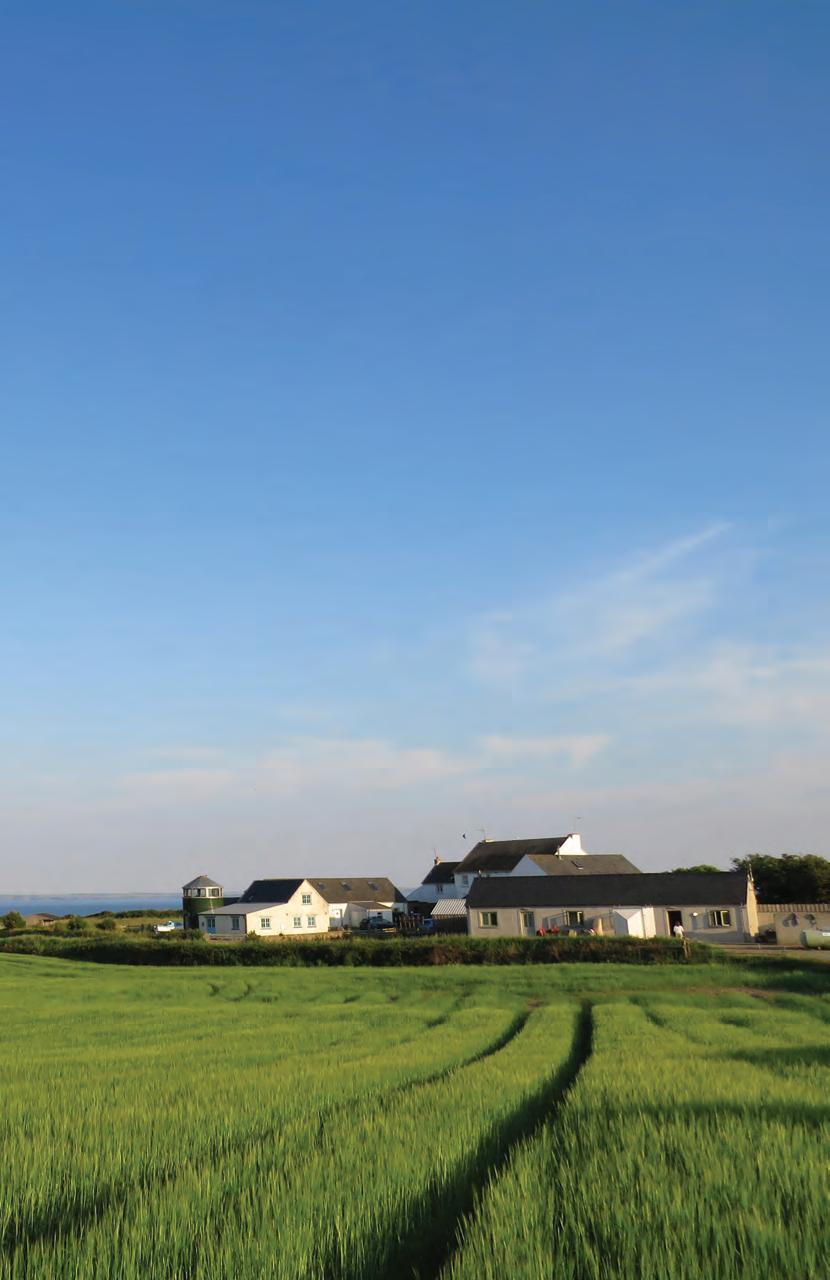 The Chef’s Field, St. David’s, Wales [Jordan Britton]
The Chef’s Field, St. David’s, Wales [Jordan Britton]
Schlossberg and Nature in Freiburg
My first 15 days in Freiburg have convinced me that I would gladly spend the rest of my life here. In the first few days of orientation week, Karin from IES introduced us to the concept of “Wellness Walks.” Starting from the first Wednesday, IES takes students on weekly walks that help us destress, detox, and feel connected to nature and each other. On our first Wellness Walk, we went to Schlossberg, which means “Castle Mountain” in English.
One of the main reasons I came to Freiburg was the abundance of forests and mountains. As soon as you leave the city, you are in the Black Forest, which is exactly where we went on our Wellness Walk. Although the Schloss (castle) wasn’t nearly as impressive as other castles in Germany, the views from the Berg (mountain) were breathtaking. After a short but steep hike, we got to a flat viewpoint. That is when I fell in love with Freiburg for the first time. I could see the entire city from there. Nestled within tall, grassy mountains, the narrow city stretched into the valley. I could see many vineyards, some of them on the Schlossberg itself. In the distance, I could see the tallest building in the city, the Münster (a historic cathedral). Karin told us that the government does not allow anyone to construct buildings taller than the Münster in order to preserve the beauty and “old-town look” of the city.
152 The Aleph SURROUNDINGS I
I found this fascinating. Having grown up in New Delhi, India and then moving to the US, I am used to seeing cities with skyscrapers. I enjoy the lively and active atmosphere of cities and the natural beauty of the countryside, and Freiburg offers the best of both worlds! I never thought it would be possible to access forests and mountains in an urban setting. Back home, I would have to drive several hours just to go on a hike. In Freiburg, however, the Black Forest is just a few minutes away. Although it is a city of almost 250,000 people, it looks nothing like the typical industrialized American city.
It is amazing to me that Freiburg and other cities in Europe are beautiful and lively at the same time; I think it sets the perfect example for urban planning in other countries. Looking at Freiburg peacefully situated in the valley, I was able to understand why it is called “The Green City.”
- Tarang Malhotra

Atop Schlossberg, Freiburg, Germany [Tarang Malhotra]
Middle Street
There is not usually much hustle and bustle in Galway. Shop Street, Galway’s main shopping district, has room to move no matter the time of day; there aren’t lines for restaurants and groups can walk with no issue. Growing up in New York City, this felt odd to me when I first arrived here in Galway. After weeks of getting acclimated to this new city I call “home” when I’m not there, it has felt busier and busier. I walk down Shop Street and the same number of people who were there on the first day feels like it has been multiplied by two or three. Shop Street is now Time Square, it’s Broadway; it feels like I’m back in New York City again. The buildings, only three stories maximum, stretch upwards, scraping the overcast sky, tearing a hole in the cloud cover, and letting the sunlight through.
There have been moments where I have wanted to find that feeling I had during the first few days of being here, looking around and having everything feel so quaint and small compared to what I had known. My perspective has shifted, and nothing about Galway feels quaint anymore; it feels like a real city (something many would argue against). I had been on my own walking around Galway in the beginning of February when I first took a right off Shop Street at the corner near Front Door and Buskers, the student bars that are two of the few places which do, in fact, have lines spilling out of them on weekends. I had spare time and felt like I needed to see the rest of Galway. Just a couple of yards down and to the left, I found the street that I had been looking for, and it had been there this whole time, right out back of the Kings Head Bistro. I saw it from my chair at the bar many times through the rickety, wooden double doors. Middle Street, aptly named for, well, being in the middle of St. Augustine Street and Shop Street (technically known as High Street), feels like what a “middle street” should be. Only 656 feet long, it is just 233 steps from one end to the
154 The Aleph Surroundings II
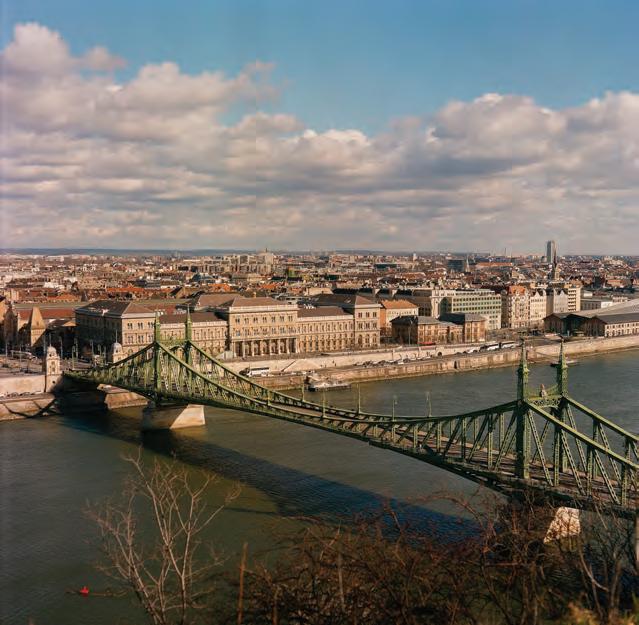
other (depending on your stride). It’s quiet, the stores are smaller, the foot traffic is low, and the buildings create a narrow passage. It is the perfect retreat from Galway’s ohso-hectic High Street. I have broken it up into three sections, and, in my mind, for good reason.
The first third of Middle Street when walking in the direction of Eyre Square feels like the opening of a book, a portal to a new world. There are bars, a bookstore, Japanese food, tapas, a chocolate shop, and a café that sells records and t-shirts and has a loft which seems to lead to nowhere (I have yet to enter this café/retail store; it is somewhat intimidating and gives way to questions of how it is still in business as there are never any customers). I love this third; it is the retail section and pulls you in like the start of a good movie. There is so much going on for such a small
a journal of global perspectives 155
Corvinus University From Gellért Hill, Budapest, Hungary [Lucas Gillespie]
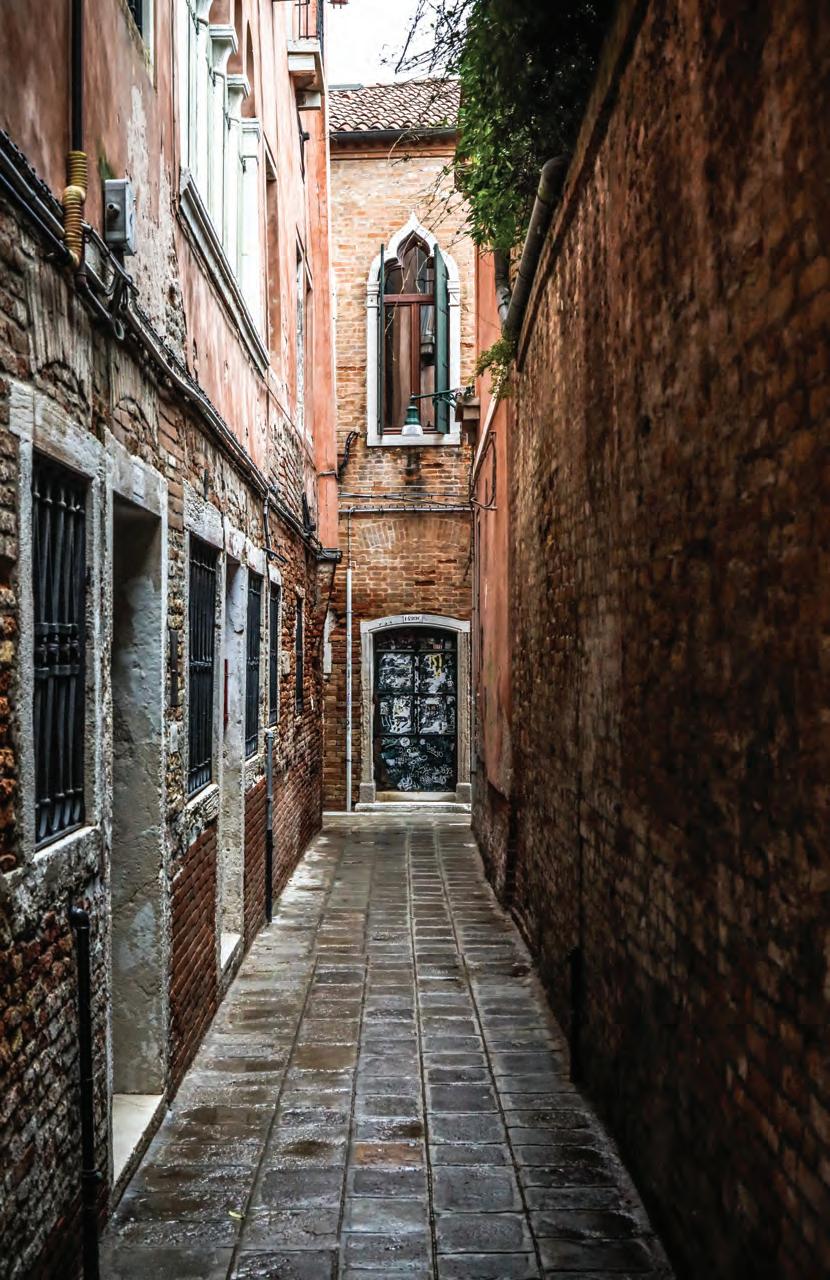 Narrow Venice, Italy [Alex Barnosky]
Narrow Venice, Italy [Alex Barnosky]
street, dizzying and full of culture, the transition from Shop Street to the refuge of Middle Street. The bookstore, Charlie Byrne’s, recommended by my friends for great secondhand books, seems to be the epicenter of the little foot traffic that exists on Middle Street. It’s the real deal when it comes to bookstores, or at least I think so. Charlie Byrne’s in itself is a portal to another world, but that’s for another day.
The middle third of the street is what I would characterize as perfectly quaint. Almost over the top in that sense, it is the epitome of a small European street. It’s what I had been looking for. This middle third is a dead zone for sound; everything seems to go quiet and soft in this section. At this point in my walk down the street, headphones are removed because they take away from the experience. The muted voices and noise from parallel streets create the perfect conditions for that feeling of calm and escape. It starts at Milano, the large sit-down pizza shop where there always seems to be too many tables inside, and ends at Buttermilk Walk, a tiny offshoot that connects to St. Augustine on the right. To the left is the back of the Kings Head Bistro, painted in glossy blood-red, the same color as their house ale. Just after the Kings Head Bistro off to the left is a small, maybe five-foot-wide corridor that connects Shop Street to Middle Street. It’s covered and feels like my own secret passage. If you need to get off Shop Street quickly, it’s the back alley to the quiet paradise that lies just behind. On either side, wet, gray stone buildings hug you, gothic and European when it rains, adorable and majestic in the very, very rare Irish sunshine. A few feet further is St. Augustine’s Catholic Parish. It’s always quiet around the church. There are no bars in this third, just a few restaurants and a small walkway ahead. It truly is the perfect spot to get away. This is what I think of when I think of Galway. I flew 3000 nautical miles to get away from the hustle and bustle of New York City, and Middle Street does that job pretty damn well.
a journal of global perspectives 157
The final third of the street begins its return to retail, restaurants, and cafés. Dough Bros pizza shop is on the corner, and a line usually spills out of the small doorway and stretches toward the left. Hair salons and mountain climbing and outdoors stores come back into view. The red brick pavers on the sidewalk are more well-maintained than they were in the middle section. Melted, the sandwich shop where my Irish housemate spends her mornings baking cookies and brownies to put behind the glass display, is on the right with two small, wrought-iron round tables outside. Their buffalo sauce, my roommate John claims, is “the real deal.” The sound fades back into the ears once you cross the border back into the real world of the final third. The hustle and bustle of Shop Street around the corner to the left filters through, with Irish trad music from street performers bouncing higher and higher off the old brick buildings. This is the transition zone back to the reality of Shop Street, tourists, commercial goods stores, souvenir stands, and “American bars.” In the short two minutes it takes to walk Middle Street, you enter your own world and take a much-needed breather from the day. Then, finally, the reintroduction to the daily life of a tourist “city” reminds you that your vacation is coming to an end.
Galway is very much its own city, unlike many other places in Ireland. It’s extremely colorful, centered around music and social gatherings, and is as coastal as it can get. Middle Street is no different. It is a perfect representation of what makes up the city. Colorful buildings, pubs, cafés, the sound of street music coming in and out, seagulls, the list goes on. No such street would exist in Dublin - it’s too big and the nooks and crannies are dull in color or too far outside of the city. Nor would it exist in Cork, where its version of “Shop Street” never really seems to end, and the adjacent streets are somehow home to yet another H&M. Middle Street is not a spectacle that wants to be viewed as perfect. It is, in its own right, “just another street,” overlooked by thousands of eyes every day, but this street in particular is
158 The Aleph
a slice of everything that Galway offers.
It feels weird knowing that a place like Galway’s Shop Street seems big to me now, that I need to find a place to retreat to when the noise gets too much, when classes get a bit hectic, or when I just get that feeling of needing to get up and walk, music in, no thoughts. What the hell is going to happen when I get back to New York City? Mental pandemonium is going to ensue, no doubt about it. Finding a retreat in your environment is important: I do it in New York City, I did it on the small streets of Lisbon off of the city center, I did it in Amsterdam on the canals, and I have done it now in Galway. Middle Street, I’m convinced, is the best part of Galway; it has everything I need in a 656-foot-long street. If you find yourself seeking that time away from the extreme busyness of Galway’s Shop Street, Middle Street is the place to go. But don’t go too often, I like it quiet.
- Griffin Reiner
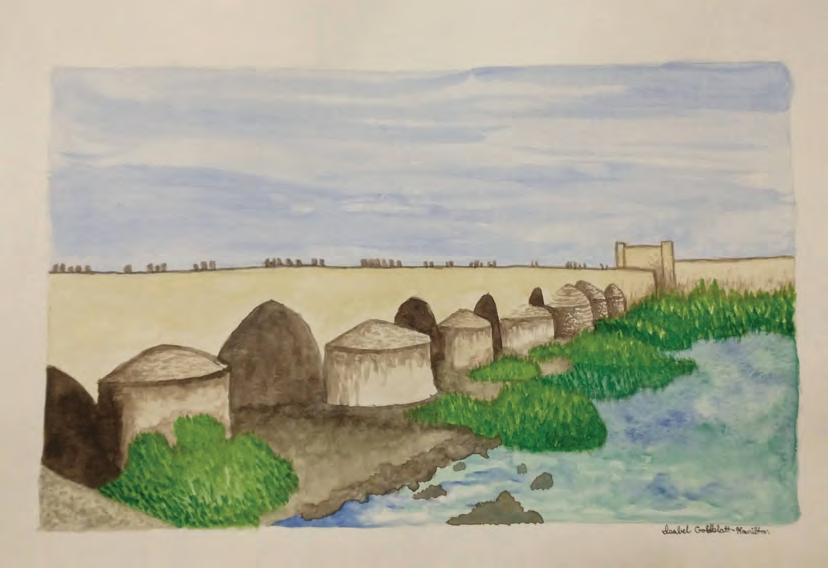
Puente Romano de Córdoba, Spain [Isabel Goldblatt-Hamilton]
The Scents and Sounds of Nairobi
“We travel, some of us forever, to seek other places, other lives, other souls.” - Anaïs Nin
I put this quote at the top of my travel journals to remind me why I travel: to experience other cultures and meet people with different backgrounds and livelihoods. My semester in Kenya did precisely that.
Stepping off the plane at Jomo Kenyatta International Airport, the air smelled fresh, and this scent only got better over time. It smelled cleaner than any other city I’ve ever been to. My eyes felt heavy after the 15-hour flight, but I was excited for the semester ahead. I knew this study

Surroundings III
Boats in Mombassa, Kenya [Mary Baillos]
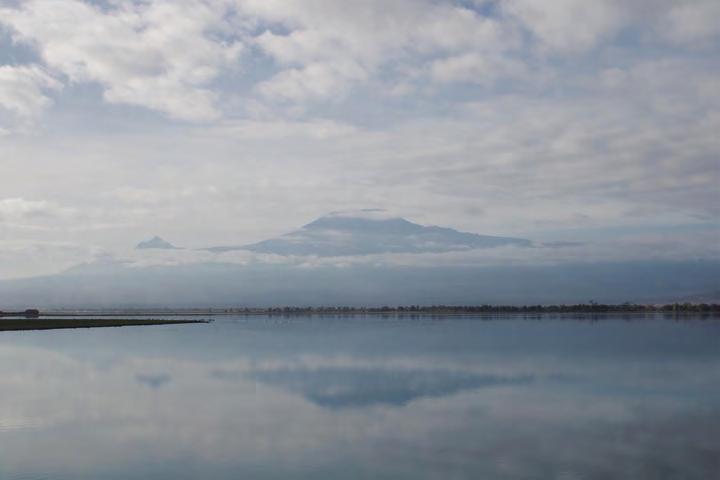
abroad experience would be different, but I didn’t realize how special it would be.
For seven weeks of the semester, I woke up in Karen, a suburb of Nairobi, where St. Lawrence University has a fiveand-a-half-acre campus. The mornings were spent in Swahili class, while we passed the afternoons playing volleyball or soccer. Students often congregated in the yard where monkeys were always stealing bananas.
The compound’s resident chef, Isaiah, created the most amazing meals. The aroma was always different. Some days, the scent of Indian-inspired spices was flowing through the house, while on others, good old American beef was cooking, reminding me of home.
Inland, we went on safari. The cool night breeze on my skin was like a gentle hug, and the elephants munching at night put me to sleep. I woke up to baboons outside my door. The wheels bumping against the uneven roads put me to sleep, too. I am still unsure how I fell asleep there, but it
a journal of global perspectives 161
Kilimanjaro in the Clouds, Amboseli National Park, Kenya [Mary Baillos]
was calming. Life moved slowly on safari and in Nairobi. It was a comforting change of pace.
The air was earthy on safari, complemented by the dark red dirt and beautiful fauna. When we were on the coast, it was salty, and the waves rolling in and out put me to sleep at night. The seaweed crunching under my feet reminded me of the beauty of nature, countering the chatter coming from the Kenyans on the beach. During the day, they sold bracelets and postcards to make money. They would hang out at night, making bonfires and watching the ocean.
Later in the semester, I completed an internship with USAID (the United States Agency for International Development) and lived in an apartment outside Nairobi’s central business district. Waking up to the sound of cars on the Nairobi Expressway reminded me that I was in one of the fastest-growing cities in the world. The air usually smelled of exhaust, but pockets of gardens and forests brought me back to nature. Walking through our little neighborhood at night, I could hear the highway and smell the street food around us. Although I never tried it, this food always smelled amazing.
The scents and sounds of Kenya are something I will never forget. I could seek other souls inside myself and through the people I met. The lessons they taught me have changed me. I see the world through a different lens. I hear the world through different ears. I smell the world through a different nose.
- Mary Baillos
The Aleph
162
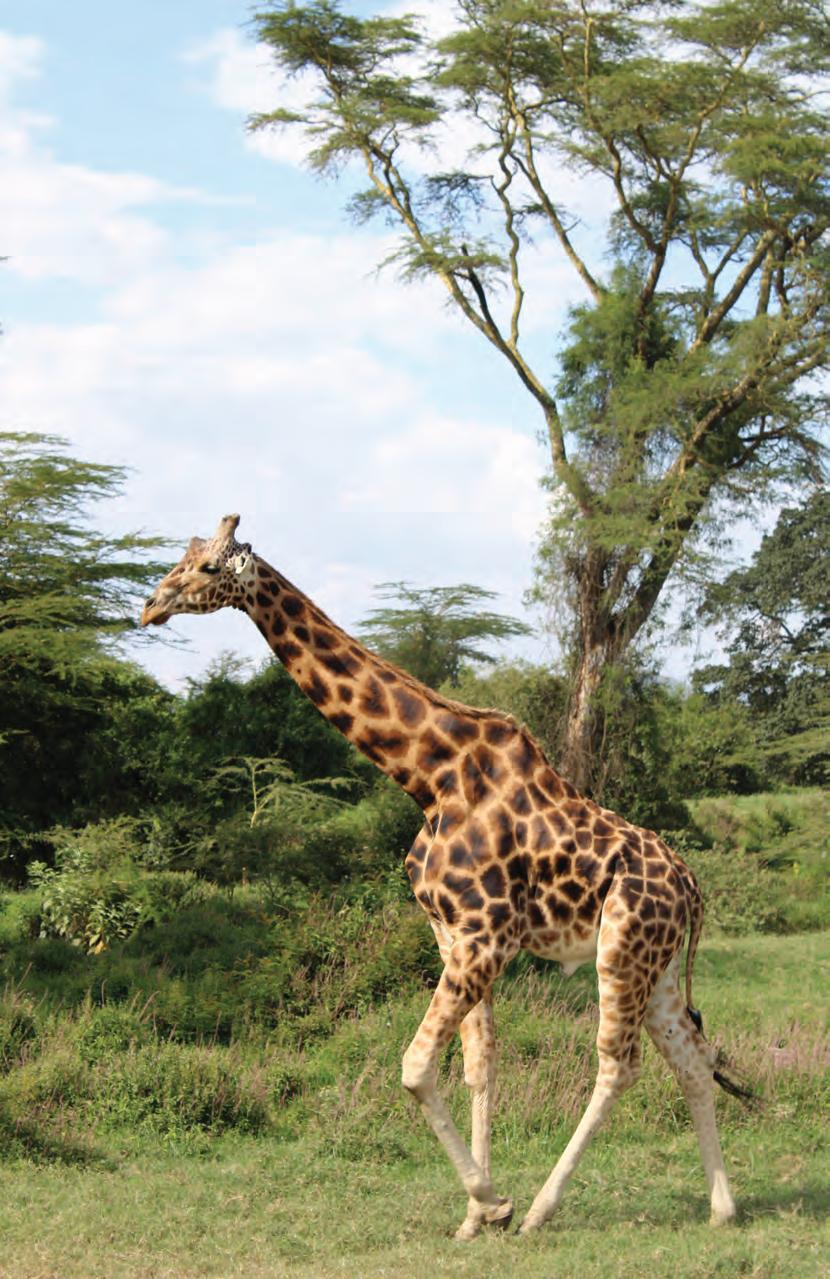 Giraffe, Lake Nakuru National Park, Kenya [Mary Baillos]
Giraffe, Lake Nakuru National Park, Kenya [Mary Baillos]

Secret Garden, Bath, England [Aaron Eddy]
Volume XVII, 2024
he
Aleph a journal of global perspectives T











 Leipziger Stadtfest, Leipzig, Germany [Will Russell]
Leipziger Stadtfest, Leipzig, Germany [Will Russell]


 Artist in Discussion with a Friend, Naples, Italy [Ryan Brady]
Artist in Discussion with a Friend, Naples, Italy [Ryan Brady]










 Tonight’s the Night, Cadair Idris, Wales [Jordan Britton]
Tonight’s the Night, Cadair Idris, Wales [Jordan Britton]
 Woman Watching, Rome, Italy [Alex Barnosky]
Woman Watching, Rome, Italy [Alex Barnosky]











 St. Michael and All Angels Church, Haworth, England [Katelyn Weeks]
St. Michael and All Angels Church, Haworth, England [Katelyn Weeks]

 The Windmill, Bamburgh Castle, England [Jacob Newman]
The Windmill, Bamburgh Castle, England [Jacob Newman]



 Dome of Santa Costanza, Rome, Italy Pen and Ink Sketches of Rome and Venice, Italy
Dome of Santa Costanza, Rome, Italy Pen and Ink Sketches of Rome and Venice, Italy

 Chiostro del Bramante, Rome, Italy
Pen and Ink Sketch of Milan, Italy
Chiostro del Bramante, Rome, Italy
Pen and Ink Sketch of Milan, Italy

 Proud Mary Lighthouse, Holyhead, Wales [Jordan Britton]
Proud Mary Lighthouse, Holyhead, Wales [Jordan Britton]

 Rice Fields in Gianyar, Bali, Indonesia [Cayden Smith]
Rice Fields in Gianyar, Bali, Indonesia [Cayden Smith]




 The Twelve Apostles from the Great Ocean Road, Victoria, Australia [Cayden Smith]
The Twelve Apostles from the Great Ocean Road, Victoria, Australia [Cayden Smith]






 Joy, Rome, Italy [Alex Barnosky]
Joy, Rome, Italy [Alex Barnosky]


 View from Above, Barcelona, Spain [Isabella Renzi]
View from Above, Barcelona, Spain [Isabella Renzi]

 Die S-Bahn, Leipzig, Germany [Will Russell] Roman Subway, Italy [Alex Barnosky]
Die S-Bahn, Leipzig, Germany [Will Russell] Roman Subway, Italy [Alex Barnosky]
 Cliffside Flight, Poliganano a Mare, Italy [Alberto García de la Puente Stanley]
Cliffside Flight, Poliganano a Mare, Italy [Alberto García de la Puente Stanley]
 Lighthouse on the Island of Cephalonia, Greece [Eastwood Yeboah]
Lighthouse on the Island of Cephalonia, Greece [Eastwood Yeboah]





 Tram Line 2 at Vigadó tér, Budapest, Hungary [Lucas Gillespie]
Boat Passing Under the Whitby Abby, Whitby, England [Jacob Newman]
Tram Line 2 at Vigadó tér, Budapest, Hungary [Lucas Gillespie]
Boat Passing Under the Whitby Abby, Whitby, England [Jacob Newman]
 Castel Sant’Angelo, Rome, Italy [Alex Barosky]
Castel Sant’Angelo, Rome, Italy [Alex Barosky]

 Sleepy Koala on Magnetic Island, Queensland, Australia [Cayden Smith]
Baby Monkey, Ben Smim Forest, Morocco [Isabella Renzi]
Sleepy Koala on Magnetic Island, Queensland, Australia [Cayden Smith]
Baby Monkey, Ben Smim Forest, Morocco [Isabella Renzi]

 Cows in Llanberis, Wales [Jordan Britton]
Small Bird in Monteverde Cloud Forest, Costa Rica [Karina Connolly]
Cows in Llanberis, Wales [Jordan Britton]
Small Bird in Monteverde Cloud Forest, Costa Rica [Karina Connolly]
 Intricate Plaster Work in the Alhambra, Granada, Spain [Paulina Tejada]
Intricate Plaster Work in the Alhambra, Granada, Spain [Paulina Tejada]




 View from the Top of the Giralda, Seville, Spain [Paulina Tejada]
View from the Top of the Giralda, Seville, Spain [Paulina Tejada]



 Sunset in Namsan, South Korea [Lexi Hansen]
Sunset in Namsan, South Korea [Lexi Hansen]
 Commissioned Artwork at the Community Recreational Center, Cape Town, South Africa [Eastwood Yeboah]
Commissioned Artwork at the Community Recreational Center, Cape Town, South Africa [Eastwood Yeboah]
 Berliner Fernsehturm, Germany
Berliner Fernsehturm, Germany



 Villa Balbiano, Lake Como, Italy
The Louvre, Paris, France
Villa Balbiano, Lake Como, Italy
The Louvre, Paris, France



 View from Piazzale Michelangelo, Florence, Italy [Jacob Newman]
View from Piazzale Michelangelo, Florence, Italy [Jacob Newman]






 Lepcha Site Overlook, Dzongu, Sikkim, India [Anna O’Neil]
Lepcha Site Overlook, Dzongu, Sikkim, India [Anna O’Neil]




 The Chef’s Field, St. David’s, Wales [Jordan Britton]
The Chef’s Field, St. David’s, Wales [Jordan Britton]


 Narrow Venice, Italy [Alex Barnosky]
Narrow Venice, Italy [Alex Barnosky]



 Giraffe, Lake Nakuru National Park, Kenya [Mary Baillos]
Giraffe, Lake Nakuru National Park, Kenya [Mary Baillos]
